- Marine Supplies
- Maintenance & Boating Guides

Catamaran vs Monohull: Pros, Cons & Main Differences
By: B.J. Porter Editor

The choice of catamaran vs monohull ultimately comes down to preference. What’s critical for one buyer may mean little to another. If your partner refuses to set foot on a boat which heels, that’s a deal-breaker for a monohull. But if you’re passionate about classic looks and styling, your quest for beauty may override other considerations and rule out catamarans.
We can’t tell you whether a catamaran or a monohull is right for you. But we can help you with the pros and cons of each for your search.
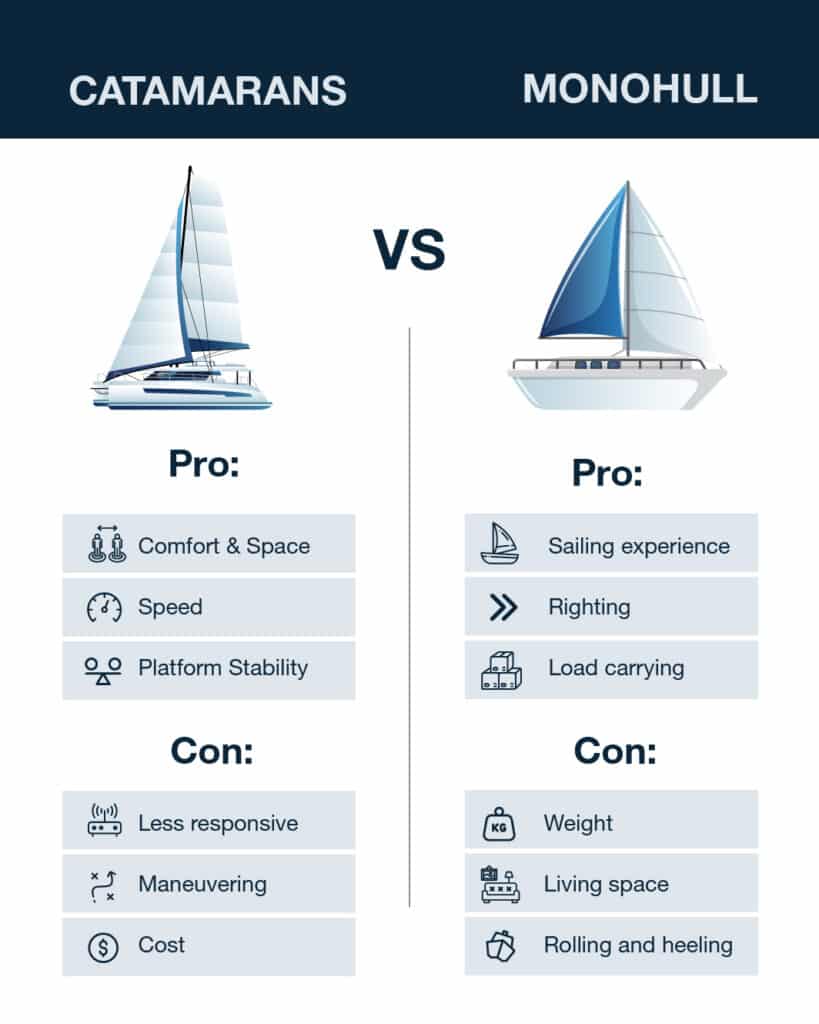
The Strengths and Pros
No matter your choice of monohull or catamaran, there are safe, comfortable, and excellent sailing boats of both types. Neither has an exclusive lock on any strength, and both sail safely and comfortably. But there’s a different emphasis on how they do it. No matter what you are trying to do – sail fast, cruise the world, or just host a crowd at the dock, there are monohulls and catamarans that can work for any requirement.
Catamaran advantages
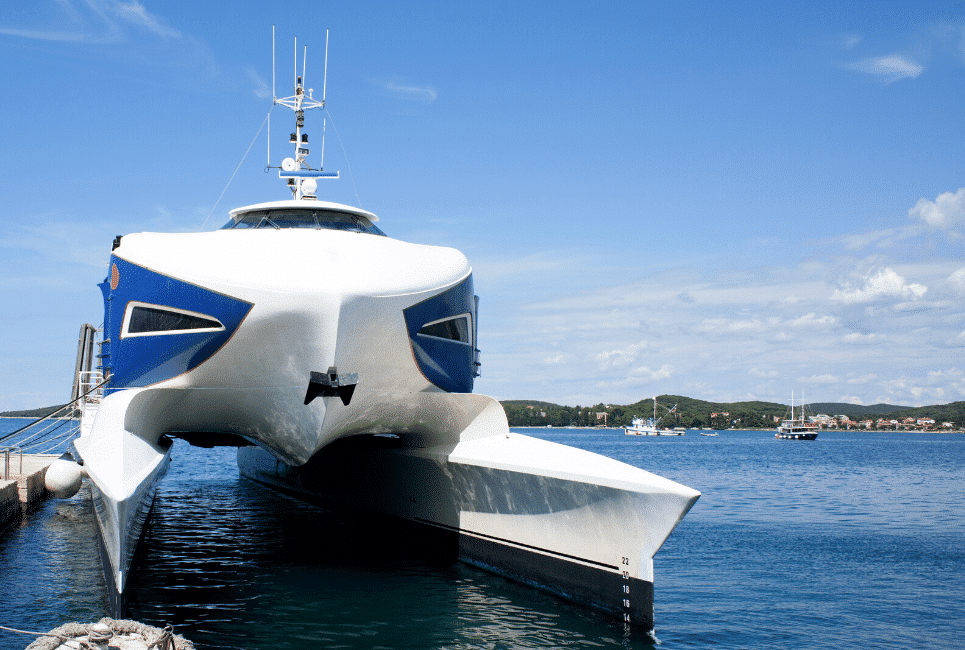
Space and comfort: Two hulls and a wide beam make a very stable platform with lots of volume in the saloon and cockpit. Most living space is above the waterline, with wonderful light and airflow. Cabins in the hulls offer better privacy and isolation, usually with standing headroom.
Straight line speed: Most catamarans are faster in straight-line sailing speed (1) that similar sized or even longer monohulls. Without a lead keel, they’re lighter, so more driving force from the sails converts to speed, and narrower hull forms may have less drag than wide hulls with deep keels. Some heavier cruising catamarans may not be faster, especially if they keep rig size small for ease of handling.
Stability : The beam of two hulls with a bridge deck leads to much higher stability and resistance to roll (2). Waves in an anchorage that induce violent roll in a monohull may make a catamaran bounce or bob. Under sail, catamarans do not heel appreciably even when powered up.
Twin engines. : With one engine in forward and balanced in reverse, most catamarans can spin in a circle in place and make sharp adjustments to the boat’s direction. If you have an engine failure, you also have a second engine, giving a safety edge when you can’t sail.
Monohull advantages

Upwind sailing performance: While catamarans have the edge at straight-line speed, monohulls sail closer to the wind. When you’re racing or you have to sail upwind to get to the next island, this can get you there faster.
Sailing feel and responsiveness : The “feel” of sailing a monohull is much better. With a single hull, you’ll feel wind pressure and trim adjustments immediately for a more responsive helm and a better ability to sail to the wind.
Maneuvering under sail: Monohulls are quite nimble tacking and turning under sail, and there’s less risk of slow or missed tacks.
Righting Moment: The primary offshore safety argument for monohulls is their ability to right when capsized. The heavy keel keeps the boat deck up when sailing, and most monohulls will come back upright even after a complete capsize.
Cargo and Loading: A higher displacement boat with thousands of pounds of lead hung from the bottom isn’t going to be as affected by loading as a relatively light multihull.
Aesthetics: This is subjective, as many catamaran enthusiasts love how they look. Classic sailboat styling, with swept sleek looks, springy sheer lines, and all the “right” proportions are more common on monohulls.
Also read: The 5 Best Electric Anchor Winches
Weaknesses and Cons
Like strengths, weaknesses are relative; just because one class has a strength doesn’t mean the other doesn’t. There are spacious monohulls and beautiful catamarans, just like there are cramped catamarans and unattractive monohulls. The differences have to be highlighted relative to each other, and the weaknesses of one are most apparent compared to the strengths of the other.
Catamaran Cons
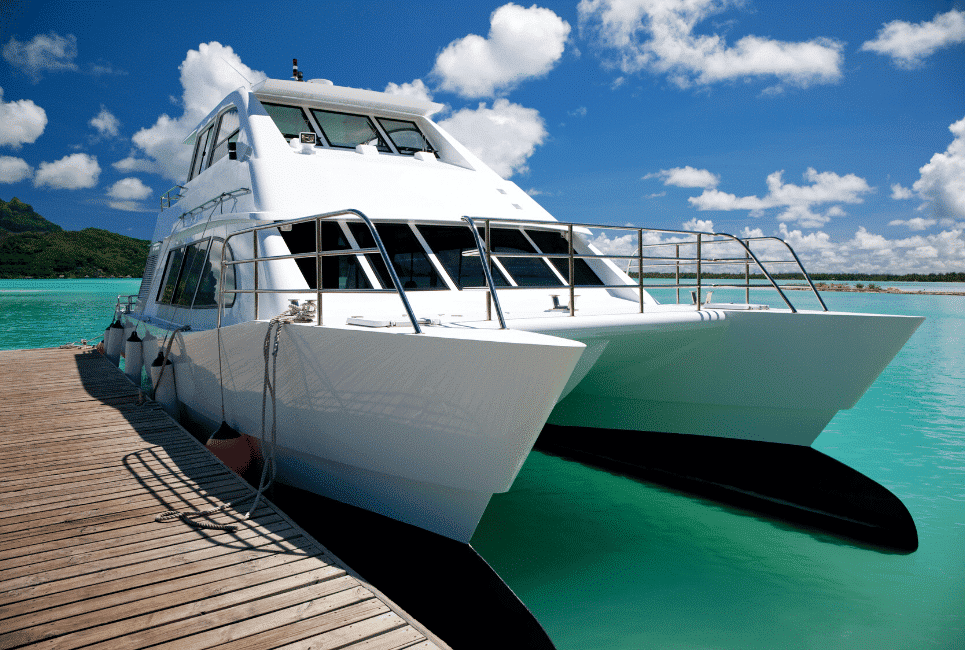
Upwind performance: Cats don’t sail as close to the wind, but they make up for it by sailing faster off the wind. You’ll sail a less direct course upwind. Even if you get in at the same time, you’ll have to sail farther.
Less responsive sailing: Two hulls with two rudders and a very broad platform reduce the helm feel when sailing, cutting responsiveness sailing in shifting wind and wave conditions. It also makes tacking slower.
No-flip zone: It is very difficult, but not impossible, to flip a large catamaran (3). But if a catamaran capsizes, it will not flip back over by itself.
Large in marina/close quarters: You have two problems in marinas. Beamy cats are tough to maneuver in tight spaces because they’re big and visibility is tough over the hulls. And many marinas charge extra because the wide beam extends into the next slip. The good news is that twin engines make tight maneuvering easier.
Price point: Catamarans are more difficult to build and need more materials. This is directly reflected in the cost of the boats.
Monohull Cons
They are heavier: Every large monohull needs a keel for stability (4). They can not sail or stay upright without thousands of pounds of ballast, and this makes them heavier and slows them down. Tiny monohulls can use a centerboard or daggerboard for stability, but most boats big enough to sleep on need ballast.
Darker interiors : Most monohull living space is lower in the boat, where you can’t put enormous windows for light and circulation. It’s very hard to get space as bright and airy as catamaran saloons.
Less living space: With one hull and no bridge deck saloon, most monohulls feel cramped compared to spacious catamarans.
More prone to rolling motions : Only one hull makes monohulls susceptible to rolling in waves, and the movement can be quite uncomfortable.
Heeling: Tipping is just part of sailing monohulls upwind and is unavoidable. It can be reduced on some other points of sail, but not eliminated. Many people, especially non-sailors and new sailors, find this movement uncomfortable or distressing.
You might also be interested in: How to Buff a Boat | A Detailed Guide by a Boating Expert

Troubleshooting Pontoon Boat Battery
Pontoon boats are a great way to enjoy the water and spend quality time with family and friends. But just like any other boat, they rely on a battery to power various systems, including navigation lights, trolling motors, and other…
Boat Accessories

Best Ice Fishing Fish Finders in 2023
In search of the best ice fishing fish finders in 2023? Not all fish finders are created equal, particularly when it comes to ice fishing. Specialized features are crucial to ensure successful outings in harsh winter conditions. You require a…

Best Side Imaging Fish Finders in 2023
Navigating the world of angling equipment can be challenging. That's especially true when it comes to side imaging fish finders, given the extensive range of options available in 2023. This post makes it easy for you to narrow down your…

How to Choose a Fishfinder for Your Boat: A Comprehensive Guide
Today, we embark on a journey to unravel the secrets of choosing the perfect fish finder for your boat. As we navigate through an ocean of options, we'll explore different types of fish finders, delve into their key features, and…
Accessories
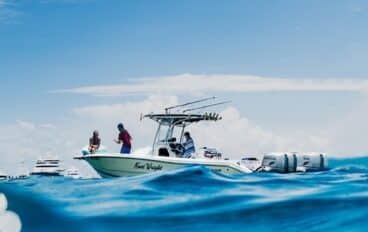
5 Best Portable Fish Finder in 2023
Looking for a portable fish finder for kayaking, ice fishing, or other activities? The good news is that there are a lot of solid products out there. The year 2023 has ushered in an array of advanced models, each brimming…
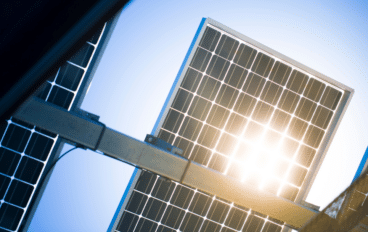
Charging Your Trolling Motor Battery with a Solar Panel
Charging your trolling motor battery with a solar panel is not just the right thing to do for the environment, it is extremely convenient. When you’re out on the boat, with any luck, you’ll have access to a good amount…
Don't miss out

Catamaran vs Monohull - 6 Points To Consider Before Choosing Your Boat
Multihull or monohull? It’s an age-old (and ongoing) debate, and each option certainly comes with its own set of pros and cons. Whether you’re thinking of investing in a boat of your own, or planning on chartering one for a sailing holiday, one thing’s for sure: the type of vessel you select will have an impact on your cruising experience. Ultimately, what you intend to use it for will determine which type of boat would be best suited for the job. In this article, we considered the aspects of space & design; safety; stability; speed; manoeuvrability and cost, so do read on for our comparison of the multihull catamaran vs the monohull sailboat.
THE CATAMARAN VS THE MONOHULL – A COMPARISON
1. stability . which is more stable, a catamaran or a monohull.
Fact – by virtue of having two hulls, both under sail and at anchor, catamarans are more stable than monohull boats. If you are sailing with young children, seniors – or anyone who’s not all-too steady on their feet – a catamaran will provide you with a much smoother and stable cruising experience than a monohull. Being multihulled, catamarans are not nearly as susceptible to the action of the ocean’s waves. This prevents them from heeling as much as monohull vessels would under the same conditions. As anyone who suffers from seasickness will tell you, this can be an enormous bonus. What’s more, a cat’s multihull stability will also be highly appreciated by anyone prepping food in its galley (two hulls make for a somewhat more pleasant dining experience, too). Lastly, because of its superior stability, walking around the deck (and moving around the interior) of a catamaran is much easier than it would be on a monohull. The verdict? Catamarans are more stable than monohulls.
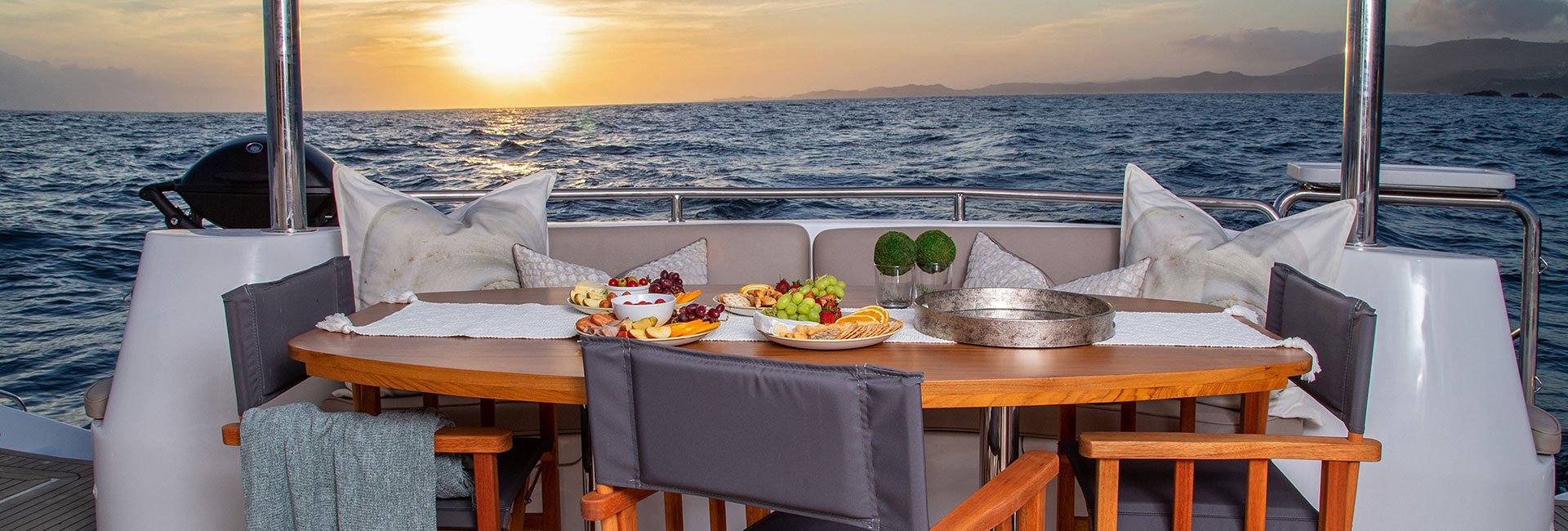
2. SAFETY . WHICH IS SAFER – A CATAMARAN OR A MONOHULL?
The inherent stability and natural buoyancy of a catamaran automatically increase its safety while out at sea. As catamarans don’t have heavy, lead-loaded keels, they will remain afloat, even when (heaven forbid) they are holed. This is because most modern catamarans have such a large amount of buoyancy built into them that they are almost unsinkable, making them much safer than monohull sailboats in this regard. Sure, catamarans can capsize, but being rescued from an upside-down, still-floating multihull is definitely preferable to sinking to the bottom in a monohull! The verdict? Contemporary catamarans are incredibly buoyant and virtually unsinkable, making them safer than monohull sailboats.
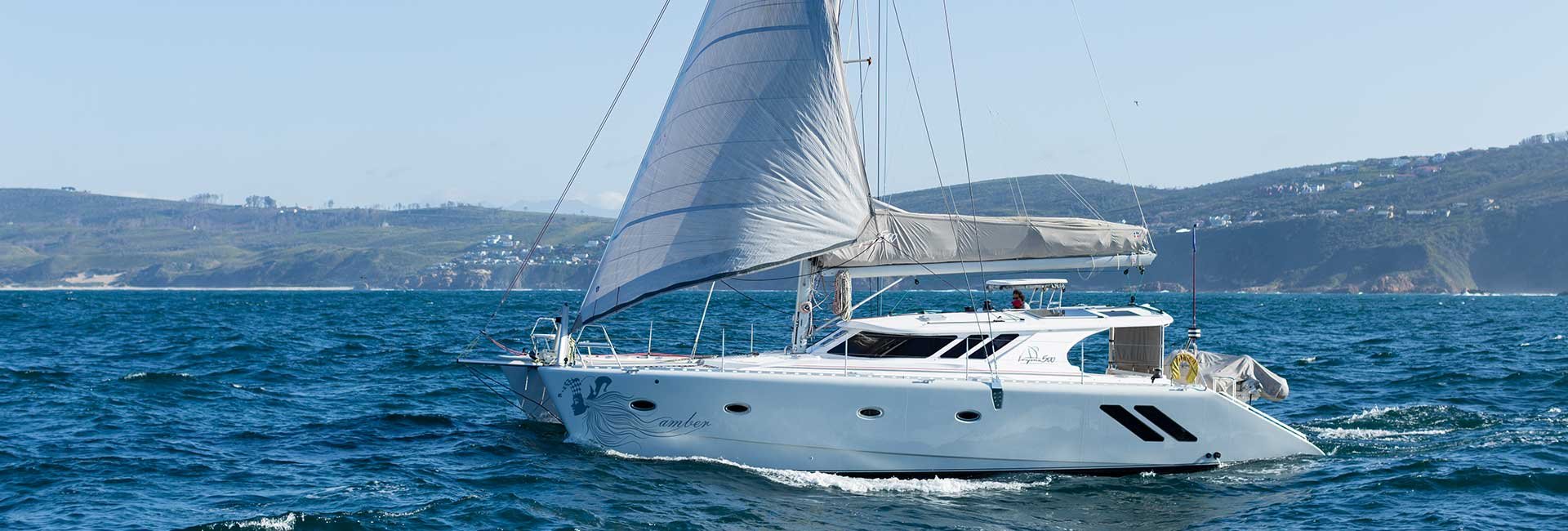
3. SPACE & DESIGN . WHICH IS MORE SPACIOUS AND PRACTICAL – A CATAMARAN OR A MONOHULL?
Due to the boat's shape (and the amount of usable space each design allows), when compared square-foot-for-square-foot, every area of a monohull vessel is usually smaller than its catamaran counterpart. Generally, catamarans offer more room to move in its galley, cockpit and saloon areas than similarly priced monohull boats. Often, catamaran cabins are more spacious too, with cabins of even the smallest cat offering stand-up headroom. Catamarans are also generally more private than monohulls, and more straightforward when it comes to separating living spaces. This can be a significant advantage when you are cruising with children or guests. As most of a cat’s living spaces are above the waterline (on a monohull, only the cockpit is above the waterline), you’ll also enjoy superior airflow through ventilation on a catamaran. If you’re a scuba-diving enthusiast, carrying all of your diving equipment will be easier on a cat. What’s more, catamarans have trampolines, which make them perfect for onboard sunbathing as well as stargazing in the moonlight – a big, romantic plus for sure! Catamarans also have shallower drafts, allowing you to drop anchor closer to the beach than a monohull would. The verdict? Compared square-foot-for-square-foot, catamarans are more spacious than their monohull counterparts. In terms of design, a catamaran is perfect for onboard sunbathing and stargazing and will allow you to anchor closer to shore.
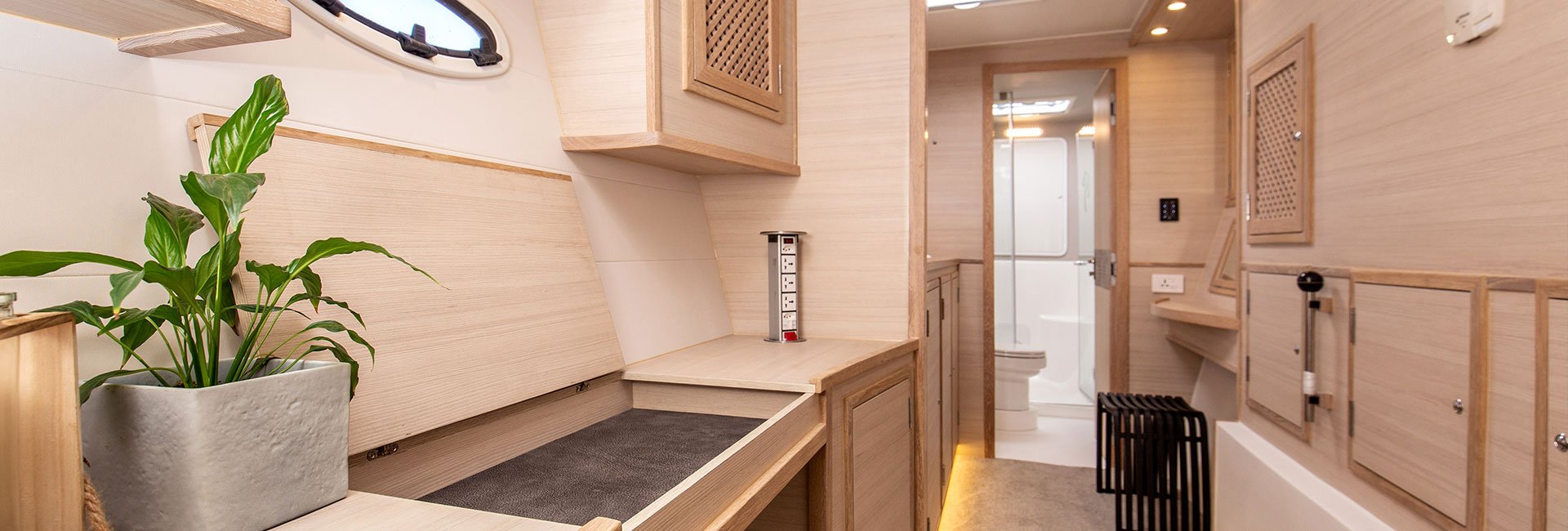
4. MANOEUVRABILITY . WHICH IS EASIER TO STEER, A CATAMARAN OR A MONOHULL?
Most catamarans can turn 360 degrees within their own length, something very few monohulls are capable of doing. However, generally speaking, monohulls are quick to tack, more manoeuvrable, and quicker to respond to the helm than catamarans. At the helm of a catamaran, you’ll get less feedback from the wheel than you would from a monohull. This will require you to be vigilant in rough conditions, and you’ll also have to know when to reduce sail. Compared square-foot-for-square-foot, catamarans are much lighter than monohulls, which means they also slow down a lot quicker. For the most part, catamarans are easier to dock than monohulls, as they have two motors and two rudders which simplify things a lot. This also does away with the need for a bow thruster. The verdict? We’re calling it a tie. Although monohulls are generally more manoeuvrable than catamarans, thanks to their two motors and two rudders, cats are easier to steer than monohulls.
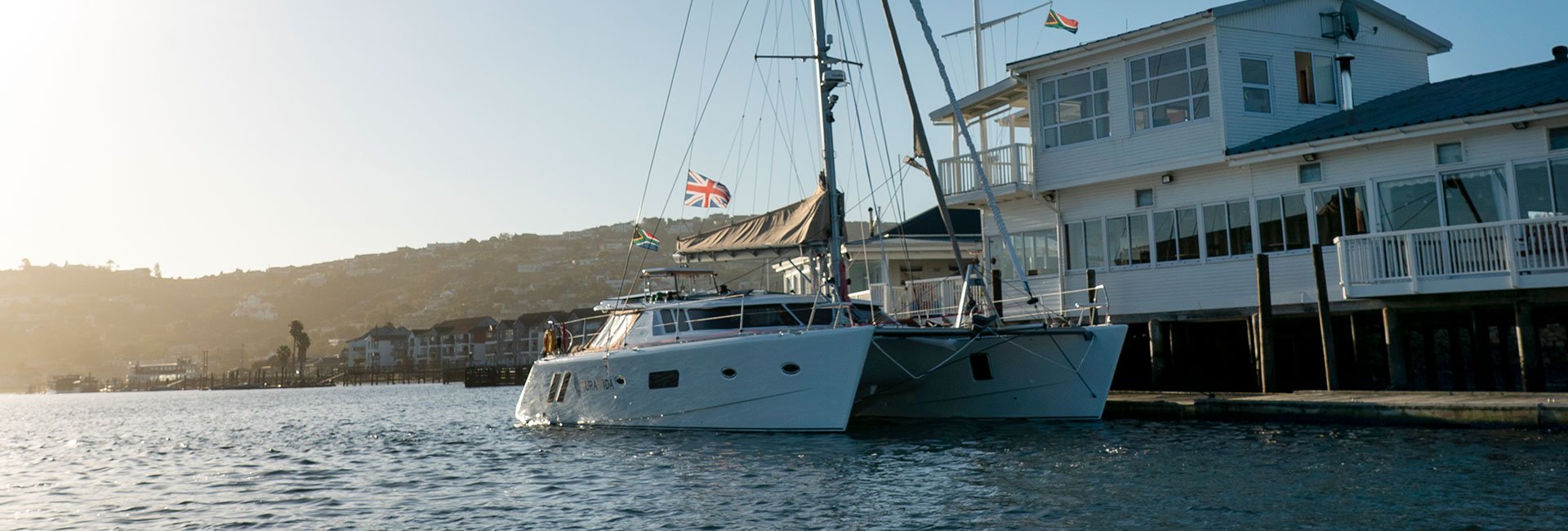
5. SPEED . WHICH IS FASTER, A CATAMARAN OR A MONOHULL?
Although catamarans cannot sail as close to the wind as monohull sailboats, most cats do sail faster than a monohull on a reach. On downwind runs, reaches, and broad reaches, in particular, catamarans usually beat monohulls when it comes to speed, going about 20% faster than a monohull (even outrunning bad weather when necessary!). Another plus is that sailing a catamaran requires less physical exertion than sailing a monohull. The verdict? Even if they don’t point as high into the wind, catamarans are faster than their monohull counterparts.
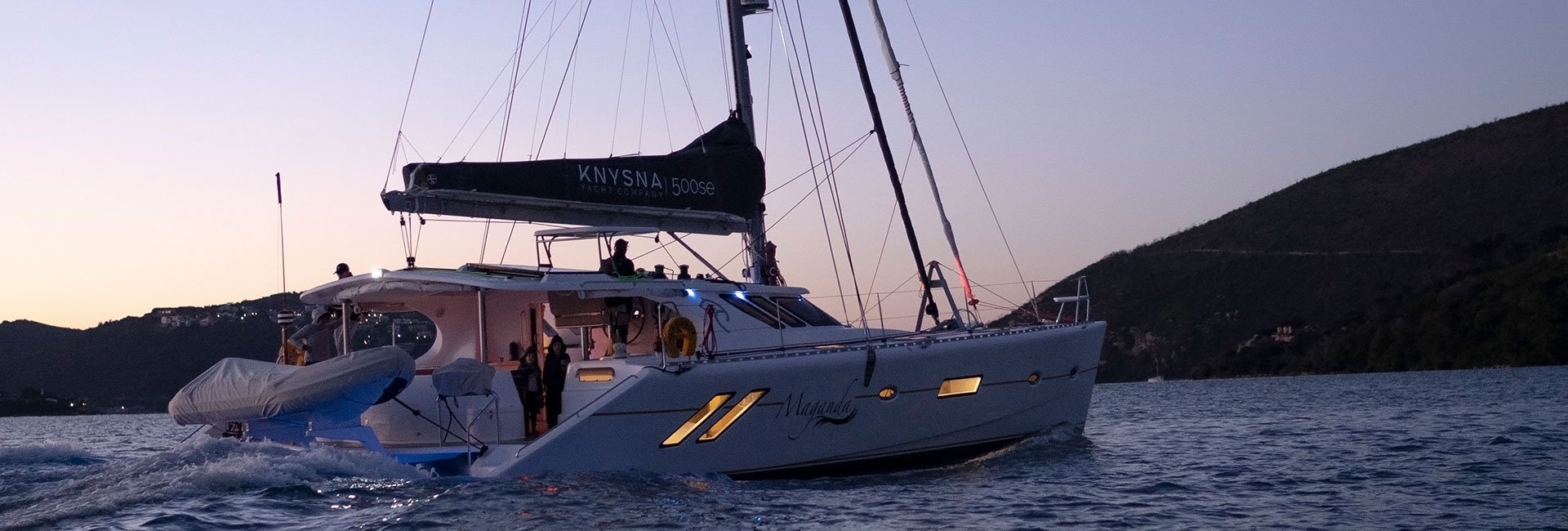
6. COST . WHICH IS MORE EXPENSIVE, A CATAMARAN OR A MONOHULL?
Generally speaking, catamarans with similar sleeping capacity and equipment are more costly than their monohull counterparts (both to own or to charter). Just keep in mind that catamarans typically hold their value better and longer (and tend to be in higher demand) than monohulls. Comparatively, previously owned monohulls are cheaper to purchase than cats, as supply tends to outweigh demand by a large margin. The verdict? Catamarans are more costly than monohull sailboats. However, a read-through of Points 1 to 5 might convince you that they are worth the extra expense.

CATAMARAN OR MONOHULL? – YOUR NEEDS WILL DETERMINE YOUR CHOICE
Looking at the list of pros and cons above, it would seem that the catamaran comes out the clear winner – at least when judged on aspects of safety, space & design, speed and stability. However, your budget, the requirements of the people in your sailing group, as well as your own needs and preferences will all play a significant role in the boat you end up choosing. Both catamarans and monohulls offer unique advantages, and whichever choice you go with, we wish you many happy ocean voyages and an abundance of adventure! Ps. If you’re still unsure which option is the right one for you, why not check out the verdict from ocean adventurers who have lived aboard two monohulls and four catamarans over the past 25 years?
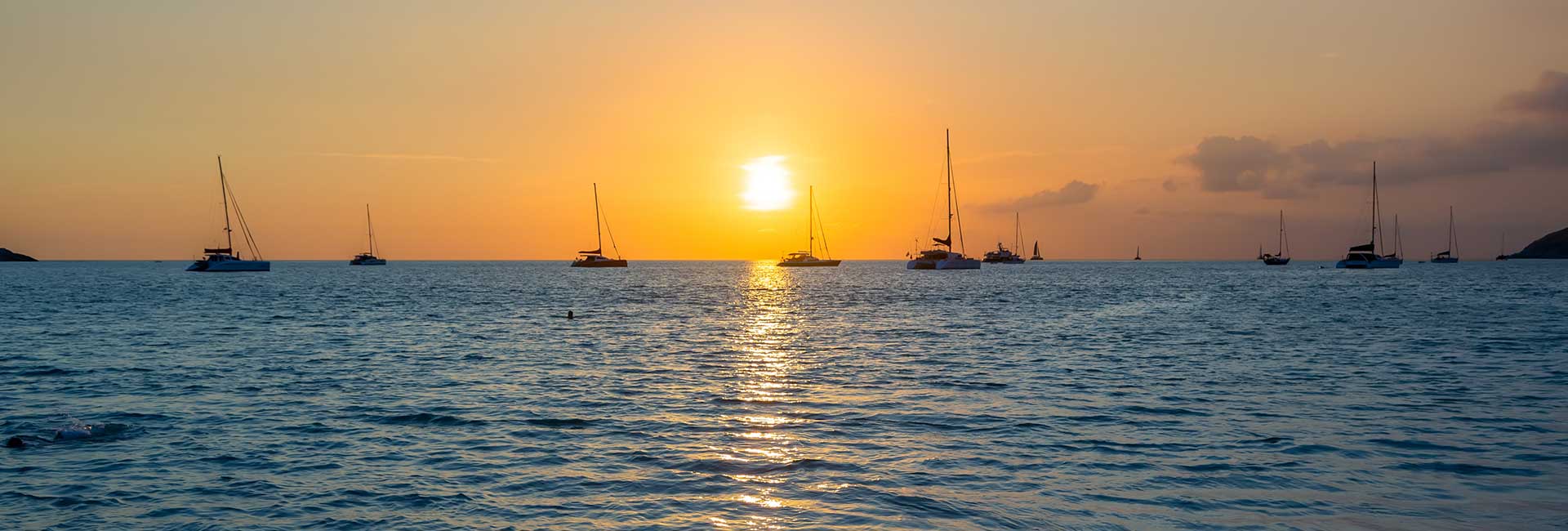
Yacht Maintenance - Top Tips for Protecting Your Investment
Essential things to know about boat insurance, top things to know about yacht solar power, building a yacht: top things to know about the yacht-building process, get all the latest to your inbox, discovery awaits.


Catamaran vs. Monohull: We Changed, Should You?

There are two schools of thought when it comes to monohull versus catamaran . We have done extensive cruising and lived aboard two monohulls and four catamarans over the past 25+ years . We experienced the good and the bad for both single hull and multihulls first hand. Quite honestly, the pluses for catamarans far outweigh the minuses. There are multiple benefits of catamarans. They are faster, more stable and spacious, and have shallower drafts allowing safer anchorage closer to shore. Being on a stable platform with no heeling cuts down on crew fatigue and seasickness leaving the crew more alert and in control of the vessel. Even novice sailors feel more confident on catamarans.
When we built our monohull Royal Salute in the early 90s, catamarans were not established and were looked upon with extreme suspicion by most cruisers, including ourselves. “Safety and the capsize” issue were always the first things to come up against sailing catamarans. It is a fact that monohulls can get rolled in heavy seas but will right themselves because of the heavy lead keel, and while crew and vessel will be battered, the roll is survivable.

However a catamaran once capsized, will remain upside down (jokingly referring to this state of the catamaran as “reaching its most stable position when upside down”). The inability of a catamaran to self-right was and still is a major bone of contention. However, what is not often discussed is that a monohull has about a 5,000 pound keel of lead that is constantly trying to drag the boat to the bottom of the ocean versus a catamaran that has no ballast and is in most cases with modern catamarans, unsinkable.
So the options are to either sail the world on a boat that, if it springs a leak, will sink like a stone or a vessel that cannot self-right in the event of a capsize but will not sink no matter what. So from a practical point of view, here are our observations over the last 25+ years of living aboard, on the advantages and disadvantages of a catamaran.
ADVANTAGES OF A CATAMARAN
1. speed equals safety.
The speed of a catamaran makes it possible to outrun bad weather. While catamarans do not point as high into the wind as a monohull (or if it does, it makes more leeway or slides sideways), it is about 20% faster than a monohull. This means that even if you sail upwind at a slightly wider angle to the wind than a monohull and have to cover more distance, you will still arrive at your destination long before a monohull.
A modern performance catamaran with daggerboards and good quality sails will point as high as a similar sized monohull. It will point the same as a comparable monohull and sail much faster and therefore arrive at an upwind position much sooner than a the monohull. It is important to note that most of the production catamarans on the market are under-powered and are equipped with standard smaller sails. In lighter breezes many of these designs perform poorly unless fitted with bigger headsails, a Code Zero and a square-top mainsail.
While we believe that more comfortable and safer in rough weather , we have to concede that when the weather gets really bad (60 knots of wind or more) we would personally prefer to be on a monohull from the standpoint of surviving. I would say that a monohull is preferable for serious offshore single-handed sailing because you can more easily hove-to in a monohull. We have been in some extreme weather on a number of catamarans and never really felt that we were in danger, although it takes some nifty seamanship.
A monohull could capsize in extreme weather or even roll in a storm, but they generally come back upright. A catamaran on the other hand, will not right itself. But the cat will generally stay afloat, offering a good place to survive while you wait out the storm or until help comes along. Well-designed modern catamarans are very hard to capsize though.
Having said all that, most catamarans can do 200 to 250 miles a day and with modern technology allowing one to pull down weather at will, there is no good reason why you should get caught in extreme weather. A faster boat is a safer boat as it will in many cases be able to outrun bad weather. With good weather routing information a catamaran can avoid most serious weather and, at worst, place itself in the most favorable position to avoid the brunt of a storm.
2. A Catamaran is a Stable, Safe Platform Underway
Catamarans have no ballast in the keels like monohulls do and therefor it relies on beam and buoyancy for stability. Typically cruising catamarans will have a beam to length ratio of roughly 50%, although many designs nowadays exceed the 50% rule of thumb. So, a 45-ft long catamaran will be about 22-ft wide, providing a very stable platform when sailing. Unlike catamarans, monohulls cannot overcome the rolling and pitching with their narrow beam and the lead ballast for stability.
This rolling and pitching makes the deck on a monohull very unsafe whereas on walking around on the deck of a catamaran while underway is far easier since the boat is much more stable, and it doesn’t heel. This makes sail changes and reefing much easier and a lot safer for the crew. Without the rolling and pitching motion, the danger of falling overboard on a catamaran is considerably less than on a monohull.
3. Crew Fatigue Reduces on a Catamaran
Because a catamaran does not heel over like a monohull, it offers far more comfort underway because the motion is mostly fore and aft pitching and very little beam-to-beam rolling. On all points of sail, a catamaran tracks upright and significantly reduces crew fatigue and seasickness. Seasickness is usually caused by things like anxiety, fatigue, hunger and cold, which all add to a sense of disorientation. This leads the crew to making bad decisions and seamanship errors that could be fatal to the crew and vessel. The more stable platform of the catamaran will hugely keep those issues at bay, making the crew more alert and energized.
Every action and chore including cooking is much easier on a catamaran when underway. It is much more pleasant to be on the deck level looking out rather than being stuck “down below.” It is also much nicer to sleep on a boat that doesn’t heel. I remember nights at sea in our monohull when I was rolling around in my bunk unless I was properly wedge in a little corner. That is simply not the case on catamarans.
All these factors ensure that your crew will not expend unnecessary energy to simply try and stay upright, onboard and safe on a long passage. Your crew on a catamaran will be well rested and alert and will be able to function well if a stressful situation arises.
4. Comfort at Anchor
Catamarans provide a wide platform and therefore offer lovely spaces to relax at anchor without the rolling motion that monohulls have a tendency to do in a swell. During our 15 years of cruising on a monohull, we have often had to leave anchorages that we really were not finished exploring because of a rolly, uncomfortable anchorage. Big rollers or swells coming into an anchorage can make conditions in an anchorage very uncomfortable and unsafe.
We were anchored off Funchal on the island of Madeira in our monohull Royal Salute once, when we were forced to leave our anchorage. The rolling became so bad, we were rolling from gunnel to gunnel. The anchorage became untenable to remain anchored, forcing us to go out to sea in foul weather in the middle of the night. This is an extreme case but believe me, we have left many an idyllic anchorage because of a rolling swell into the anchorage. Catamarans, on the other hand, do not roll from like monohulls have a tendency to do and are far more comfortable at anchor.
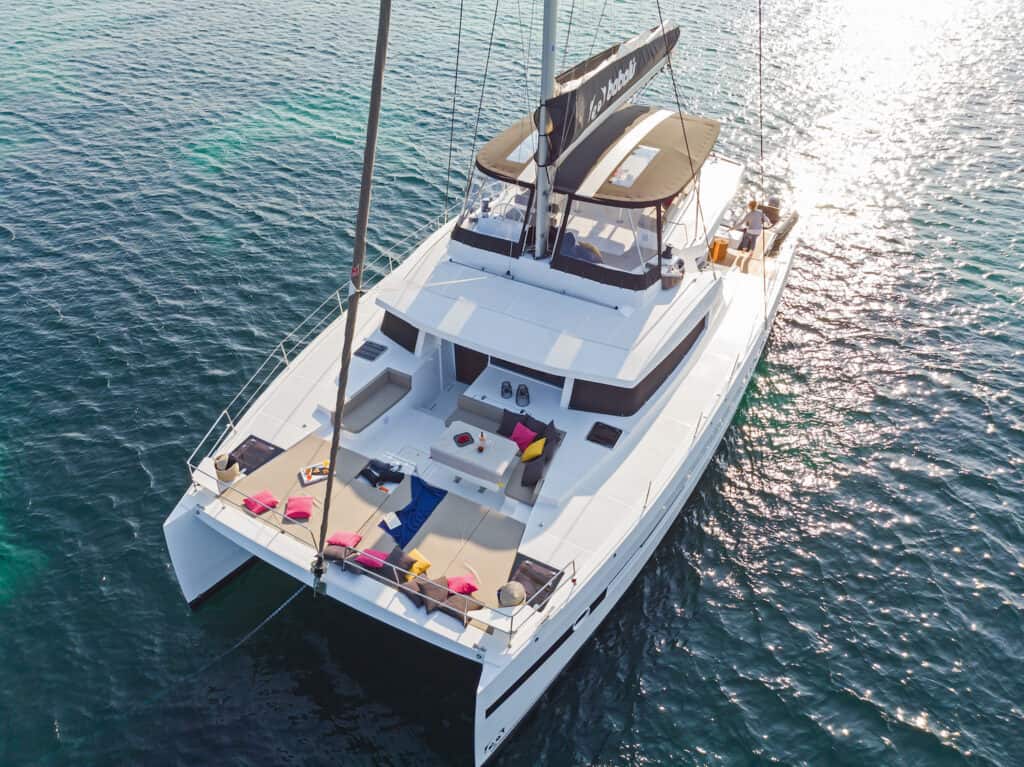
5. Anchor Bridal Setup

Catamarans are fitted with a bridle, attached to both bows and down to the anchor chain, resulting in a very stable position at anchor. What we found with our monohull was that because the bow acts as a sail (because of the high freeboard), the boat tended to sail at anchor in high winds. It sailed in one direction until the chain snatched and tacked over and sailed in the other direction, feeling like it might dislodge the anchor altogether. The catamaran on the other hand sits at anchor a lot more stable and doesn’t sail around as much.
6. Ease of Boarding on a Catamaran
Thank goodness we were much younger and more agile during our monohull days. Royal Salute and most monohulls of her generation or older, have high free-boards, making it quite a feat to get onto the boat from the dinghy. It was one of the most challenging things to do because unlike the more modern monohulls that have a scoop at the back, we had to climb up on the side of the boat to get on and off. We, of course rigged steps, etc. but it was always a hassle compared to the ease of getting on and off a catamaran from a dingy or from the water.
7. Shallow Draft Equals Better Anchorages
Catamarans have significantly shallower drafts than monohulls, allowing for safer anchorages closer to shore. Most catamarans in the 40-ft to 50-ft range draw between 3-ft to 4.5-ft, so they can anchor in places that a monohulls can not even consider. In the shallow waters of the Bahamas for example, the catamarans have a big advantage. We often anchor our own catamaran just a few feet away from a beach. It definitely allows one to be able to explore areas where the water is shallow without the fear of running aground.
The shallow draft also allows for emergency repairs in shallow water and even doing the bottom job when the tide goes out as we have done in places like Mtwapa Creek in Kenya, East Africa. The catamaran easily rests on her keels on the sand without help making it a breeze to do the “annual haul out” even in remote locations.
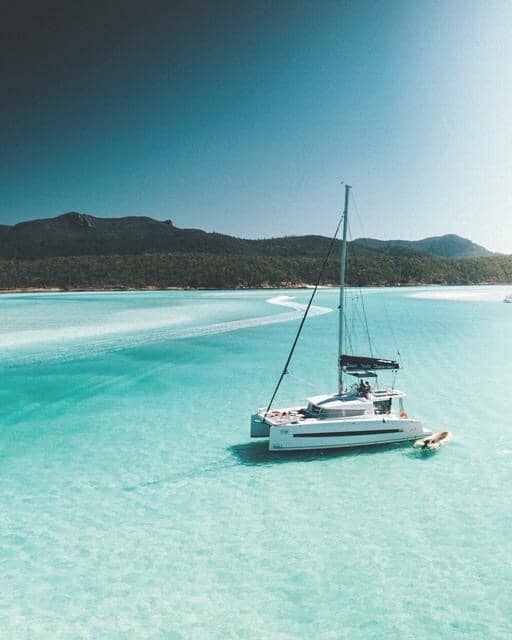
8. Dinghy Davits & Dinghy Size
All catamarans have a set of davits that make it very easy to raise and lower the dingy. Our monohull and most cruising monohulls do not have an efficient or easily accessible set of davits. This makes raising and lowering the dingy an elaborate production. Catamarans on the other hand, has davits systems easily accessible and some even have platforms to rest the dinghy on.
The lack of beam and difficulty of lifting the dinghy also limits the size and type of dingy that one can reasonably carry on a monohull. As we all know, the dingy is your transport to and from shore and diving or fishing spots, so the bigger and faster the dingy, the better off you are. A catamaran can carry both a heavier and bigger dinghy which makes the popular center consul dinghy so much more possible.

9. Interior Space and Comfort on a Catamaran
We sailed 32,000 NM on our 45-ft monohull, happy as clams, not realizing that sailing does not have to be done lying on your ear 24/7 while on passage or sitting knee-to-knee in the cockpit at anchor with your two other guests at the dinner table! One can liken sitting in a monohull cockpit to sitting in an empty Jacuzzi, you are always nice and close to the other folks.
Now that we are on our fourth catamaran, there are a few things that have become more evident to us than the incredible space and comfort of a catamaran, not only at anchor but also underway. The cockpit and living space in general are huge compared to a monohull, making for very comfortable and spacious living conditions. It feels more like you are at home, rather than just on a camping trip.
Knowing that one spends at least 90% of one’s cruising life at anchor, it’s important to have good open living space, which most modern cats nowadays offer. A lot of cats have walk around beds, lots of storage, every modern appliance including washer/dryer, etc. However, one has to fight the urge to fill the space if you want to keep the cat light and fast.

Sailing with guests onboard for extended periods of time, in close quarters can become claustrophobic but on a catamaran people are spread out and separated. With guests sleeping in one hull and the owners in another, catamarans offer much more privacy and separation. Some cats even have privacy doors that will close off the entire hull and has a separate entrance onto the deck, which really separates you from the guests completely.
There is very little heeling on a catamaran, so there is no need for hand grips and safety harnesses inside the boat. There is nothing better (and safer) than being able to walk from the cockpit into the living room (saloon) on one level or one step down at most. In a monohull, when heeling at a severe angle, you would have to claw your way from the companionway steps down to the living area, while fighting to stay upright, significantly tapping your energy.
Unless you hit extreme conditions, everything stays put on a catamaran reducing the anxiety before doing passages of having to stow and secure everything. This very issue makes a lot of cruisers reluctant to weigh anchor and explore more often. It is just too much effort to pack away all your stuff once comfortable in an anchorage!
One thing you will notice is that the stove on catamarans are not gimbaled like it is on monohulls and this should tell the story in itself. The stability and comfort on a catamaran is far superior. Cooking is easy and safer. I often open a nice cold beer, put it down to do something and forget about it only to find a warm beer later in the same place I left it. This is not something that happens on a monohull.
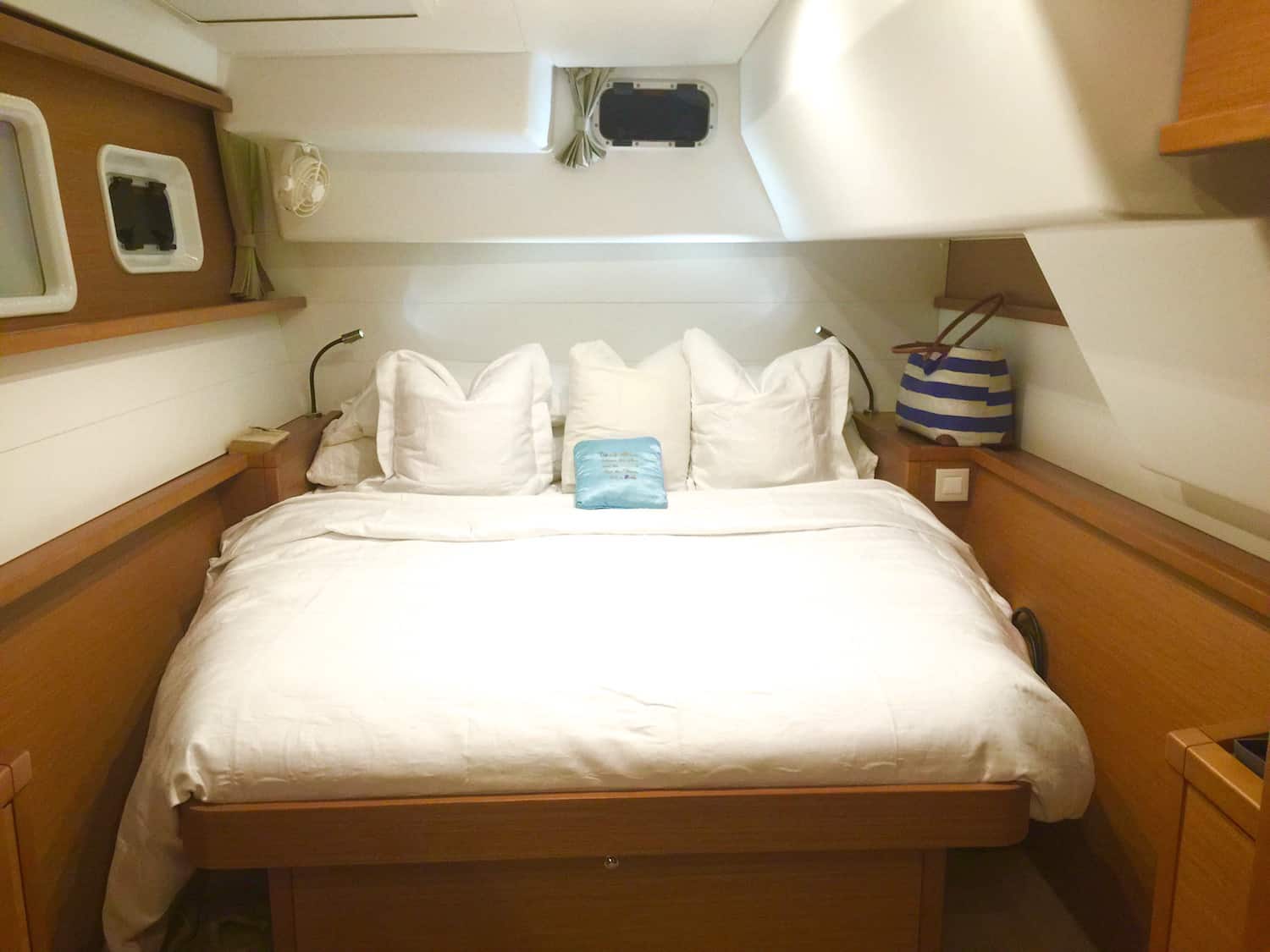
10. Redundancy on a Catamaran
Unlike monohulls, catamarans have a lot of critical redundancies. That of course means two hulls to clean and anti-foul, double the engine maintenance, etc. but having two of the critical equipment like engines for instance, outweighs the downside.
With two engines, if one fails you still have adequate propulsion to go anywhere. If by some fluke the second engine also fails, you have a full set of spares to fix at least one of them. Our friends once hit a sleeping whale off Tanzania, and when it dove, it hit the prop, bending it. They limped into the narrow channel on the one engine but at least they could make it to a safe harbor where we surveyed and repaired their damage.
We often only use one engine when motoring while making passage in order to conserve our fuel. The one engine is totally capable of moving the boat along at a good speed unless you are in heavy seas and you may need more power. Other than that we only use two engines to dock or maneuver the boat in close quarters.
Because there are two engines there are also two independent charging systems via the alternator on each engine. If one alternator goes out, there is still another complete charging system. There are two rudders and if one fails or falls off (as has happened to our friends on a monohull off Columbia, where they almost lost their boat) you have a second rudder that is completely capable of steering the boat by itself indefinitely. That holds true for several things on a catamaran!
11. Maneuverability
The engines are spaced far apart on a catamaran and it makes maneuvering much easier and more precise than monohulls, unless the monohull has a bow thruster. We did not have a bow thruster (not many monohulls do) and had to rely on prop-walk and using prop wash on the rudder. A modern catamaran can do a 360 turn on her own axis. A monohull cannot do this and have a bigger turning circle. However, a monohull under sail is much more maneuverable and certainly will tack a lot faster than a catamaran. The ease in maneuverability under engine on a catamaran in close quarters specifically, is vastly superior comparatively.
12. Rigging
Because of the beam on a catamaran the spinnaker pole has become unnecessary equipment. Hallelujah, I say. That pole on our monohull was a pain the behind and I always hated having to use it. On a catamaran, one can fly an asymmetrical cruising chute or spinnaker, using the bows to tack the clew or run a guy through a block so it is very much simplified, easier and safer.We also sail wing-on-wing with twin headsails when we sail downwind. We use our furling jib and furling Code Zero. It is as easy as one, two, three.
DISADVANTAGES OF A CATAMARAN
1. bridgedeck slamming.
One advantage most monohulls do have when underway is that they don’t slam. Catamarans with a low bridgedeck clearance can experience significant slamming in confused seas sailing upwind. This slamming can be quite disconcerting when you first experience it as we did on a Shuttleworth 44 design, our first ever catamaran experience, 20+ years ago. At times, it felt as though the boat was falling apart. Of course the boat was fine but nevertheless, the stress on the crew from the constant noise and discomfort was significant.
Monohulls don’t have a bridgedeck which means no slamming and are therefore a bit more comfortable than l ow bridgedeck catamarans when beating into severe confused conditions or “washing machine” conditions as we call it. Modern catamarans mostly have better bridgedeck clearance and the slamming is significantly less. However, not all cats have a good clear tunnel under the bridgedeck. Some manufacturers build beds into the bridge deck in order to make more space in the chest of the catamaran where the slamming occurs. These protuberances into the bridgedeck tunnel will likely increase slamming. So be mindful of that when selecting a catamaran. We currently own a Bali 5.4 and the bridgedeck clearance on this boat is more than adequate and the tunnel is clear. We therefor experience very little slamming compared to our Prout 45 that we previously owned (picture of sister ship below) with a much lower bridgedeck.
We Explain Bridgedeck Clearance
In the pictures below, the Bali 5.4 has very good clearance from the water to the bridgedeck and has a nice clean tunnel versus the very low bridgedeck of the Sunreef 50.

2. Sailing Downwind
Monohull spreaders are set at 90 degrees to the mast whereas a catamaran has to have backswept spreaders. The reason is that, on a monohull, there is a backstay and using this, plus the intermediates you can get a nice pre-bend in the mast (the pre-bend is to flatten out the main sail and allow for better performance).
On a catamaran with no back stay, you need to use the back swept spreaders and the diamonds to pre-bend the mast. The reason I point this out is because on a catamaran, if you want to broad reach or run, the mainsail cannot be let out all the way because the backswept spreader tips could punch holes in the fabric.
On a monohull, the spreaders are at 90 degrees so you can let the main and the boom out much further which is, of course, much more effective. This is one of the reasons it is better to broad reach and tack downwind on a catamaran.
Whether a monohull or multihull, sailing dead downwind doesn’t usually make great VMG. Therefor a regular cruising cat, much like a monohull, needs a lot of sail area and has to sail deep downwind if it is to achieve a decent speed made good (VMG). This video demonstrates how we achieve this by sailing wing-on-wing downwind.

It is more difficult to find a dock either as a transient or a permanent slip for a catamaran in general because of the wide beam. But this is changing fast and will soon not be too much of an issue. In the USA dockage is charged by the length of the boat in feet, so there is no disadvantage there but, in some places, (the Mediterranean for example), dockage is charged at length times one and a half because of the additional beam.
Since the catamaran is stable at anchor, we mostly anchor out. We have more privacy, a better breeze and usually a stunning view.We have a nice dinghy with a good outboard engine and is big and comfortable enough to get to shore fast and together with the modern conveniences like the generator, watermaker and washer/dryer, docking becomes a non-issue.
It is definitely more difficult to find a travel lift with enough beam for a catamaran for a haulout, while, for a monohull, there are absolutely no problems anywhere. The wide beam of cats also greatly limits the number of shipyards that can haul them out. Most catamarans over 40-ft must be hauled out with a 50-ton travel lift. This not only increases the cost of the haulout, but greatly limits the choice of the shipyards for repairs and maintenance. With limited choice, prices are high for shipyard services.
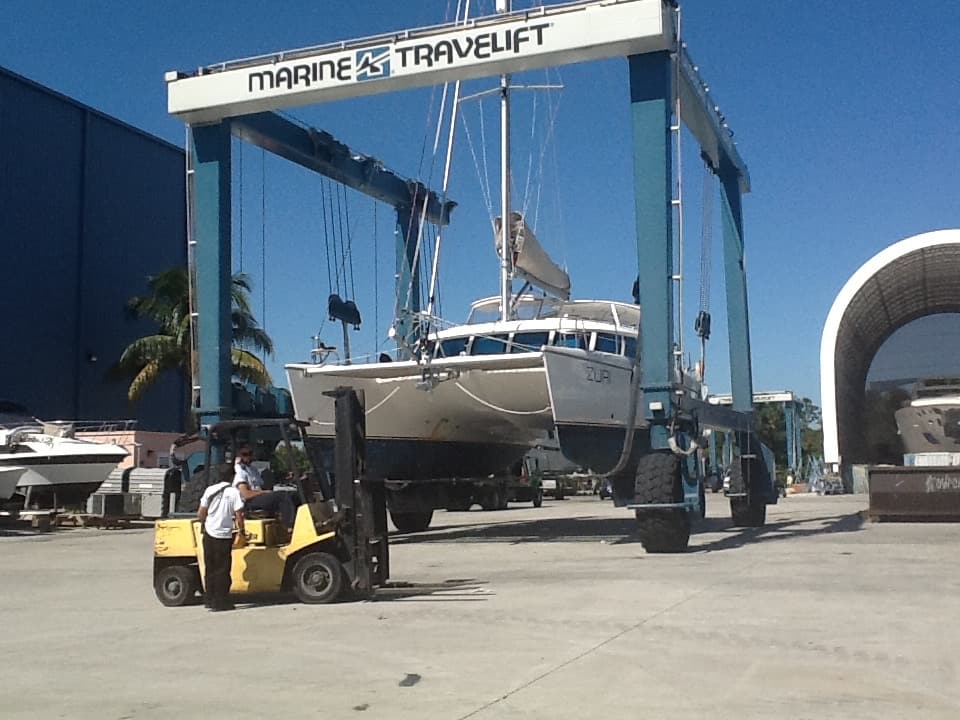
Catamarans do tend to have a lot more windage than monohulls. This can be an issue especially when maneuvering in close quarters with a strong wind. But I have found that, provided the engines are powerful enough for the size of catamaran, that twin engines negate this problem. Also, many modern large catamarans now have a bow thruster fitted. It is super easy to dock.
The cost of getting into a catamaran is much higher than that of monohulls. That could put a serious dent in your cruising kitty or require you to put your dream on hold a little longer. Pre-owned monohulls on the other hand are very cheap to buy comparatively, because the supply presently far outweighs the demand.
Catamarans are in high demand and they typically hold their value much better and longer and the trend is now heavily in favor of the catamaran market. When prospective buyers contact us for catamarans under $250,000 the choices are very limited and catamarans under $100,000 is near impossible to buy. In this case, your best bet is to go with a monohull unless you go with much older boats like the Prouts or the less expensive Geminis.
Our Own Catamarans & Monohulls
FYI: Royal Salute , a Bruce Roberts 45 monohull, was the first boat we owned and sailed approx. 30,000NM on. Mythral, a Seafarer 30, was our “toy boat” while we were waiting for our catamaran to be built. Even though this classic little monohull sailed around the world, it didn’t have much in modern conveniences like running water. Siyaya was an Island Spirit 40 catamaran that we sailed from Cape Town to Florida on and then taught live-aboard sailing classes for several years. Zuri I was a Prout 45, a beautifully crafted catamaran but by today’s standards is considered old technology. Our Lagoon 450 SporTop ( Zuri II ) is a fantastic live-aboard catamaran. We lived and taught aboard her for three years but sold her last year and we currently own a Bali 5.4 ( Zuri III or Z3 as we call her now). Read about our various boats .

CONCLUSION: CATAMARAN vs MONOHULL
We were dyed in the wool monohull sailors for 15+ years. We loved the pretty lines of monohulls, the sailing ability and what we believed at the time to be much safer vessels. However, now that we have been avid catamaran enthusiasts, we simply can never go back to monohulls. Catamarans have come of age and with modern technology have overcome most objections that sailors of old had against them. They are well designed and built, are safe, and we simply love that they sail fast and upright. There is not a whole lot to dislike about a catamaran when you live aboard. We have weighed all the pros and cons of catamarans and found that the pros far exceed the cons. We made the change to a catamaran and do not regret it one bit!
We hope that this article will clear things up for all the prospective catamaran owners out there.
Contact us if you have any questions regarding catamarans, Fractional Yacht Ownership or our Charter Management Programs .
Estelle Cockcroft
Join our community.
Get the latest on catamaran news, sailing events, buying and selling tips, community happenings, webinars & seminars, and much more!
4 thoughts on “Catamaran vs. Monohull: We Changed, Should You?”
I read that the engineering on the catamarans were improved over the years. Whats the oldest year would you recommend designwise?
Scott, my apologies for the late reply. We’ve been traveling in Africa. Anyway, catamarans have come a long way and improvements in technology is happening at lightning speed. I reckon that even the older model catamarans are good. It depends on what your needs are. If you want something a little better performance wise, I would go for something no older than 15 years.
After buying a catamaran what is the difference in expense of a catamaran vs a monohull. Many articles state that not only the initial cost of a catamaran is more it the operating cost as well.
Hi Todd, it is more expensive. The annual dockage and haul out as well as maintenance will be more expensive. You obviously have two engines to maintain and various other pieces of equipment to service in both hulls. While there is more equipment there is also more redundancy and of course you have the comfort factor. So, depending on your situation, it’s probably worth it.
Leave a Comment Cancel Reply
Your email address will not be published. Required fields are marked *
Save my name, email, and website in this browser for the next time I comment.
Recent Posts

Top 10 Reasons to Sell (and Sail) Your Catamaran in Annapolis, MD
We have a new home in Annapolis! The office is located in Annapolis, Maryland

Top 10 Reasons to Sell (and Sail) Your Catamaran in Texas
Our Texas Office is located in the Watergate Marina Center in Clear Lake Shores,
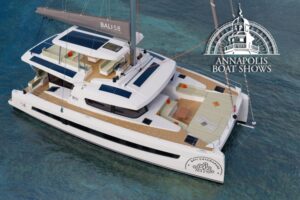
Annapolis Boat Show 2024
Meet with our team! Want to learn more about the Bali and Catana

Exploring the Catana OC 50 Catamaran: A Comprehensive Overview
The Catana OC 50 Catamaran, the latest addition to the Catana Ocean Class series,

For more than 30 years, we have been a part of the catamaran community and created Catamaran Guru™ to encourage and educate all the aspiring sailing out there. We understand the dream of traveling the world by catamaran and created a one-stop-shop to make that dream a reality for you.

- Stephen & Estelle
- Testimonials
Get Started
- Yacht Sales
- Used Yachts
- Charter Management
- Boat as Business Programs
- Seminars & Events
Better Sailing

Catamarans vs Monohulls: Which is Better a Better Sailboat For You?
The question of whether to choose a monohull vessel or a catamaran is an eternal dispute between boat lovers. These arguments are usually based on one’s preferences and philosophy. In fact, the popularity of catamarans has grown significantly since their design facilitates many aspects of sailing. But, both mono-hulls and multi-hulls have their advantages and disadvantages. So, in this article, I’m going to list some details about both cats and monohulls so as to help you understand which one is better for you. Remember it all depends on what sort of experience you are looking for. Keep reading!
What is a Monohull?
In general, boats float due to the fact that they displace more water than they weigh. The hull is in “displacement mode” while a boat is stationary or moving slowly. That is, all of the upward forces that keep it afloat come from flotation, which is achieved by displacing water. With certain hulls, increasing the boat’s speed beyond a particular point causes the hull to lift up and skim along on top of the water. This is referred to as “planning.” Monohulls can be divided into two types; displacement and planing hulls.
Some hulls are only capable of moving at displacement speeds . This style of boat has generally slow speed, but it is incredibly efficient to operate. While moving, most have a smooth motion , though rolling (side-to-side movement) might be an issue. On the other hand, while on the sea, achieving fast speeds requires a hull that can readily transition onto a plane. Flat bottom surfaces from amidships aft, or from the middle to the back of the bottom, and a flat transom, or the back of the hull, are the main characteristics of a planing hull. Keep in mind that at a sharp angle, the transom must contact the bottom.
What is a Catamaran?
Nowadays, catamarans are becoming more and more popular. They’re particularly appealing to fishermen since they combine high-speed performance and a smooth rough-water ride with a solid angling platform. Catamarans have two primary disadvantages . Firstly, they require twin engines. Also, larger catamarans may be too broad to fit into standard marina docks. Another disadvantage is that there is less usable interior space than on a monohull of comparable length.
The two hulls of a catamaran are known as amas. These days, the popular phrase is “sponson,” but ama is still acceptable. Note that in comparison to its entire length, each ama is quite short. The narrow amas of a catamaran travel quickly through the water with little power. This allows for fast speeds even when the amas aren’t actively planning.
Trimarans on the other hand have three separate hulls. Sailboat designers have successfully employed this design to provide a large central hull for cabins. But, also for two outrigger amas for stability. The trimaran concept hasn’t been used much in powerboats, despite the fact that several “cathedral” hulls are related. Instead of three independent hulls, a cathedral design squishes them together to the point that they often share a similar planing surface near the transom.

Monohull or Catamaran? Let’s Take a Look at Their Pros and Cons
Catamarans are unsinkable because they are incredibly stable and have natural buoyancy. Yes, they can capsize in a major accident. But, being rescued while floating on the water’s surface is preferable to plunging to the bottom in a monohull. Furthermore, moving around on a flat deck is far safer than on an angled deck.
Classicists have long claimed that catamarans are not as safe as their keelboat counterparts. However, this remark is now regarded as archaic. Since it dates from the mid-nineteenth century when the majority of catamarans were made by amateurs. They could readily tip over even in calm weather, especially if one of their bodies became leakproof owing to damage. Sinking is extremely difficult, if not impossible, for a well-built modern catamaran. Modern structures are designed using computer simulations of various water conditions. Bear in mind that the maximum potential safe sail area is available to cruisers and charter possibilities in particular.
Monohulls , particularly sailboats, offer significantly stronger “self-righting” capabilities in the event of a worst-case knockdown situation. In a catamaran, once you’re upside down, you’re stuck there…And, who wants to be upside down in the middle of the ocean? Returning to an upright position gives you complete access to onboard safety equipment. This includes a liferaft, dinghy, flotation devices, EPIRBs, and strobe lights, which can save you if the boat sinks.
Generally, a catamaran’s high speed allows it to avoid adverse weather . While catamarans do not point as high into the wind as monohulls they are around 20% faster . Or, if they do, they create more leeway or slide sideways. This means that even if you sail upwind at a slightly broader angle to the wind than a monohull and cover a more distance, you will arrive at your destination sooner than a monohull.
A modern performance catamaran with daggerboards and strong sails may point as high as a monohull of comparable size. It will point similar to a comparable monohull but will sail far faster. This allows it to reach an upwind position far sooner than a monohull. However, it’s worth noting that the majority of production cats on the market are underpowered and have standard smaller sails. Many of these designs perform poorly in light breezes. Unless they’re equipped with larger headsails, a Code Zero, and a square-top mainsail.
While cats are more comfortable and safer in rough weather, we must admit that if the weather gets extremely terrible (60 knots of wind or more), it’s better to be on a monohull for survival reasons. For serious offshore single-handed sailing, I believe a monohull is superior since it is easier to hove-to in it. Bear in mind that when you’re in a cat during severe storms you won’t feel any danger, but it demands some nifty seamanship. And, keep in mind that even though a monohull can capsize in bad weather or even roll in a storm, they usually right themselves. A catamaran , on the other hand, is incapable of self-righting . However, the cat will usually stay afloat, providing a safe haven to wait out until aid arrives. Modern catamarans, on the other hand, are extremely difficult to capsize.
That being said, most catamarans can travel 200 to 250 miles per day, and with contemporary technology allowing one to control weather, it’s difficult not to deal with bad weather. In many circumstances, a faster boat is a safer boat because it can outrun heavy weather. A catamaran can avoid the worst weather and, at worst, put itself in the best position to avoid the brunt of a storm if there’s good weather routing information.
So, to sum up, cruising catamarans are quicker than monohulls, and sailing catamarans, depending on their angle, can sail at half the speed of the wind. It’s great to be on a boat that can swiftly attain high speeds and get you to your destination safely and on time. However, catamarans are faster because of their lower surface area , but their prices are generally higher than those of monohulls. Instead of fighting the elements, monohull designs operate in harmony with them . In addition, keep in mind that when sailing upwind, sailing catamarans are inefficient and tack slowly.
Fuel Consumption
Do you want to save money on gas? Then, in most cases, catamarans have less fuel consumption than monohull boats. Catamarans save a lot of gasoline since they have a less wetted surface area on their hulls. They can propel the boat with just one engine in weak winds. Also in flat water, and if the engines have the same number and horsepower. However, in heavier weather , where the higher efficiency of a monohull design provides less resistance , this is not the case.
Generally, catamarans have two fuel-burning engines, which can raise fuel expenses . However, because a catamaran is lighter on the water, it requires less energy to move. In a catamaran, you’ll use less fuel than you would in a monohull. Furthermore, in low-wind areas, catamarans might choose to use only one engine. This reduces the amount of fuel consumed by a catamaran even more . But, only calm waters are subject to these laws. A monohull is far more efficient than a catamaran in navigating waters with heavy waves and heavy winds. A monohull will consume less fuel than a catamaran in this situation.
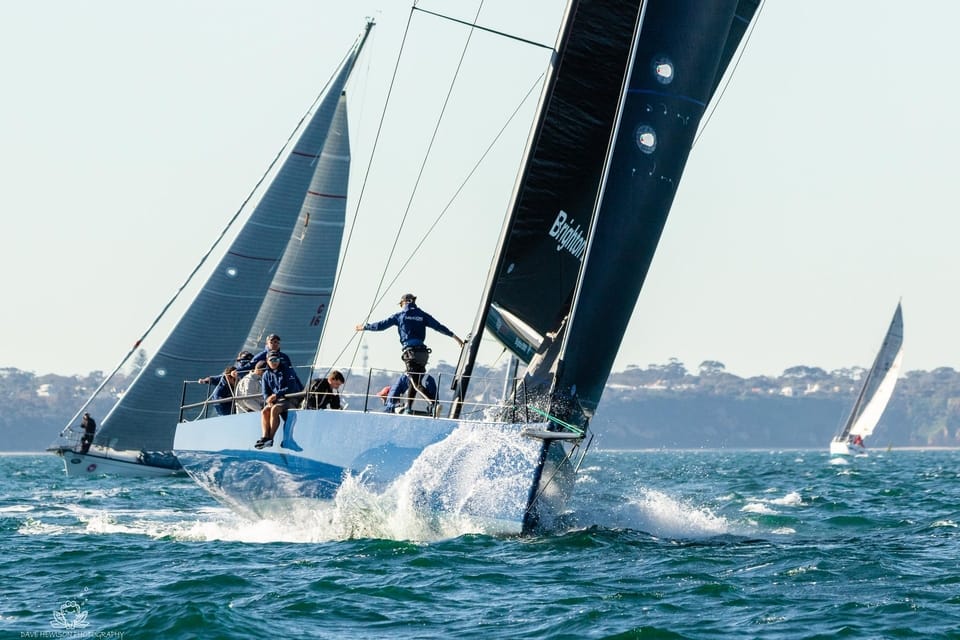
The best feature of catamarans is that all of the rooms are on the same level. The four-cabin arrangement is common with sailing cats and is popular among charter companies. Owner versions usually feature three staterooms, with one hull serving as a big cabin for entertaining. Most catamarans have a big central living room with not one, but two narrow staircases leading down into the hulls—one on each side. It’s a little like living in a tube in the hulls. They’re too thin to accommodate walkaround double/queen berths like those found in monohulls. But, in case of an emergency, it would be impossible to communicate with someone in the opposite hull.
Obviously, a monohull has less space than a catamaran. This is due to the fact that a cat is broader and has a larger deck surface. It also has twice as many hulls as the other, giving you greater total space between them. People who want to host parties on their boats will appreciate the extra space. The catamaran is usually the party boat of choice at the docks, according to most boat owners. Even if you don’t like to host parties, the extra room might be useful for lounging on the balcony or tanning. The boat’s large open space also makes it simple to utilize as a fishing platform.
You also have more room for equipment like surfboards, rafts, and other equipment that can easily clutter a monohull’s deck. Even fishing from a catamaran can be easier because the deck allows for plenty of space between anglers. Owners of catamarans also have more room for carrying fresh water and installing generators and solar panels. A catamaran’s interior room is often larger, and in luxury catamarans, it’s easier to install heavy appliances like washers and dryers inside. These can be fitted to larger monohulls as well, though it will be more difficult than on a catamaran.
All of the extra space, on the other hand, means the catamaran owner has more room to maintain and clean. Furthermore, all of the other stuff that can be brought into the boat will add to its weight . And, as well all know, a heavier boat will consume more fuel and move at a slower speed.
Maneuverability
With their twin motors, catamarans are incredibly agile . On a catamaran, the engines are widely apart, making navigating more easier and more precise than on a monohull, unless the monohull incorporates a bow thruster. Most of the time, a bow thruster isn’t required because the engines are around 20 feet apart. When there’s no bow thruster (as do few monohulls) you have to rely on prop-walk and prop wash on the rudder. On her own axis, a contemporary catamaran can turn 360 degrees. A monohull would be unable to accomplish this while it has a larger turning circle.
A monohull under sail, on the other hand, is far more maneuverable and will tack much faster than a catamaran. But, the ease of movement under motor on a catamaran, especially in close quarters, is substantially superior. They also feature shallow drafts , allowing you to maneuver into areas that a monohull cannot, as well as anchor closer to shore . However, monohulls are more maneuverable as you don’t have to deal with two hulls. They can make sharper turns and travel through small channels and small areas easier than cats. In addition, their hull displacements lessen the negative impacts of crosswinds in confined spaces.
Anchoring and Docking
While docking a catamaran is simple, its big size makes it difficult to fit into a standard slip. However, with some skill and good planning, finding room should be no problem. You may even anchor or moor the boat and dock it with the dinghy, which is much easier than a monohull. However, keep in mind that in most cases docking, hauling, and slipping a monohull is significantly easier, takes up less room, and is far less expensive.
Moreover, docking a catamaran can be a challenging task. This is due to the fact that catamarans are frequently too wide to dock in the marina’s core regions. As a result, they must be docked at the far end of the dock. Therefore they have fewer docking options and raise the cost of docking. Owners of catamarans sailing through places where there aren’t many catamarans may find it difficult to find a dock at all. This is especially true in the northern Atlantic, where monohulls outnumber catamarans.
Keep in mind that one of the most significant advantages of a sailing multihull is its stability . Not only at sea, when heeling simply does not – or should not – occur to any significant extent, but also at anchor. It also greatly expands one’s anchorage options to include areas influenced by the swell. This is quite common in the Caribbean, where a slight shift in wind direction may make a previously flat, quiet anchorage intolerable in a monohull. In addition, its fairly shoal draught expands the options even more.
Catamarans have a large platform, making them ideal for relaxing at anchor without the rolling motion that monohulls are prone to in a swell. Many monohull sailors had to leave anchorages because of the uncomfortable anchoring. This is because large rollers or swells entering an anchorage can make the situation extremely uncomfortable and dangerous.
Also, a bridle is tied to both bows and down to the anchor chain on catamarans , resulting in a fairly secure position at anchor . In heavy winds, many monohulls tend to sail at anchor since the bow acted as a sail (due to the high freeboard). They sail in one direction until the chain snatches, then tack across and sail in the opposite direction, almost completely dislodging the anchor. The catamaran, on the other hand, is much more stable at anchor and does not sway as much.
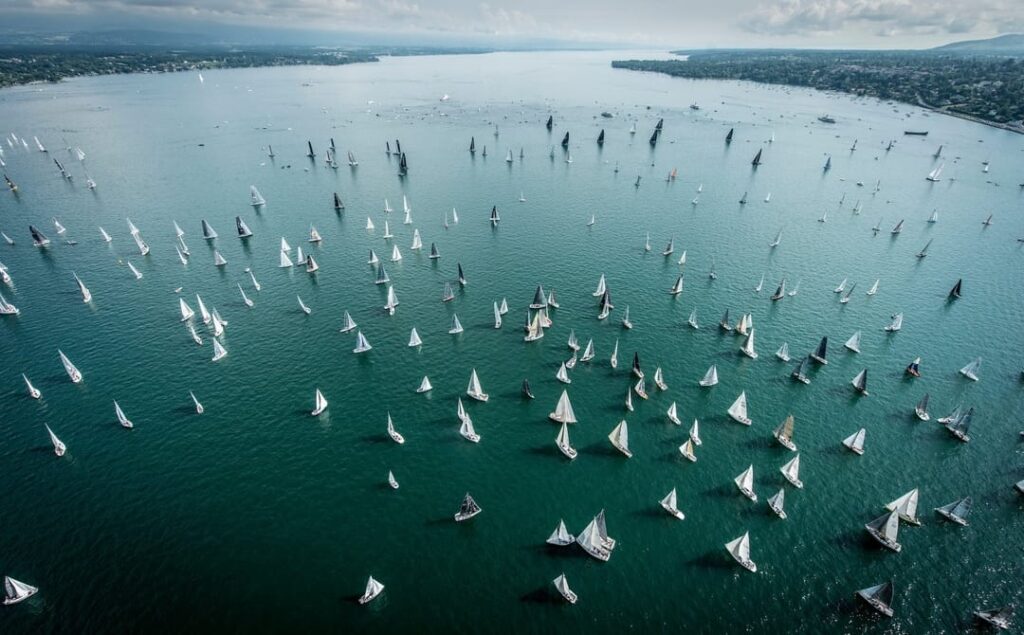
Sailing Abilities
Most cruising multihulls won’t point like a monohull with a deeper keel upwind, and the motion may be rather unpleasant when sailing in rough weather. You must also keep a close eye on the sail area, but we’ll analyze this further below.
Moreover, catamarans are not suitable for racing and sailing sports. They can be fantastic for a holiday or even living aboard, but most racers would never buy one because of the stability. There is no sense of wind, waves, flying, or the boat itself on a catamaran. It’s quite tough to tell when it’s time to reef. While this can be done by feel on a monohull, there is specific instruction for catamarans as to what winds the sail area should be reduced.
When sailing to higher latitudes, like the North Atlantic, then a monohull would be a better solution than a catamaran. Residential areas are easy to heat and keep warm, and traditional metal may even melt thin ice. The contrary is true in the tropical zone, where huge catamaran salons would be unbeatable.
Monohulls can sail higher into the wind than most catamarans due to their keel. Daggerboards, which serve the same role as a keel and boost windward performance significantly, are common in some catamarans. However, daggerboards are not seen on 95 percent of cruising cats (those available for charter). Also, a monohull will be much easier to tack than a catamaran and glide lightly through the water. Moreover, in rougher seas, certain catamarans experience an annoying slapping of water on the bridge decks. A monohull responds to the helm more quickly than a multihull (in other words, they turn faster). This is due to the fact that most cruising cats have small “spade rudders” whose depth is dictated by the need for a modest draft. While with a keel, a monohull can have a more responsive rudder for its draft.
Monohull spreaders are 90 degrees to the mast, however, catamaran spreaders must be backswept. The reason for this is that a monohull has a backstay, and by combining it with the intermediates, you can achieve a lovely pre-bend in the mast. Keep in mind that the pre-bend is to flatten out the mainsail and allow for better performance.
Also, in order to pre-bend the mast on a catamaran without a backstay, you’ll have to utilize the backswept spreaders and diamonds. The reason I bring this up is that if you want to broad reach or run on a catamaran, you can’t let the mainsail out all the way because the backswept spreader tips could puncture the cloth. Because the spreaders on a monohull are at 90 degrees, you can let the main and boom out much wider, which is obviously more effective. This is one of the reasons why a catamaran should broad reach and tack downwind.
- Maintenance
Because catamarans have two of everything, there is a clear trade-off between maintenance costs, reliability, and redundancy. One of the most significant advantages of having two of everything is that you have a backup . As a result, even if one component fails, you can typically still utilize the boat, such as running on one engine while the other fails. While redundancy is fine, lower maintenance and repair costs are generally preferable. Although having two of everything provides you some redundancy, I doubt you’ll want to take the boat out if one of the two hulls “fails.” Of course, this means two hulls to clean and antifoul, double the engine maintenance, and so on , but having two of the important pieces of equipment, such as engines, outweighs the disadvantages.
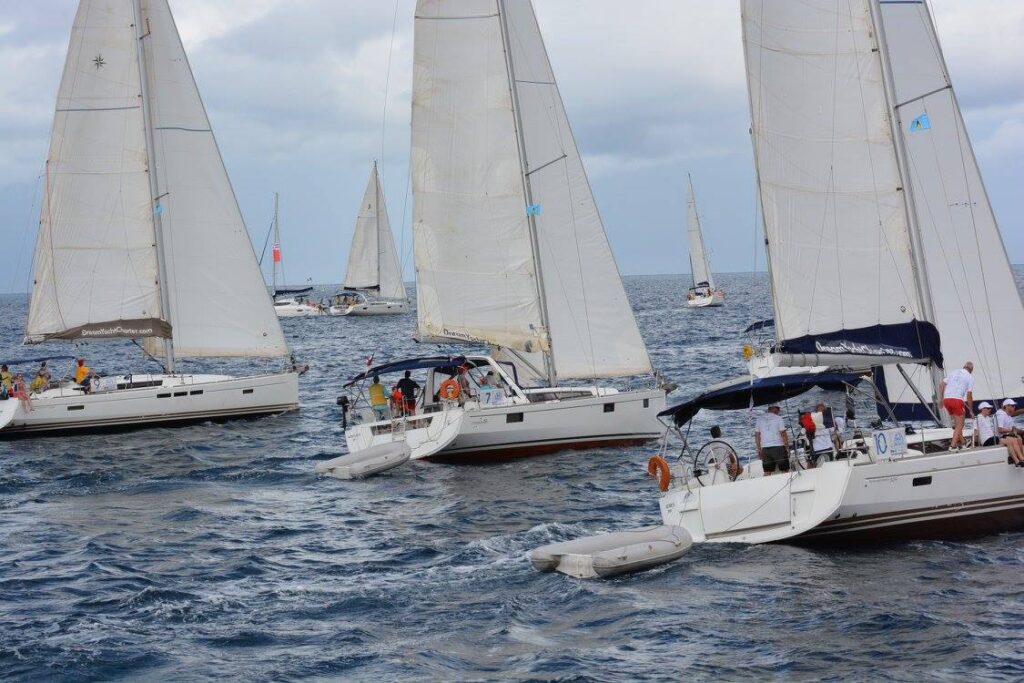
Due to their weight-bearing, catamarans have minimal to no heeling and do not roll at anchor. With sudden gusts, heeling on a monohull can be dangerous and uncomfortable, not to mention seasickness. Again, the trade-off is a noisy ride and fast movement, which many people find uncomfortable in bad weather. However, the heeling action of a monohull sailboat offers stability, spills wind from the sails, and provides safety.
Catamarans, unlike monohulls, do not have ballast in their keels, therefore they rely on beam and buoyancy for stability. Typical cruising catamarans have a beam-to-length ratio of around 50%, while several modern designs exceed this figure. A 45-foot catamaran will be around 22 feet wide, offering a highly solid sailing platform. Monohulls, unlike catamarans, cannot overcome rolling and pitching because of their narrow beam and lead ballast.
Rolling and pitching on a monohull while underway is quite dangerous. But, walking around on the deck of a catamaran while underway is easier because the boat is considerably more stable and does not heel. Sail adjustments and reefing are also significantly easier and safer for the crew as a result of this. The risk of falling overboard on a catamaran is far lower than on a monohull because of the rolling and pitching motion.
Generally, buying a catamaran is substantially more expensive than a monohull. So, if you opt for a cat you should also consider your budget before even starting your research. Pre-owned monohulls, on the other hand, are extremely inexpensive to purchase due to a current supply that considerably outnumbers the demand.
Nowadays, catamarans are in high demand , and they normally keep their worth far better and longer than other types of boats. And that’s why the market is currently centered to manufacture lots of them. Bear in mind that looking for a catamaran under $250,000 your options will be limited, and finding a catamaran under $100,000 is nearly difficult. Unless you opt with older boats like the Prouts or the less priced Geminis, a monohull is your best bet in this instance.
The cost of a cat rises if you need at least two of everything. But, keep in mind that due to their popularity, catamarans have a high resale value and a low depreciation rate , and they normally sell faster than monohulls. Due to the fact that most catamarans are not made in the United States, delivery expenses must be considered when purchasing the boat. Multihulls are becoming more popular, and as a result of the increased demand, they command greater prices in both the new and brokerage markets. Lastly, when considering a purchase, keep in mind that maintenance costs are substantially higher than on a monohull.
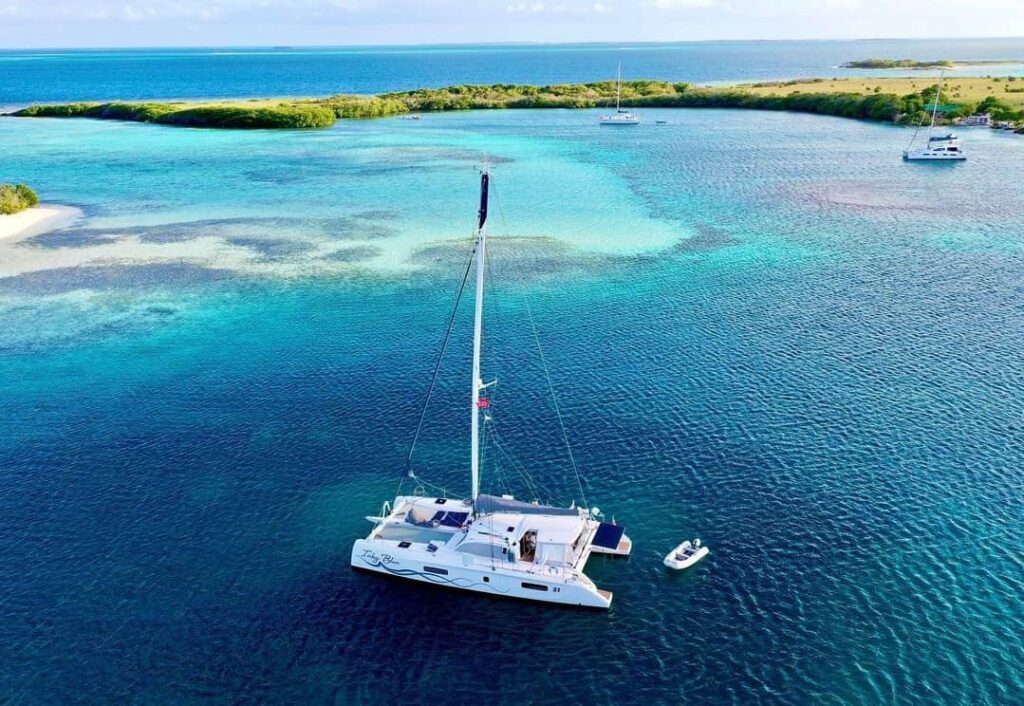
Catamarans vs Monohulls – The Bottom Line
So, this is it! We’ve come to the end of this highly discussed topic among sailors. Obviously, everything would be determined by two basic factors: personal preferences and budget considerations. Both monohulls and multihulls have their pros and cons and it’s totally up to you to decide which one suits you best. Because the two types of vessels provide such a different experience, it is highly recommended that you rent and test each one before purchasing to compare everything. In any event, it’s reasonable to say that a catamaran is an excellent choice for a charter, if not for purchase. Despite its high price, it provides comfort, space, and stability but you have a better overall sailing experience with a monohull. So, I hope that this article will help you make the right choice according to your needs. I wish you good luck with your research!
Peter is the editor of Better Sailing. He has sailed for countless hours and has maintained his own boats and sailboats for years. After years of trial and error, he decided to start this website to share the knowledge.
Related Posts

The Ultimate Guide to Choosing the Best Fishing Line for Trolling

Lagoon Catamaran Review: Are Lagoon Catamarans Good?

Best Inboard Boat Engine Brands

Are O’Day Sailboats Good? A Closer Look at a Classic Brand
- Buyer's Guide
- Destinations
- Sailing Info
Hit enter to search or ESC to close.
Catamaran Show.com
Catamaran vs monohull: choosing the right sailboat for your adventure in 2024.
In the world of sailing, few debates are as passionate and enduring as the catamaran vs monohull showdown. As we sail into 2024, this discussion continues to evolve, shaped by advancing technology and changing sailor preferences. But which vessel truly offers the best experience for modern sailors? Let's dive in and explore the pros and cons of each, helping you navigate the choppy waters of this age-old debate.

The Rise of the Multihull: The Catamaran's Case
Speed demons and safety champions.
Catamarans have earned a reputation as the speedsters of the sailing world, and for good reason. With their twin-hull design, these vessels can reach impressive speeds, especially when sailing downwind or on a beam reach. This speed isn't just about the thrill – it's a crucial safety feature. The ability to outrun bad weather can be a game-changer in open waters.
But speed isn't the only safety advantage. Catamarans offer exceptional stability in rough seas. Their wide stance minimizes rolling and pitching, creating a more comfortable ride and reducing the risk of seasickness. Plus, modern catamarans are designed to be virtually unsinkable due to their lack of ballast and buoyant hulls.
Space: The Final Frontier
Step aboard a catamaran, and you'll immediately notice one thing: space, and lots of it! The wide beam of a catamaran translates to expansive living areas both above and below deck. Imagine a spacious saloon with panoramic views, a cockpit that's perfect for al fresco dining, and cabins spread across two hulls for added privacy.
This abundance of space isn't just about luxury – it's practical too. A stable platform makes daily activities like cooking, sleeping, and moving around much easier while underway. Long passages become less taxing on the crew, reducing fatigue and stress.
Shallow Waters and Sweet Anchorages
One of the catamaran's secret weapons is its shallow draft. This feature opens up a world of cruising grounds that deeper-keeled monohulls can only dream of. Imagine anchoring close to that perfect beach in the Bahamas or exploring coastal nooks that other boats can't reach.
When it comes to anchoring, catamarans shine again. Their wide beam provides excellent stability at anchor, significantly reducing the rolling that can make life aboard uncomfortable. And let's not forget about dinghy management – most catamarans come with dedicated davits, making it easy to launch and retrieve your tender.
Maneuvering Marvel
Twin engines on a catamaran aren't just about redundancy (though that's a nice safety feature). They provide incredible maneuverability, especially in tight spaces. Imagine being able to spin your boat in place or slide sideways into a slip – it's all possible with a cat.
Modern catamaran designs have also made significant strides in sailing performance. While they may not point as high into the wind as some monohulls, the gap is closing. With features like daggerboards and efficient sail plans, today's cats can hold their own in a variety of conditions.
The Classic Choice: The Case for Monohulls
A true sailing experience.
For many, sailing is as much about the journey as the destination. Monohulls offer a sailing experience that's hard to beat. The heel of the boat as it cuts through the waves, the direct feedback from the wind and water – it's sailing in its purest form.
Monohulls generally excel in upwind performance, pointing higher into the wind and tacking more efficiently. This can make a big difference on long upwind passages or when navigating narrow channels.
Friendly on the Wallet
When it comes to cost, monohulls often have the upper hand. Generally, you'll get more boat for your money with a monohull, both in terms of length and features. This is especially true in the used boat market, where there's a much wider selection of monohulls available.
Marina fees can also be more wallet-friendly for monohull owners. Most marinas are designed with monohulls in mind, meaning you won't face the surcharges or limited availability that catamaran owners sometimes encounter.
Maintenance Made Simple
With just one hull, one engine, and generally simpler systems, monohulls can be easier and less expensive to maintain. When it comes time for a haul-out or repairs, you'll have more options available. Almost any boatyard can accommodate a monohull, which isn't always the case for wider catamarans.
Heavy Weather Heroes
When the going gets tough, many sailors feel more confident in a monohull. Their ability to self-right after a knockdown provides an extra layer of safety in extreme conditions. Monohulls have a long track record of handling heavy weather, and traditional storm tactics like heaving-to are often more effective on a single hull.
Choosing Your Perfect Vessel: Factors to Consider
Know your mission.
Are you planning coastal cruises or blue water passages? Family vacations or long-term living aboard? Your intended use should be a primary factor in your decision. Catamarans might edge out for family cruising and living aboard, while monohulls could be preferable for serious offshore work or single-handing.
Crunch the Numbers
Don't just look at the purchase price – consider the total cost of ownership. This includes maintenance, marina fees, insurance, and potential resale value. While catamarans are often more expensive upfront, they tend to hold their value well.
Skills and Thrills
Consider your sailing experience and what kind of sailing you enjoy. If you love the feel of a heeling boat and hands-on sail trimming, a monohull might be your match. If you prioritize comfort and ease of handling, a catamaran could be the way to go.
Crew Comfort
Think about who you'll be sailing with most often. Large families or those who frequently sail with guests might appreciate the space and privacy a catamaran offers. Solo sailors or couples might find a monohull more manageable and cozy.
YouTube Sailors: The Monohull to Catamaran Transition
An interesting trend in the sailing world is the shift many popular YouTube sailing channels have made from monohulls to catamarans. This transition provides real-world insights into the benefits and challenges of both types of boats. Let's look at some well-known examples:
Sailing SV Delos :
Before: Amel Super Maramu 53 (Monohull)
After: Delos 2.0 (Custom Catamaran) The Delos crew, known for their extensive blue water sailing, made the switch to a custom-built catamaran, citing the need for more space and comfort for long-term living aboard.
La Vagabonde :
Before: Beneteau Cyclades 43.4 (2007) (Monohull)
After: Outremer 45 (Catamaran) Riley and Elayna, who started their journey on a monohull, upgraded to a performance catamaran as their family grew, valuing the additional space and stability.
Sailing Zatara :
Before: Beneteau 55 (Monohull)
After: Privilege 585 (Catamaran) The Zatara family moved to a large luxury catamaran, emphasizing the importance of space and comfort for full-time family living aboard.
Sailing Ruby Rose :
Before: Southerly 38 (Monohull)
After: Seawind 1370 (Catamaran) Nick and Terysa made the switch after extensive monohull sailing, attracted by the catamaran's space, stability, and shallow draft capabilities.
Sailaway World Sailing :
Before: Hunter 46LE (Monohull)
After: Privilege 482 (Catamaran) This transition showcases the appeal of catamarans for long-term cruising and living aboard.
Sailing With Six :
Before: Dufour Gibsea (Monohull)
After: Leopard 46 (Catamaran) For this family of six, the move to a catamaran was driven by the need for more space and the stability offered by multihulls.
What This Trend Tells Us
The shift from monohulls to catamarans among these popular sailing channels highlights several key points:
Growing Families : Many of these sailors transitioned as their families grew, valuing the additional space and privacy catamarans offer.
Long-Term Living : For those living aboard full-time, the comfort and stability of catamarans became increasingly attractive.
Performance vs. Comfort : While many started with performance-oriented monohulls, the balance of performance and comfort offered by modern catamarans proved appealing.
Evolving Needs : As these sailors gained more experience and their cruising goals evolved, their boat preferences changed accordingly.
Technological Advancements : The improvement in catamaran design and performance has made them viable options for serious blue water cruising.
It's important to note that while this trend is significant, it doesn't mean catamarans are universally superior. Each of these sailors made the choice based on their specific needs, experiences, and future plans. Their journeys serve as valuable case studies in the monohull vs. catamaran debate, offering real-world perspectives on the strengths and trade-offs of each boat type.
For aspiring sailors or those considering a switch, these YouTube channels offer a wealth of information about the transition process, the advantages they've found, and the challenges they've faced. It's a testament to the evolving nature of the sailing world and the diverse options available to modern sailors.
The Verdict on Catamaran vs Monohull: It's Personal
In the end, the choice between a catamaran and a monohull comes down to personal preference, sailing style, and intended use. Both types of boats have their strengths and weaknesses, and both can provide incredible sailing experiences.
The good news? The gap between catamarans and monohulls is narrowing. Advances in design and technology mean that modern catamarans are becoming better sailors, while many new monohulls are offering more interior volume and stability than their predecessors.
My advice? If possible, try both. Charter a catamaran for one vacation and a monohull for another. There's no substitute for firsthand experience when making such an important decision.
Remember, the best boat for you is the one that fits your specific needs, sailing style, and dreams. Whether it's a monohull or a catamaran, the most important thing is that it gets you out on the water, exploring the world and creating unforgettable memories.
Remember, the best boat is the one that gets you out on the water, enjoying the wind in your sails and the horizon ahead. Whether you choose two hulls or one, the adventure of a lifetime awaits. Happy sailing!
Recent Posts
Top Features of a Sailing Catamaran: 10 Key Characteristics for Smart Buyers in 2024
HH44 Ocean Cruiser Review: Redefining Performance Cruising Catamarans
Hoisting Your True Colors: Are You Born to Daysail, Liveaboard, Charter, Cruise or Circumnavigate?
- Articles and Guides
Catamaran vs Monohull: The Great Sailboat Debate
16th jun 2023 by john burnham.

Do you love the natural sounds of water sliding past the boat’s hull and a breeze blowing across your rigging and sails while gliding ahead powered only by the force of the wind? If yes, you are well-suited to spending plenty of time on a sailboat, like so many generations of boat people before you.
But do you take your lead from the Egyptians who rigged sails on their boats built of reeds along the Nile River or follow the path of the Polynesians, who used an outrigger for extra stability and sailed from one Pacific island to the next in the earliest catamarans?
The question of which is better for sailing, one hull or two, has been a matter of debate over thousands of years. Today, let’s explore these two basic types of sailboat, and while we may not settle the argument once and for all, hopefully in the process you will begin to discover which option is better for you.
What Are the Differences Between Catamaran and Monohull Boats?
The monohull and the catamaran (often referred to as “cat”) are the two most common categories of sailboats, and of the two, the monohull far outnumbers the catamaran in popularity due to its simplicity and sturdiness. Advocates of the catamaran, however, are typically even more convinced than monohull sailors that their boats are best due to performance potential and overall spaciousness.
What are catamaran-style boats?
Catamarans are easily identified by their two-hull design. Two hulls sit side by side with an interconnecting deck or structural beams across the bap in the middle. Catamarans have been around since Pacific Islanders and other Austronesian people sailed them centuries ago, and they continue to gain popularity in a wide range of designs both as high-performance racing boats and ocean-cruising designs.
Although not part of this debate, a third sailboat type comparable to a catamaran is a trimaran. Trimaran sailboats are constructed similarly to catamarans but have three parallel hulls rather than two. Collectively, catamarans and trimarans are referred to as multihulls, and sailors of both types often refer lightheartedly to monohulls as “monomarans.”
What are monohull-style boats?
Monohull sailboats are the most common boat type because they feature a single hull, typically with a single mast and two sails. Rather than maintaining stability with a second hull creating a wider beam, monohull boats usually carry lead or other heavy ballast in their keel, or are stabilized by human weight as their crews lean out to counter the force of the wind. Monohulls can also be excellent racers and cruisers, depending on their size, volume, sail area, and displacement or weight.
Where Catamarans and Monohulls Excel
Each type of boat has its advantages, depending on what the owner wants in a boat. Here are the main advantages of each type.
Catamaran advantages
• More space . Catamarans have greater beam for a given length, which provides more space for the crew on a daysailer and larger living quarters on cruising designs, which are often laid out with berths in each hull and living quarters across the bridgedeck between hulls.
• Faster hull . If they are light enough, the sleeker shape and reduced wetted surface of two narrow, shallow hulls can produce quicker straight-line sailing speed than a single, deeper and wider hull.
• Comfort and stability . Two hulls provide better initial stability and generally heel less than monohulls, especially in light- or medium-strength winds and waves.
Monohull advantages
• Upwind sailing . When sailing against the wind, monohulls often sail at a closer angle to the wind and arrive more quickly at their destination.
• Easier motion . Heavier monohulls often have a slower, gentler motion in waves than a lighter catamaran.
• Load carrying capability . A monohull’s performance is reduced less than a catamaran’s when the boat is loaded heavily with cargo or crew.
• Righting characteristics . Larger monohulls have weighted keels that provide increased resistance to a capsize when the boat is heeled far over by wind or a wave and if capsized will return the boat to an upright position.

Catamaran vs. Monohull Sailing Speed
There are several reasons why a catamaran is often faster than a monohull boat. These include the fact that most catamaran hulls have less water resistance than monohulls, they are often lighter, and they can be more easily driven by a relatively small sailplan. At similar lengths, a catamaran can be dramatically faster than a monohull under similar sea conditions. However, weight is the enemy of a catamaran’s speed; a heavy or heavily loaded catamaran may be much slower than a lightweight monohull.
Catamaran vs. monohull power
A monohull under auxiliary power may be faster than a catamaran in certain conditions, like powering against a strong wind. In other wind and wave conditions, the catamaran is often faster. Also, with an engines on each hull, the cat is often much more maneuverable in close quarters or at the marina. While it may seem counter-intuitive, turning and controlling the boat is often less challenging than when sailing a monohull boat with the typical single engine. Monohull boats require more finesse when in tight quarters like berthing in a marina.
Catamaran vs. Monohull Efficiency
A sleek monohull may sail against the wind super efficiently, pointing close to the wind and making an excellent speed. However, the power-to-weight ratio of the catamaran allows it to make good use of whatever wind it has. Some fast, light catamarans can travel at speeds equal to or faster than the wind, something very few monohulls can achieve. When the wave action increases and you start sailing into the wind, the catamaran may lose its advantage, and in strong winds, the greater windage of the wide catamaran may have a pronounced slow-down effect compared to the sleeker monohull.
Catamaran vs. Monohull Stability
Despite not having a weighted keel, a catamaran design is able to avoid heeling over in strong winds or bad weather due to its greater width or beam. As a result, the multihull also tends to be more stable at anchor and any time in calmer seas. However, if the winds are strong and the waves are large, a monohull, with its keel weight and ability to sail against the wind while controlling the sails, is sometimes the steadier of the two types. While a monohull with weighted keel can be knocked down by strong gusts of wind, it will only capsize in extremely large waves. Likewise, a cruising catamaran can only capsize in large ocean waves, unless it is a fast, lightweight catamaran, that can more easily tip over in gusty winds and waves.
Catamaran vs. Monohull Safety
Power catamarans and power monohulls are relatively comparable in terms of safety. But depending on the size of the mast and sails, the weight of the boat, and the wind and wave conditions experienced, many sailors believe that a monohull configuration is safer than a catamaran for a sailboat. That’s mainly because while a monohull will initially heel over further in a strong gust of wind, the weight of its keel provides increasing stability as described above and if completely capsized, the keel typically helps the boat self rescue.
It should be clarified that many sailing catamaran designs are conservatively configured and difficult to capsize except in extreme ocean wave conditions—and the same can be said for larger power catamarans.
In terms of ultimate safety in the event of a capsize, however, the catamaran is considered safer because even should it turn once upside down, even if damaged, the catamaran with its two hulls and minimal ballast typically remains buoyant and provides a safer configuration in which to await rescue. By contrast, if a monohull’s hatches and port windows suffer damage in a knockdown, the boat can more quickly take on water and, weighed down by its keel or other ballast, be more difficult to keep afloat in extreme conditions.
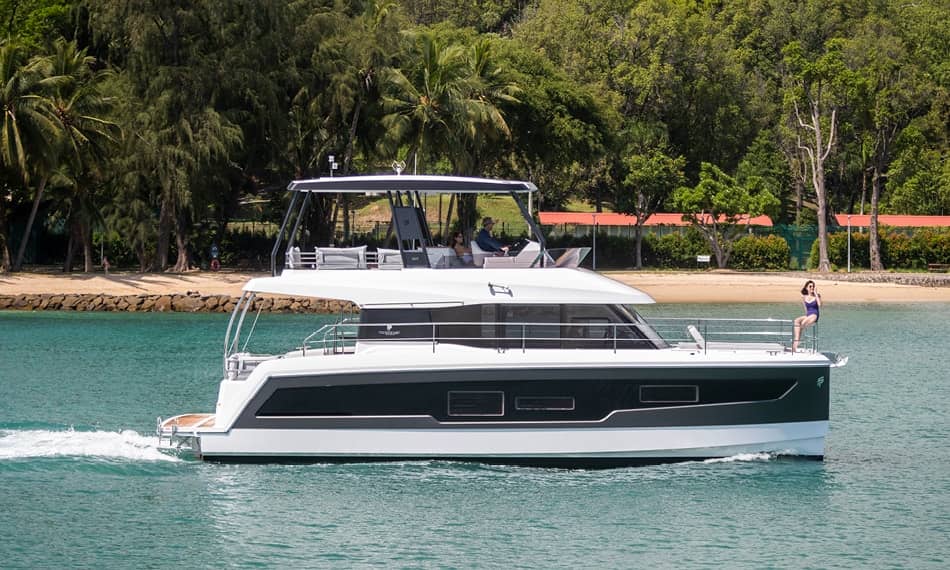
Photo credit: Fountaine Pajot
Monohull vs. Catamaran Maintenance
Depending on size, age, and type of hull construction, maintenance costs will vary, but when comparing two fiberglass sailboats of similar length, the catamaran typically costs more to maintain. That’s because there are two hulls to care for, two engines, connecting structures that align the two hulls, and an overall larger boat due to the catamaran’s greater beam. Hauling and launching a catamaran can be more expensive at many boatyards, as well.
However, smaller catamarans of about 20 feet in length or less are often more comparable and sometimes cheaper to maintain than a similar length monohull. That’s because cats are often lighter and suitable for keeping on a trailer rather than in a slip or on a mooring.
Catamaran vs. Monohull Cost
Compared to similar length monohulls, a catamaran will likely cost more than a monohull boat. That’s mainly because when you purchase a 40-foot catamaran, you are buying two hulls and two engines, but you are also buying a bigger boat that typically has much more volume. In the case of a 40-footer, you end up with a boat that has a large saloon and three or four private cabins, whereas in the monohull, the saloon is smaller and you’ll have three smaller sleeping cabins. Annual maintenance will also be greater, as described above.
Among smaller catamarans and monohulls, pricing will vary, and a lightweight beach cat may be less expensive than a heavier monohull keelboat of similar length.
Catamaran vs. Monohull, Pros and Cons
Depending on a variety of factors, there are plenty of catamaran and monohull pros and cons. These are some to keep in mind when comparing the two boat types.
Catamaran pros
• Comfort . On a cruising designed catamaran, two hulls with a wide beam create a stable and comfortable living environment with open spaces and plenty of standing room.
• Speed . Smaller, lighter catamarans are speed champions, especially in a moderate wind and modest waves. Cruising cats are often fast when sailing at reaching angles.
• Maneuverability . When equipped with two engines, a catamaran is highly maneuverable under power.
Monohull pros
• Upwind sailing . Although catamarans are often faster when sailing in a straight line, monohulls typically perform better against the wind.
• Self-righting . Except for unballasted monohulls that rely on crew weight for stability, the ballasted keel of a monohull prevents capsizing in most circumstances and the keel makes the boat self-righting.
• Maneuvering under sail . Monohulls turn more easily due to their shape, maneuvering in close quarters or tacking when sailing against the wind.
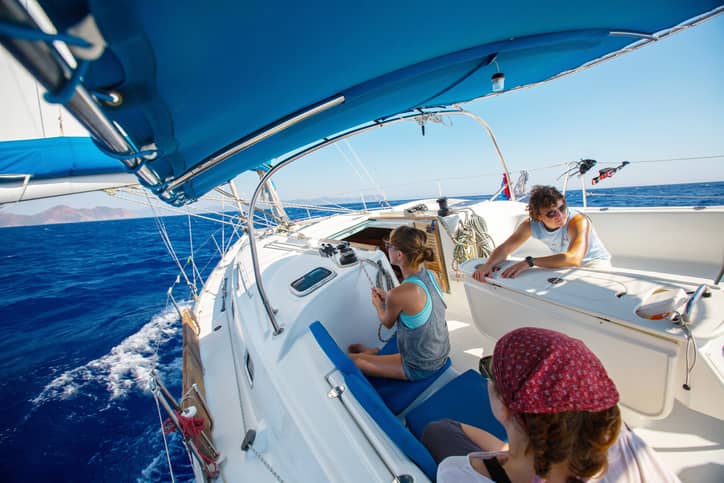
Catamaran cons
• Lack of feel when steering . Except in lighter, more performance-oriented catamarans, the broad platform with two rudders and two hulls sometimes isolates the sailor and provides little feedback through the helm when under sail.
• Sailing against the wind . Upwind sailing is generally not a catamaran’s best point of sail, but its straight-line speed can be such that it may arrive quickly at its destination, even though you will have traveled much farther than in a monohull.
• Pricing . Catamarans are typically more expensive than monohull boats due to their two hulls and other required build components and complexity.
• Not self-righting . Thanks to its wide beam and two-hull design, a catamaran is more difficult to flip, but it is not designed to right itself except for small beach cats where the crew can use their weight to re-right the boat.
Monohull cons
• Weight . Most monohulls have thousands of pounds of weight in the keel for ballast that is vital to its stability but can degrade performance.
• Wave motions . Monohull boats are much more susceptible to rolling wave motions.
• Cabin . With the monohull cruising design, you'll typically find a darker interior with smaller port windows and fewer space options.
• Heeling effect . Monohulls will heel over in a moderate wind, which is normal but often uncomfortable for newer sailors.
Written By: John Burnham
John Burnham is a marine editor and writer with decades of journalism experience as Chief Editor of boats.com, Sailing World, Cruising World, and other boating websites. As a competitive sailor, he has led teams to world and national titles in the International One-Design, Shields, and other classes. Based in Newport, Rhode Island, John is a PCC leadership coach, a member of the America’s Cup Hall of Fame Selection Committee, and a past board member of Sail America and US Sailing. For more, see johnsburnham.com .

More from: John Burnham
Related Articles and Guides
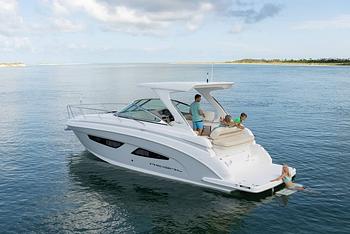
6th Sep 2024
The Best Mini Yacht Brands for Cruising and Luxury
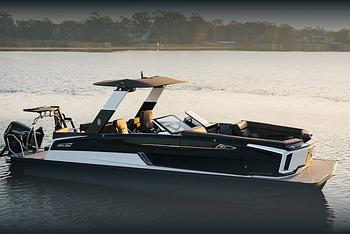
16th Aug 2024
Best Luxury Pontoon Boat Brands Have it All: Glamor, Speed, Fishing, Waterslides...
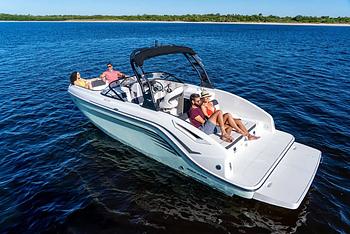
10th Aug 2024
Deck Boat vs. Bowrider: Which Runabout is Best?

19th Jul 2024
The World’s Best Yacht Brands

- Explore Rightboat
- Boats for Sale
- Boating Articles
- Buyers Guide
- About RightBoat
- Sell Your Boat
- Boat Selling Advice
- All manufacturers
- All categories
- Are you a broker/dealer?
- Learn more about the Rightboat:HUB
Enter your email to keep up to date with the latest news
Join for free
Sign up now for free and discover how easy it is to keep up to date with THE latest boats for sale. Find your right boat, and tailor your voyage to finding your next boat.
Benefits of becoming a member:
- Set up tailored alerts
- Personalise your experience
- Download full specifications and broker details
- Keep tabs on your favourite boats
Are you a broker? Join as a Broker
Rightboat - join for free.
Do you have an account already? Login
Save this search
Save your search and receive new boats in your email..
You can unsubscribe from your alerts whenever you like. By pressing the button you accept the Legal Terms and conditions
Catamaran vs Monohull – Which is Better?
Which is better a catamaran or a monohull.
I’m often asked by my students why one would choose a sailing monohull or a sailing catamaran for their adventures. The simple answer is: There is no simple answer — it depends on a lot of things, perhaps the most important one is your preference. “Yeah, well, this is my first week sailing ever, so how do I have a preference?” Let’s explore the differences and discuss the ins and outs of sailing, chartering, performance, and living aboard either vessel.
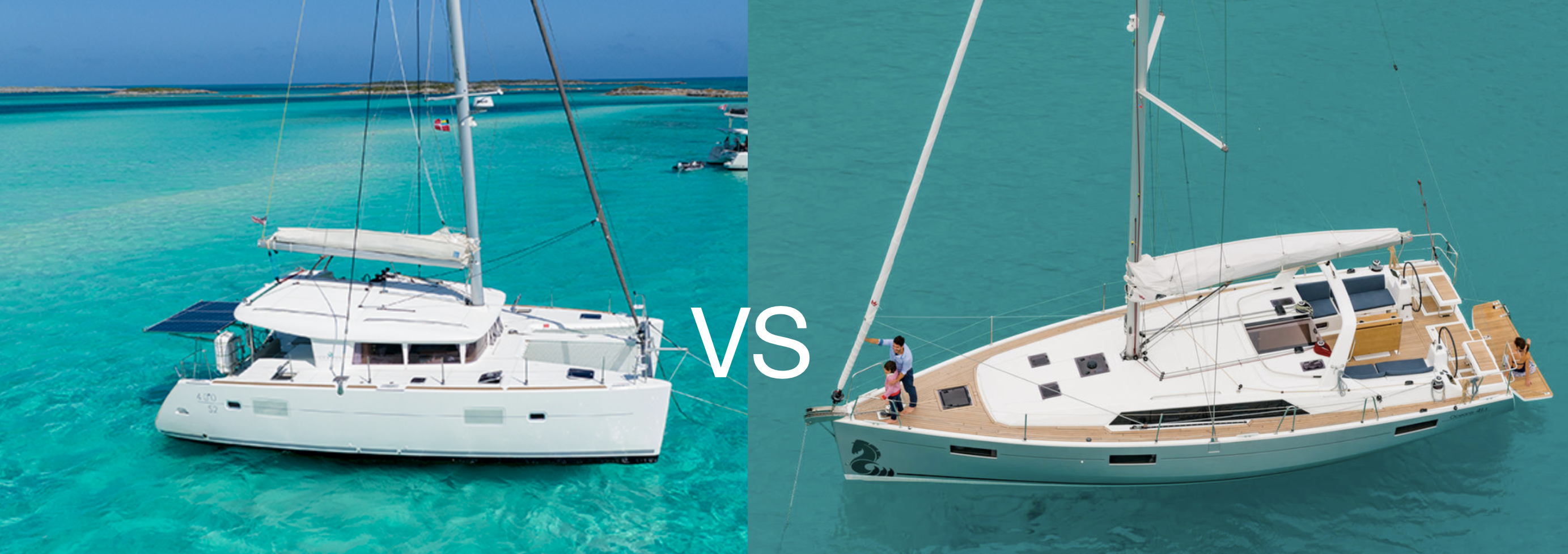
Notice that I don’t say “pros” and “cons” when considering the differences between the two vessels. To some, the gentle rocking of the monohull elicits nostalgia for a bygone youth spent sailing dinghies in the bay. To others, it represents sleepless nights, banging kitchenware, and angry spouses.
Short Summary – Catamaran vs Monohull
Generally, I describe my preference as follows: If I want to invite guests that are not frequently on the water, have less tolerance for “bumpy” nights, or expect a more “luxury” experience (you’ll see why I put it in quotes shortly) then I select a sailing catamaran. There is more room to spread out (vs the same length mono), rocking at anchor/mooring is minimized, and the kids love playing on the trampoline. Or perhaps phrased differently, “If you want to drink from beach to beach…”
DO NOT DRINK ALCOHOL WHILE OPERATING ANY VESSEL. EVER.
If, however, you want to put some miles down sailing from port to port in the Med (or wherever you have variable wind direction), then the mono is probably the better option. It has better upwind performance and costs less in marinas.
Let’s get into the details. We’re going to compare a suitable, common charter catamaran ( Lagoon, 40 ’) with a good, common charter monohull (Beneteau, 41’).
Sailing and Performance
The monohull total tacking angle is about 90-100 degrees apparent wind angle (AWA). This means that the closest close-haul sailing angle achievable is approximately 45-50 degrees off the wind. The comparable catamaran has a total tacking angle of about 110-120 degrees (55-60 degrees AWA off the wind). This loss is due to the extra leeway experienced in the catamaran. This is a significant difference when trying to beat to windward and can mean the difference between sailing the entire distance vs putting the sails up for show only. For those interested in math, the progress into the wind is determined by the cosine of the close haul sailing angle (angle of the wind) times the length of the leg on that tack.
windward distance = cosine(𝜶) x leg length
Where α is the close haul sailing of the vessel. Table 1 compares the windward distance achieved of 3 sailing angles over a leg length of 1 unit (nautical mile, km, etc). For example, if the leg length is 1 nm, and 7 legs are sailed, a total distance of 7 nm is covered. However, the progress to windward is not 7 nm, but
cosine(𝜶) x leg length = cos(45°) x 7 nm = 0.71 x 7 nm = 5.0nm
for a monohull sailing 45° to the wind, and 4.0 nm for a catamaran sailing 55° to the wind. The final difference after 7 tacks each is 1.0 nm, which would take the catamaran an additional 2 tacks (and just shy of 2 nm distance sailed) to make up the difference.
Table 1. Sailing Angle and Distance Comparison Sailing Angle (off the wind) Windward Distance Achieved % loss from 45°
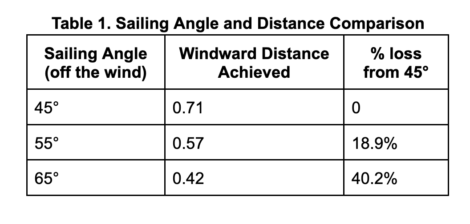
Figure 1. Sailing Angle Mono vs Cat
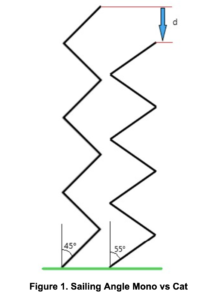
A real-life example
Sailing from Mallorca on a new Lagoon 40. We needed to sail directly upwind in about 20 knots of wind, 3 miles from Cala Mondragó to Cala D’Or. It took over 2 hours and we sailed over 7 nm. As you can see, the tacking angle is far from 90º typical to a monohull.
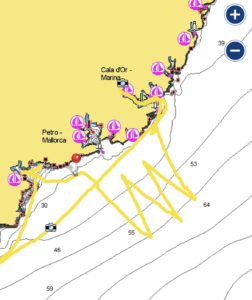
Additionally, the loss to each tack must be considered. Speed and headway is lost with each tack – the mono carries its momentum much better (minimal speed loss) through the tack and has minimal leeway loss compared to the catamaran. The cat loses a tremendous amount of its momentum and experiences significant leeway loss. And it has to take more tacks to make the same windward distance, rendering the loss greater than that just lost to having to sail a greater distance due to the tacking angle.
Daggerboards greatly reduce leeway and give catamarans excellent upwind performance on par with monohulls. There are reasons why all cats don’t just have daggerboards. Especially on charter boats, one mistake, leaving the boards down, in shallow water can destroy the boat.
Across the wind (most reaching situations), the catamaran is faster. Upwind, the mono makes better progress due to the tacking/sailing angle. Downwind is a competition.
Downwind is where catamarans really shine. The stability and smooth ride is no comparison to a monohull. We sailed Never Say Never, our Lagoon 400S2 from Hilton Head SC to Ft Lauderdale, we had a NE wind of 20-25 knots. For us to stay inshore of the Gulf Stream to avoid rough conditions, we were wing-on-wing for over 24 hours, surfing down gently at over 7 knots. We covered over 160 miles in 24 hours. Escorted by dolphins, this was one for the books —non-stop 3-day delivery.
Comfort & Stability
The catamaran doesn’t heel (well, it shouldn’t. I guess if that’s the case we’re having another conversation ). No heeling can mean easier walking about while underway: we’re all familiar with walking on level ground; walking with the ground at an angle is a less-common experience. However, there is an oft-missed discussion about the mono’s stability on a heel. Waves tend to roll under the mono’s hull. Once sea legs are found, the motion of the hull on the water is predictable and smooth.
The cat’s motion on waves tends to bounce between two “stable” states: one resting on the starboard hull, the other resting on the port hull. You get a slight, but sudden rock to starboard when the wave passes under the port pontoon, then a sudden return to port as the wave passes under the starboard hull. This tends to be a jarring motion all day. So while some argue that mono heeling is tiring, others will argue that this cat phenomenon is tiring. A sarcastic captain often says:
“One benefit of a cat, you get each wave twice!”
Each vessel has its own quirks for sail trim, so that is a wash. I can read a mono’s sails much easier than a cat’s, but I sailed monos for 20+ years before trying cats so I may be biased.
Catamaran vs Monohull Safety
The mono gives lots of feedback about being overpowered long before it becomes a problem: heel angle and weather helm are the loudest. The cat is much more subtle: mast and boom groans, light windward pontoon, lack of steerability. Experiment with the main traveller position and reefing on a schedule per the owners manual to find the optimum sail configuration on a cat.
When the seas pick up, catamarans do much better downwind. Monohulls tend to roll, yaw and wallow in the troughs and round up on the face of the waves. Catamaran’s tend to surf straight down the waves. A force 7-8 blow can be enjoyable. Stow your main and run with just the jib downwind on a cat and you’ll see the beauty and ease to steer this configuration.
“When the seas pick up, catamarans do much better downwind. Monohull’s tend to roll, yaw and wallow in the troughs”
Chartering and Living Aboard Considerations
Charter cost – cats are 30-60% more expensive than the equivalent mono.
In marinas, the cat rate is usually 50% greater than the mono rate. And, unless you get a reservation long in advance, they might not have room for you.
On moorings, depending on the bow cleat location, the mooring lines can run over or along portions of the hull of the cat. This leads to line stretch-and-relaxation noise all night long. For anyone in the forward cabins, this is a nightmare. Or worse since you can’t even get to sleep to have a nightmare.
Cats tend to have shallower draft and therefore can anchor closer to the beach. If wind and swell are from the same direction, cats tend to weather it better at anchor. Due to the bridle, cats do not swing on anchor. Older monos used to swing a lot, modern designs have reduced this swing tremendously.
There is lots more room on a cat to house the luxury amenities like A/C, water makers, and generators. Though, modern design is allowing for clever locations for these items in the mono, so there will probably be more monos becoming available with these options.
Cats tend to carry more potable water than the mono. They also carry more fuel. And burn more. Our weekly mono fuel bill ranges from $80-150 USD. Our weekly cat fuel bill ranges from $180-300 USD. (1.) Though you pay more for a catamaran, most systems are redundant. Two engines are better than one.
Catamaran vs Monohull Maneuverability
Cats are far easier to maneuver under power due to the two engines being separated by such a great distance. This makes picking up moorings, dropping and weighing anchor, and docking a breeze.
I would argue that monos are easier to manoeuvre under sail due to large rudders and heavy keels. The heavy keel maintains its momentum through manoeuvres much better than the cat. The large rudder means a small helm adjustment is quickly experienced in the respective heading. This large rudder also reduces steerage way to about 0.75-1.0 kts, whereas the cat is about 2.5 kts. While I doubt we’ll see cheaters , I mean bow thrusters, on 40’ monos, I have seen them on 44’ monos before. This added amenity makes up for greatly increased manoeuvrability while docking or weighing anchor.
Dinghy Storage
Storing the dinghy on the davits is a wonderful location for passages of any length. The reduced drag from not towing it is immediately seen in increased sailing speed. Monos must carry theirs on the bow or tow it astern. And you have to take the engine off too. Usually by hand, so you are not going to see a 20HP electric start engine on a dinghy for a 40’ mono. Not that you’d see that size for a 40’ cat either, but a 9.9 – 15 HP isn’t out of the question.
Ultimately, it boils down to what your preferences are. Do you like the extra space and amenities the cat provides? Do you like the sailing performance of the mono? Again, I choose a cat to sail from island to island in the Caribbean, where having a water maker or A/C is nice, fairly flat water is expected at all times, and anchoring close to the beach is a cool experience for everyone on board. I choose a mono to sail greater distances, go offshore, or hop from one marina to another in the Med.
1. This article was written in the spring of 2022, just before the crazy increase in fuel prices. As of publication date, these numbers need to be adjusted higher by about 50-100%

Ben Martin is a long-standing instructor at Nautilus Sailing. ASA 201, 203, 204, 205, 214 Certified Instructor, RYA Yachmaster Offshore, USCG 100 Ton Captain. Ben grew up in Northern Maine sailing dinghies on a lake. He graduated from University of Maine with a Master’s in Electrical Engineering. After working for the US Navy for a few years, he decided to pursue his passion on the water and worked as a charter yacht captain for several years in the Caribbean and the Mediterranean. Eventually, his career led to sailing instruction and he hasn’t looked back since.
- ← Prev Post
- Next Post →
HOW IT WORKS
Connect With Us
Plan Your Trip
START YOUR SAILING JOURNEY NOW
As featured in.

EXCLUSIVE EVENTS
The only way to join our tribe is to learn to sail with Nautilus.
We’re really careful to make sure that we know and trust anyone coming on one of our special trips.
Join us on flotillas, offshore deliveries, free webinars and unforgettable sailing adventures around the world. Join the Tribe.
- TERMS OF USE
- Privacy Policy
- Catamaran vs. Monohull: What Type of Boat is Right for You?
- Sailing Hub
- Sailing Dilemmas
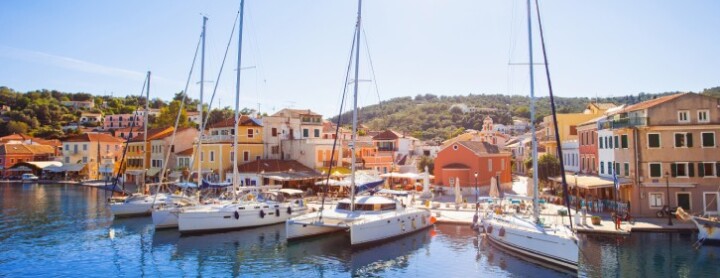
- Catamaran vs. Monohull - which one should you choose?
When you are planning a sailing holiday, you’ll be faced with a choice; catamaran vs. monohull. Each type has many benefits, but it’s important to think about what your needs are because that will tell you just which one to pick!
Let's dive right in!
Ease of sailing
Maneuverability, space/layout, holiday vibe.
You may also like: Sailing holiday destinations for your next boat trip
One of the top considerations you should have is what type of sailor you are because catamaran vs monohulls offer a distinctly different sailing experience. If you are a first time sailor and just want something incredibly easy to handle, then a catamaran will probably win out.
Catamarans have great control when it comes to maneuvering in tight places. Since they have twin engines and rudders, you get a lot of control and can turn pretty much 360 degrees with ease.
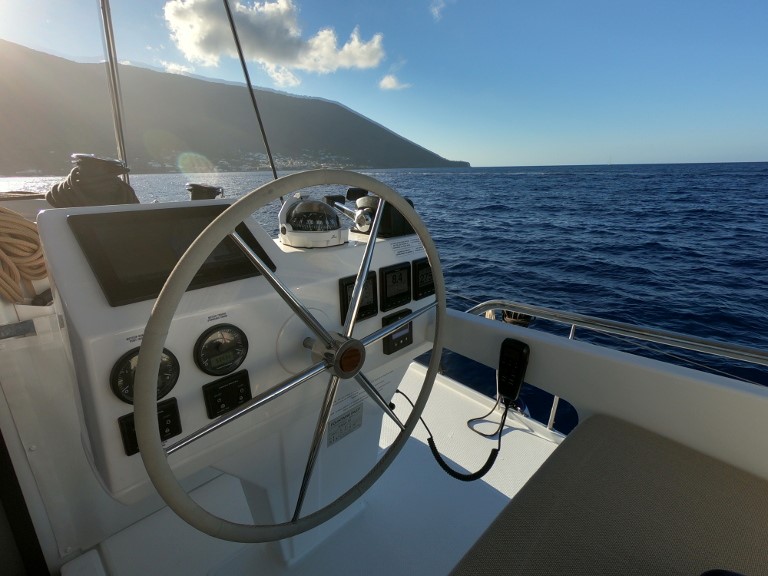
Catamarans also have a shallow draft, which will allow you to explore much closer to the shoreline than a monohull would be able to venture.
In the catamaran vs monohull speed debate, it might be more of a draw. Catamarans are typically 25-30% faster than a comparable monohull, but some argue that it comes at a price. When catamarans are sailing full speed you might experience a lot of slapping from the waves. Monohulls are designed to cut through the water. Also note that catamarans can be inefficient upwind and tack slowly.
When considering sailing conditions , a catamaran vs monohull in rough seas will perform very differently.
During rough sailing, you must be more vigilant when on a catamaran. The feedback from the wheel of a cat is not as obvious as that from a monohull. In high winds, you’ll need to know when to reduce sail.
However, monohulls tend to roll more in stormy weather, while catamarans stay pretty level even in rough seas.
When thinking about catamaran vs monohull stability, the stability that catamarans offer is a huge draw for many. Since cats bounce with the waves less, it is easier to walk around and enjoy the yacht while in motion. The increased stability is also great for children, or seniors, or anyone who might be prone to seasickness. When it comes to catamaran vs monohull seasickness, catamarans come out on top.
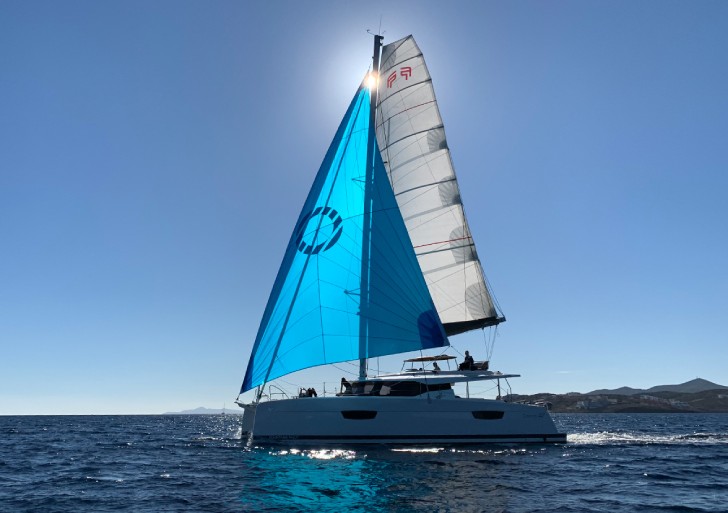
Although it is worth noting that monohulls swing less than catamarans if placed side by side in an anchorage.
If you’re deciding on a catamaran vs. monohull, you’ll have to think about what type of group you have. For family sailing holidays , maybe a catamaran is the best choice. Catamarans are very spacious, offering a large living space, and many cabin/head options. This makes them optimal for parties that want to spread out. Whether you’re a family, a big group of friends, or even couples looking for a 5 star, luxury experience who appreciate the extra space and comfort even if it’s not needed, a catamaran can fit your needs.
If thinking about catamaran vs monohull liveaboard readiness, the catamaran is a top contender. With far more living space and a much more spacious kitchen, Catamarans are great for people and groups that want to focus on entertainment and lounging.
Catamarans also typically have more spacious cabins and more privacy due to the layout with the cabins separate from the living area. This way you can send the kids to bed, and still enjoy the kitchen, dining, and living area.
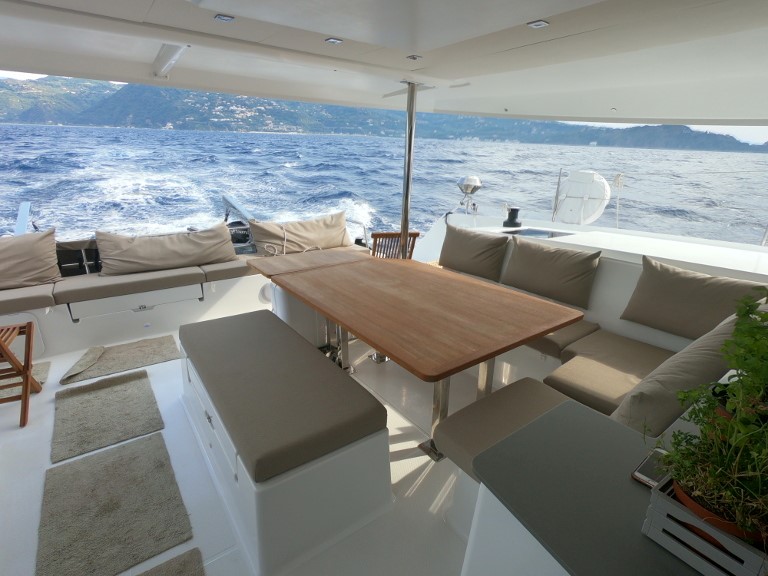
While catamarans are often touted for being roomy and luxurious, it’s worth nothing that monohull yachts can also be large and luxe. The Oceanis 62 and the Jeanneau 64 are top choices for those who want to live in the lap of luxury during their sailing holidays , while still getting that real sailing yacht experience.
In terms of catamarans vs monohull price , a monohull will definitely win. Charter prices for a catamaran can be 50-100% higher than that of a comparable sailing yacht. But that can be boiled down to the fact that you’re getting more space and more equipment with a catamaran!
A monohull, will only have one of everything - like it’s name suggests. It has one hull, one engine, one rudder, whereas a catamaran has twice the equipment and twice the living space of a monohull of the same length.
Another catamaran vs monohull cost to consider is the mooring costs. A catamaran, due to its twin hulls, might use two spots. Monohulls take less space to moor, and will be less expensive in that regard.
The cost of fuel should also be a consideration and in the question of catamaran vs monohull fuel efficiency, catamarans are the winner. With easy to drive hulls, and super light weight, they have great fuel efficiency.
Lastly, there is an abundant supply of monohull charters yachts, so the charter costs tend to be less to match the demand.
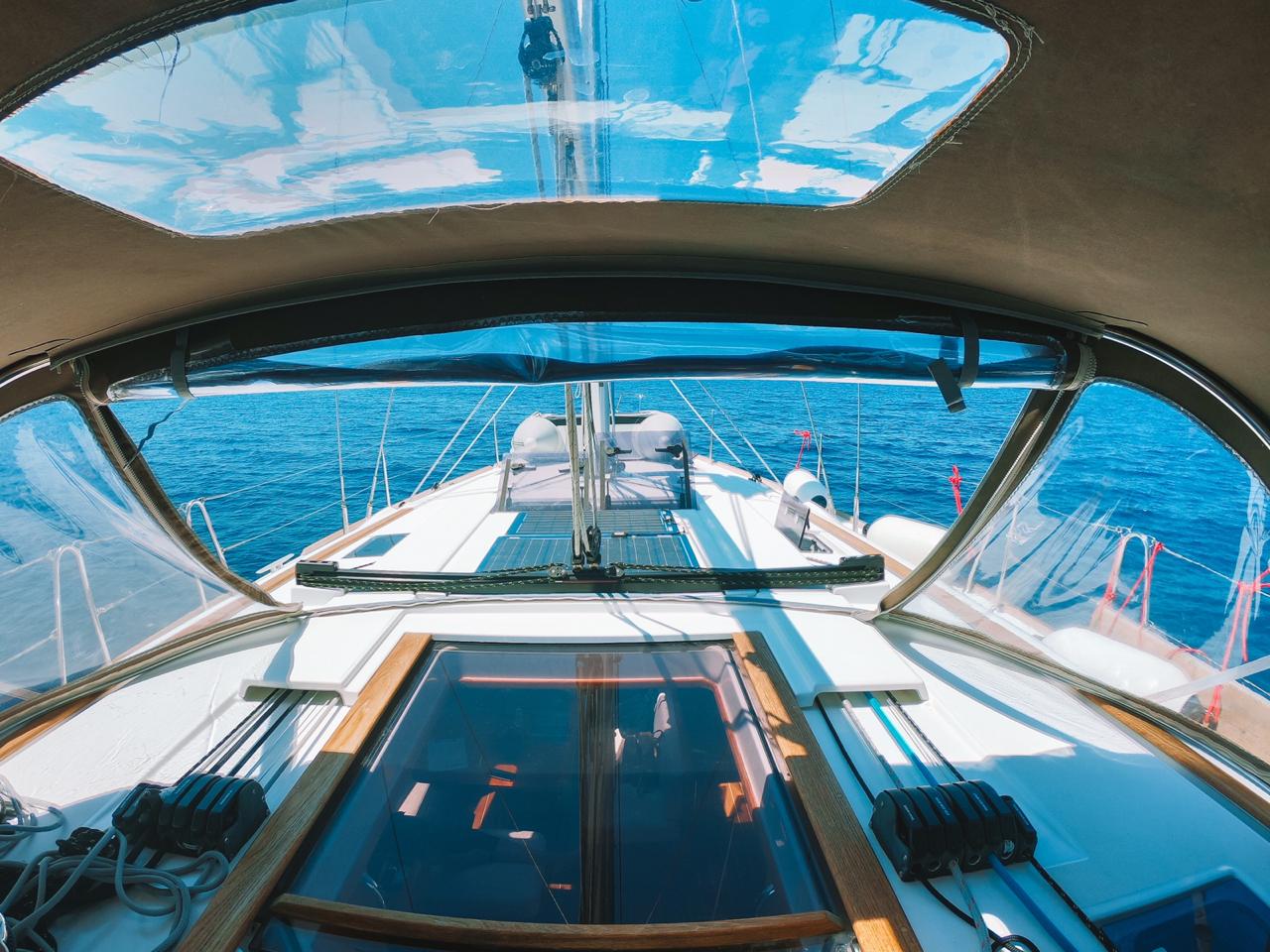
In the end, what it all comes down to is preference. In terms of performance, price, and comfort, catamarans and monohulls both have a lot going for them. You just need to decide what kind of holiday vibe you’re looking for, and Yacht4Less can help you with the rest!
At Yacht4Less we recommend fully crewed catamaran charters if you’re looking for top-of-the-line luxury and a super relaxing holiday where you don’t have to lift a finger. These boats will offer the space and comfort you’d expect from a 5-star hotel.
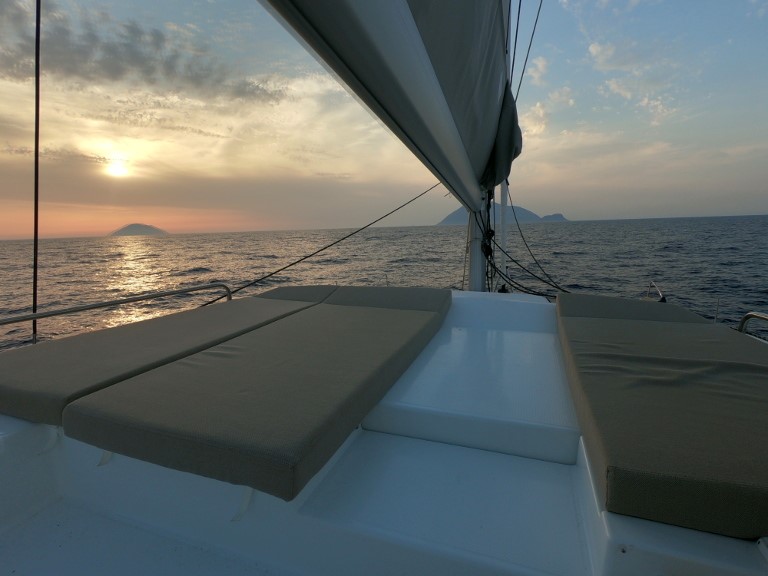
If you’re looking for a hands-on sailing adventure holiday, you might want to do a skippered charter with a monohull.. Your captain can show the ropes and help you learn how to sail. Or if you’re already an experienced sailor, go for a bareboat monohull charter . The exhilarating feeling of sailing a monohull is unmatched. It’s the classic romantic sailing experience, and makes for a thrilling holiday.
For those looking for a sailing experience somewhere in between extravagant luxury and exciting escapades, Yacht4Less is here to help you find the perfect boat for your needs. More sailing holiday dilemmas? We got you covered! Sailing Holidays vs. Land-Based Holidays » Party Sailing vs. Natural Wonders »
Get a free & non-binding quote

Catamaran Vs Monohull

Monohulls and traditional sailboats, once ubiquitous, are giving way to modern catamarans. But how do these designs differ?
Monohulls have a single hull, and catamarans have two hulls side-by-side. Catamarans are faster than monohulls of the same length and displacement, but monohulls are stronger and more spacious. Monohulls are also cheaper and easier to build than multi-hulls.
In this article, we’ll cover the differences between catamarans and monohulls, along with the benefits and drawbacks of each design. We’ll also cover the sailing characteristics of each and why catamarans so easily outrun equivalently-sized monohulls.
We sourced the information used in this article from trusted sailboat design resources, along with manufacturer specifications and boat market analysis.
Table of contents
What is a Catamaran?
Catamarans are a kind of multi-hull sailboat with two hulls joined together. They are often short and wide, resembling a square or rectangle from above.
Catamarans are colloquially distinct from outriggers, which are double-hulled vessels with one large primary hull and a small outboard stabilizing hull.
Catamarans usually have hulls that mirror each other, both in size and arrangement. Sometimes, the interior layouts are mirrored, too—but this varies between designs and manufacturers. Catamaran hulls are narrower and taller than most monohull designs of equal lengths.
Catamarans have limited commercial and military utility, as these applications favor space and ease-of-construction over handling characteristics. That said, there are some commercial uses for catamaran designs—most commonly passenger and car ferries.
What is a Monohull Sailboat?
A monohull is probably what you traditionally think of as a boat. Monohulls are longer than they are wide. It features a single hull—it’s that simple. Sailing monohull designs have evolved over the centuries into many distinct types, usually distinguished by keel type.
Monohulls come in many shapes and sizes . For example, sailing monohulls designed for offshore use have long keels that sometimes extend much further below the waterline than the freeboard and cabin extend above it.
Monohull sailboats are also designed for other purposes, such as inland sailing and racing. These vessels have more contemporary characteristics, such as rounded shallow ‘canoe’ bottoms, V-bottoms, and fin keels.
Monohulls aren’t just sailboats. Virtually every cargo and container ship, warship, and many passenger ships are monohulls due to their strength, ease of construction, and high cargo capacity.
Are Monohull Sailboats More Common?
Monohulls are more common in every application, though multi-hulls are becoming more common for ferries. Monohulls have numerous benefits over multi-hulls, and these benefits only increase with scale.
Monohulls are easy to construct. They’re also cheap. Large monohull ships, such as container ships, can be built with very little material and effort. This is because the vast majority of the length of a monohull is just a box, with a bow and stern welded onto the end.
Sailboat construction is more intricate, but the costs are still lower. Plus, monohull designs are robust, and cabin space is plentiful. There’s a lot more study in the field of monohull design, which was the universal truth until somewhat recently.
But all in all, the reason why monohull sailboats are more common is that they work just fine. Most sailboat owners aren’t interested in breaking speed records or hosting dozens of people aboard their boats. As a result, a standard, simple, and easy-to-control monohull are more than sufficient.
Are Catamarans Faster than Monohulls?
Catamarans are most certainly faster than monohulls. This is almost always the case. Even the fastest production monohulls can’t hold a candle to the average cruising catamaran.
But why is this the case? Aren’t catamarans restricted by the same hydrodynamic forces as monohulls? As it turns out, they aren’t. This has to do with the unusual way hull waves impact speed.

Hull Speed Limitations
Monohull speed is limited by something called hull speed. Hull speed is determined using a formula that calculates the maximum speed a displacement hull can travel under normal power and conditions.
When a displacement hull moves through the water, it kicks up a set of waves at the bow and stern. These waves travel along the side of the vessel and create drag, which slows down the boat. Normally, the power of the wind can overcome this drag—but only to a point.
At a certain speed, the waves kicked up by the bow will sync with the waves kicked up at the stern and begin ‘working together’ against the boat. The speed at which this occurs is the hull speed, which is calculated from the length of the boat.
Hull speed limitations for monohulls aren’t universally true all the time. Some vessels exceed it, and some don’t—but the number is a useful estimate of the limitations of monohull designs. Modern monohulls with clever hull shapes can defeat hull speed calculations.
Do Hull Speed Limitations Apply to Catamarans?
Surprisingly no—hull speed calculations don’t work for catamarans. This is because, for one, the hulls are shaped differently. Alone, catamaran hulls wouldn’t float correctly. But together, they create different hydrodynamic effects and cancel out the effects of hull speed.
This means that catamarans can easily exceed the speeds of even the fastest monohulls of equal length—and sometimes beat them by a margin of 50% or more. It’s not unheard of for 40-foot catamarans to exceed 20 knots, whereas 40-foot monohulls rarely get past 10.
Are Catamarans More Comfortable than Monohulls?
Catamarans can be much more comfortable than equivalently-sized monohulls—up to a point. This is because catamarans engage in ‘wave piercing’ and have a wider and more stable footprint on the water.
Catamaran hulls, when properly designed, can slice through parts of a wave instead of riding over every peak and trough. This effectively reduces the height of the weight, which reduces the amount the boat rolls.
Additionally, the wide footprint of a catamaran allows some waves to simply pass right under it, keeping the boat level for longer durations. Catamarans also don’t heel under sail—instead, they plane slightly, raising the bows out of the water and reducing bumps.
Monohull Benefits
Monohulls are proven in all conditions. A well-designed displacement monohull sailboat can ride out the strongest storms, and monohull workboats can support enormous loads and move them efficiently. They can be fast, comfortable, and also easy to sail (even for beginners).
Monohulls are cheap to build and forgiving, as precision doesn’t have to be microscopic to get them to sail right. They’re robust and strong, featuring a naturally stress-resistant hull shape. They’re also easy to modify and aren’t required to meet as strict of dimensional ratios to operate.
With a monohull sailboat, you have a lot of interior room to work with. This means that monohulls are available in numerous cabin layouts and are just as easy to modify as they are to build. Monohulls often have a center of gravity at or below the waterline, which enhances stability at steep heel angles.
On the water, displacement monohulls can weather extreme conditions with ease. They lack the initial stability of multi-hulls, but they can recover from knockdowns on their own, and they’re very difficult to push past their rollover point.
Why do Catamarans Cost More than Monohulls?
Catamarans cost more than monohulls because they’re more expensive to build, more complex to engineer, and require more material. This isn’t always the case, but the design of catamarans requires much more careful engineering and strength-of-materials analysis than comparatively simple monohulls.
There are several critical structural points on catamarans that monohulls lack. In fact, the very shape of a monohull is physically strong—so it has inherent durability. Catamaran hulls must be joined in the middle, and the mast must have a strong point far from the inherently sturdy hulls.
This requires stronger materials and more care during design or construction. This is why catamarans remain a premium part of the sailboat market and why they still aren’t the most popular sailboats despite their numerous performance and comfort benefits.
Catamaran Cabin Layout
Catamaran cabins are split between the two hulls, and there’s usually a large pilothouse in the center. Pilothouse catamarans can be quite spacious, primarily due to the large space between the hulls.
The pilothouse is usually where kitchen and sitting areas are located, along with cockpit access and the controls of the sailboat. The mast is also located in this area.
Catamaran cabins sometimes mirror each other. For example, each hull may contain two identical bedroom/bathroom combos, while the center console area contains the kitchen and living spaces.
The two identical hulls sometimes make for unusual design decisions (such as small catamarans with four master bedrooms), but owners say this gives their passengers a much better experience than a monohull cabin.
Monohull Cabin Layout
Monohull cabins, with the exception of split-cabin sailboats with a center cockpit, have only one large interior space to work with. It’s usually much wider than catamarans of equal length.
Monohull cabins are usually accessible from the bow (via a flush deck hatch) and the stern via a traditional companionway. They run the span of the hull between the bow and the cockpit and sometimes include spare berths under the cockpit seats.
These spare berths are often used as convenient sea cabins, as they offer quick access to controls in case of an emergency. Catamarans often have convertible berths in the center console for the same reason.
Monohull cabins are traditional and include everything that catamaran cabins do—albeit with slightly less room overall. That said, individual spaces are often much wider, and facilities are more appropriate.
Related Articles
Daniel Wade
I've personally had thousands of questions about sailing and sailboats over the years. As I learn and experience sailing, and the community, I share the answers that work and make sense to me, here on Life of Sailing.
by this author
Learn About Sailboats
Most Recent

What Does "Sailing By The Lee" Mean?
October 3, 2023

The Best Sailing Schools And Programs: Reviews & Ratings
September 26, 2023
Important Legal Info
Lifeofsailing.com is a participant in the Amazon Services LLC Associates Program, an affiliate advertising program designed to provide a means for sites to earn advertising fees by advertising and linking to Amazon. This site also participates in other affiliate programs and is compensated for referring traffic and business to these companies.
Similar Posts

Affordable Sailboats You Can Build at Home
September 13, 2023

Best Small Sailboat Ornaments
September 12, 2023

Discover the Magic of Hydrofoil Sailboats
December 11, 2023
Popular Posts

Best Liveaboard Catamaran Sailboats
December 28, 2023

Can a Novice Sail Around the World?
Elizabeth O'Malley
June 15, 2022

4 Best Electric Outboard Motors

How Long Did It Take The Vikings To Sail To England?

10 Best Sailboat Brands (And Why)
December 20, 2023

7 Best Places To Liveaboard A Sailboat
Get the best sailing content.
Top Rated Posts
© 2024 Life of Sailing Email: [email protected] Address: 11816 Inwood Rd #3024 Dallas, TX 75244 Disclaimer Privacy Policy
- Course Checklist
- Important Information
- How to Get to Us
- Our Instructors
Catamarans vs. Monohulls
Which is better, a monohull or a catamaran.
This question gets asked a lot in sailing. Especially if you are looking to take your friends or family out for the week: which will be better, a catamaran (aka cat) or monohull (aka mono)? The short answer is it depends what sort of experience you are looking for. Let's explore this further.
Tell me more about monohulls and catamarans.
Monohulls are boats that have one hull. They are the classic sailing yachts that you see old black & white photos of, racing off Newport or Cowes.
Catamarans on the other hand have two hulls. They tend to be newer, and are said to be less traditional, although some of the earliest sailing boats ever developed may well have been catamarans.
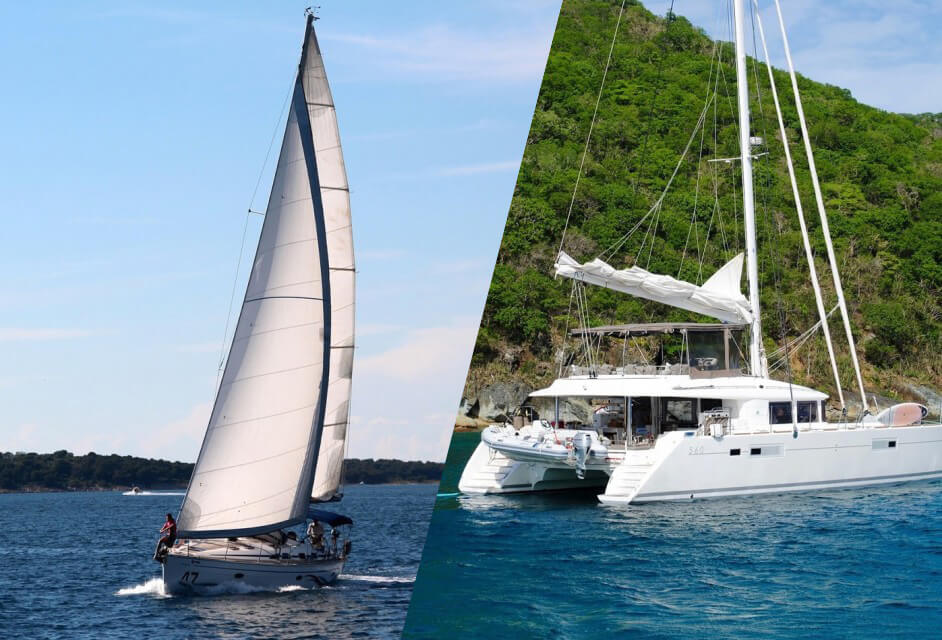
Image: monohull (left) and catamaran (right)
Things to consider
Now that we understand the difference between catamarans and monohulls, let's look at attributes that are important in sailing. Once we have explained these, we can look at how each boat-type deals with them:
For obvious reasons, you want to have a stable boat. Monohulls are a bit like a roly-poly doll, where when pushed over, they tend to right themselves. That is unless they reach what is termed the "angle of vanishing stability" or AVS. Catamarans deal with stability in a different way.
Catamarans tend to be much more stable in most conditions, but should they capsize, they quickly become stable, albeit upside down.
Nevertheless capsizing is such a rare occurrence that "stability" here really means comfort when sailing.
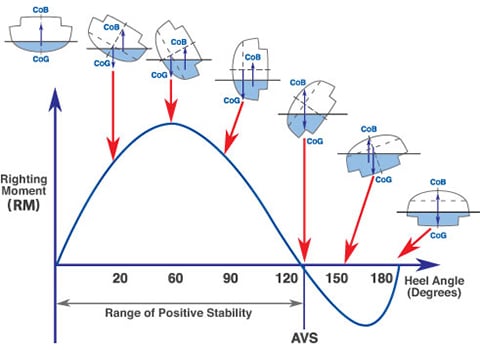
Angle of Vanishing Stability (AVS) graph, image thanks RYA: rya.org.uk
Living area
Your boat needs to strike a balance between sailing well and being comfortable to spend time in. The layout of the boat is important in this regard: what level it is on, how large it is, and how square the space is.
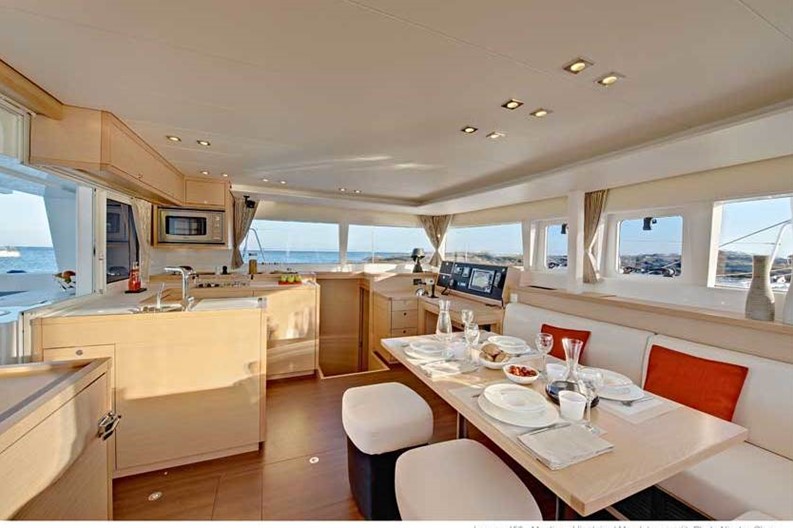
Lagoon 450 Living Area. Image thanks vivisail.com
The draft of a boat is how far in the water it goes. "How much does she draw" means "what is the minimum depth of water that this boat needs so she doesn't go aground". Monohulls by definition require a keel, a heavy piece of iron or lead that goes deep into the water. Catamarans do not require this, and therefore tend to have a "shallower draft".

Draft and Freeboard explained. Image thanks thecampfirecollective.com
Maneuverability
Being able to easily maneuver your boat is clearly an advantage in tight situations, such as when docking in a crowded marina. Both monohulls and catamarans have their pros and cons here, which will be explained further below.

Maneuverability, image thanks Cruising World (cruisingworld.com)
The speed of a sailboat is not as simple as for a motorboat. The angle of the wind has a large effect on the speed of a sailboat. Some boats can sail faster when close to the wind - monohulls normally fall into this category - while others can sail very fast when the wind is on their side (aka a beam reach) - catamarans usually like this sort of "reaching" sailing.

F50 catamaran in the fastest sailing competition in the world. Image thanks SailGP and James Wierzbowski
Having natural light and a decent view can make the living space much more comfortable. With monohulls, most of the living space is "down below" whereas for catamarans, most of the living area happens "up" in the saloon which is located between and above the two hulls. This creates two different environments. One person's "cozy" is another person's "claustrophobic". Just the same, one person's "light and open atmosphere" is another person's "soulless". So there is a fair degree of taste to this particular aspect.
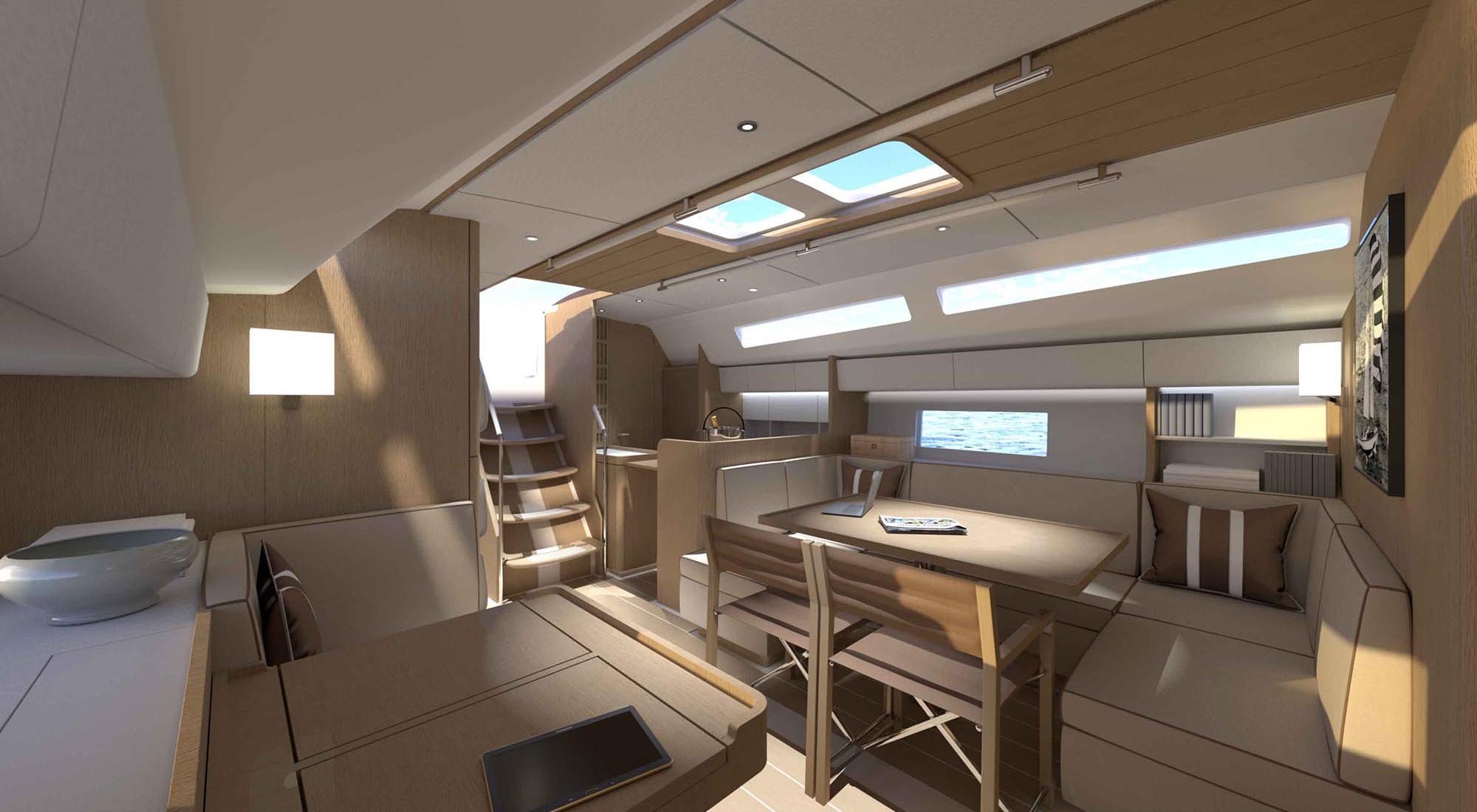
Interior of the incredible Nautor Swan 48, image thanks Nautor Swan
"Feeling Sailing"
By this we mean the feel of the boat responding to the wind as she slices through the water. Some people sail for this feeling, while others simply sail as an ecological, efficient way to move from A to B. Monohulls and catamarans offer very different visceral experiences here.
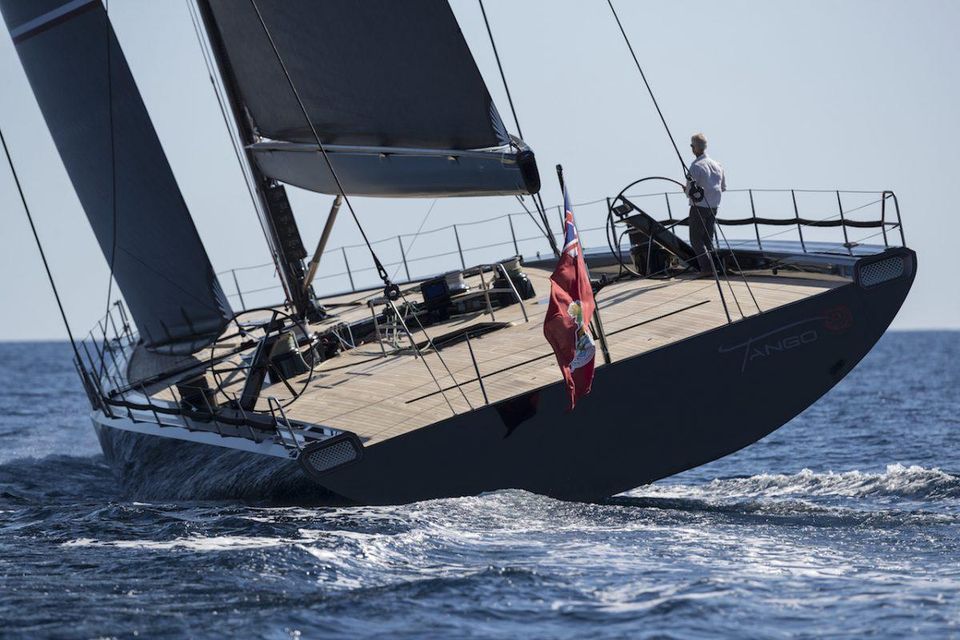
WallyCento Tango sails off Monaco, image thanks Gilles Martin-Raget/Wally Yachts
In breaking down the pros and cons of monohulls and catamarans, we found that a pro for one was a con for another. With that in mind, we think it is more helpful to list the pros of each, so you only read it once. Here goes:
8 Pros to Catamarans
1. catamarans are inherently stable..
Two hulls provides a wide base, which means in most sea states, less "bobbing". Every now and then, when the space between wave tops is a certain distance, the cat can lurch. But this is more the exception than the rule.
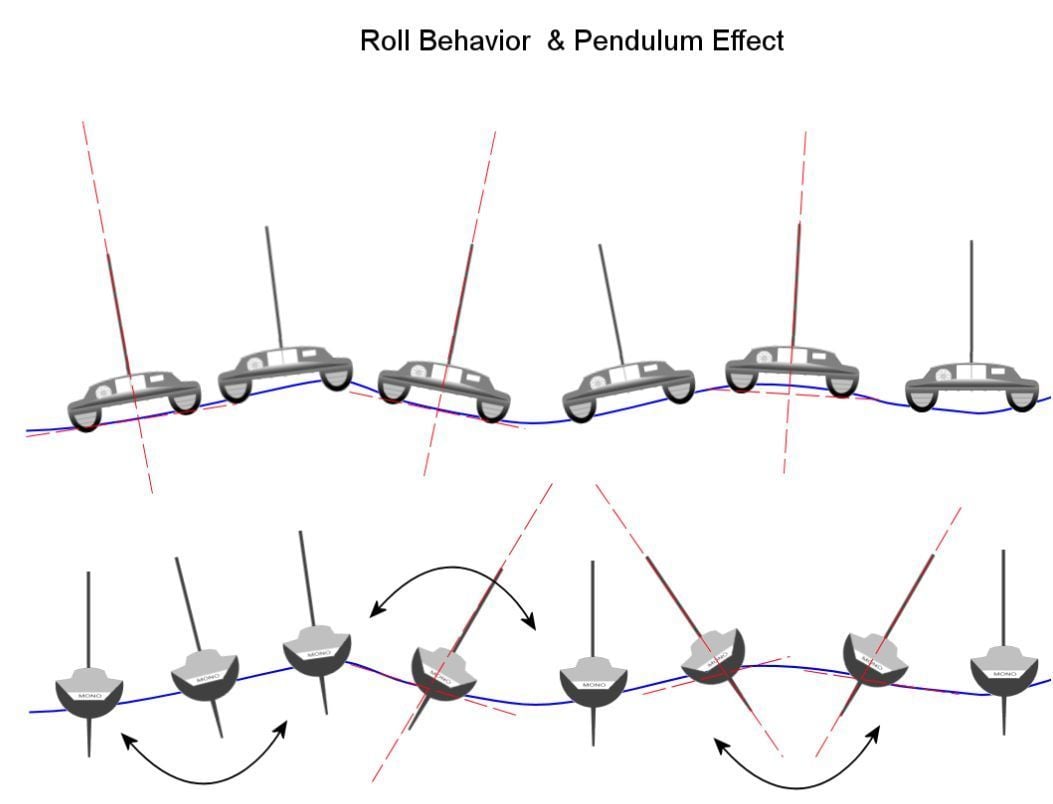
Great illustration of reduced rolling on a catamaran, image thanks aeroyacht.com
Here are some more pros of stability:
- Stability is a big factor for families with young children or seniors. It suits "non-sailors" in the group;
- Stability is very helpful for those prone to sea sickness (although scopolamine patches are probably still required if someone is very susceptible to getting sea sick);
- Stability means things are more comfortable at anchor, and for cooking;
- Because cats don’t heel over nearly as much, storage and stowing of provisions and household items is much easier.
Apologies for resolution, a brilliant graph on catamaran stability, thanks sailingcatamarans.com
2. Catamarans have more space.
Catamarans generally have much more living space in the main salon, galley and cockpit, and in the cabins. This can allow for greater privacy when chartering with friends or children, as the two sleeping areas (one in each hull) are separated by the living area. Here are some more pros of space:
- More space on a catamaran for preparing food, which means the cooking experience tends to be less a balancing act, and more like the kitchen at home;
- More space on a catamaran for storing things, which means people are not tripping over them throughout the trip.
- The space on a catamaran is square-shaped, akin to an apartment, as opposed to a monohull which tends to be more rectangular.
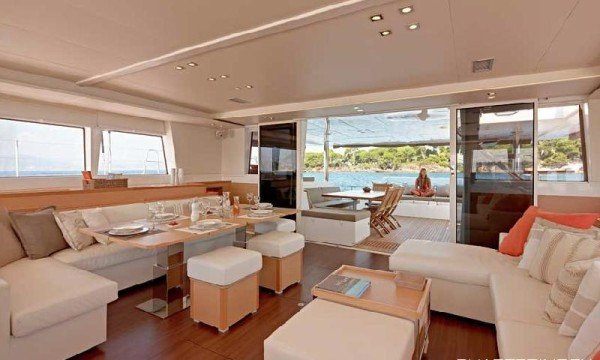
Interior of a Lagoon 620, image thanks Indigo Bay Yacht Charters
3. Catamaran living space is above the water line.
On a monohull, almost all living space on a is at least partially below the water line, which limits light and view, and can lead to claustrophobia in some. Catamarans on the other hand, sit above the water line. In addition:
- Ventilation in the main saloon area on catamarans is generally excellent, given their above-water design.
- Most of the living quarters are also above the water line, which allows for more light and a better view, as well as better circulation of air.
4. Catamarans can venture into shallower areas.
The lack of keel on a catamaran results in a shallower draft, allowing to anchor in shallower water, which is especially valuable around reefs in the tropics.
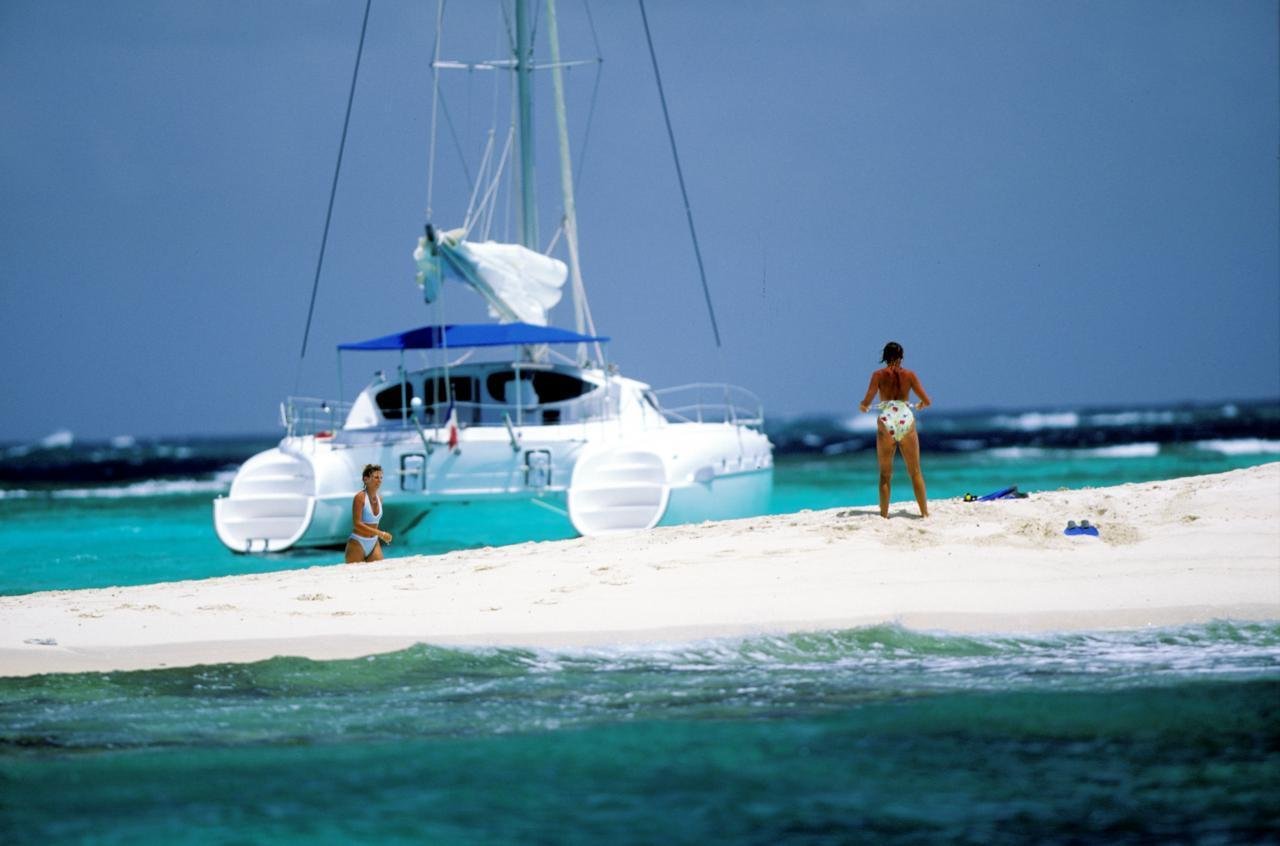
Shallow draft of a catamaran, image thanks aeroyacht.com
5. Catamarans can turn on a dime.
Because catamarans have two engines and two rudders, maneuverability in tight spaces is improved, with most cats being able to turn 360º within the length of the boat.
6. Catamarans (usually) sail faster.
Without the need for a heavy keel, catamarans are lighter than an equivalent monohull. That, plus the fact that they keep their sails perpendicular to the wind, means they sail faster than monohulls, especially on a run or broad reach.
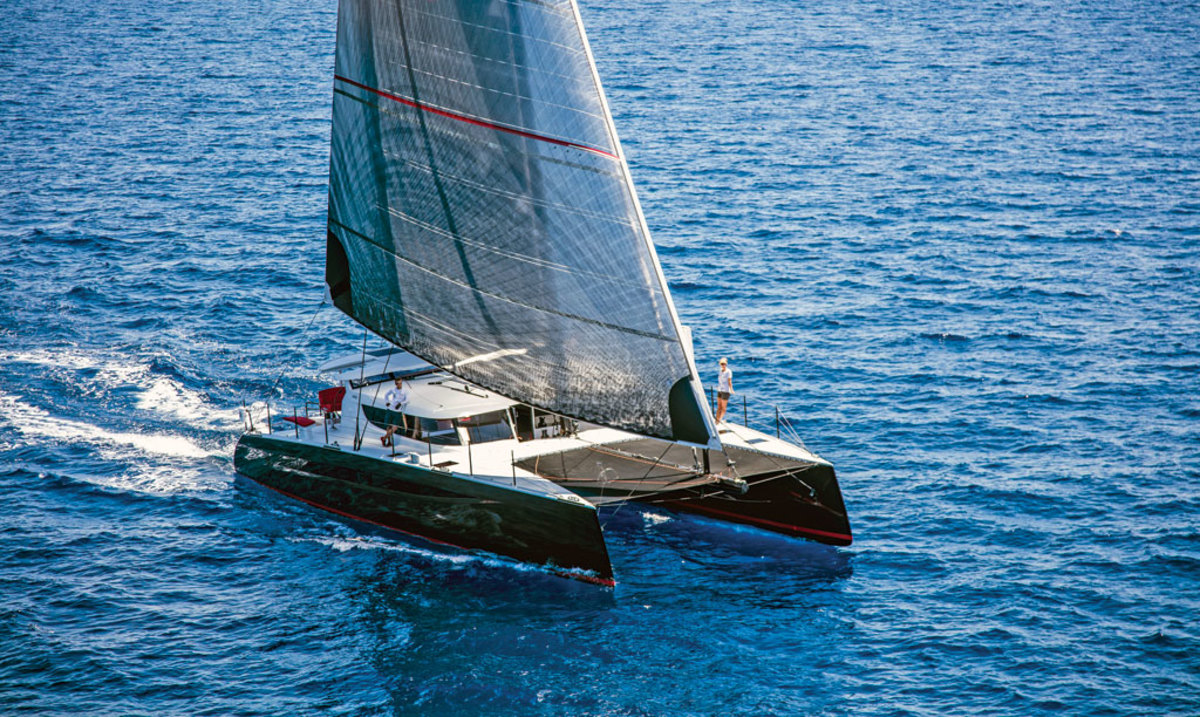
The magnificent HH66 catamaran, image thanks Sail Magazine
7. Catamarans are harder to sink.
Without the need for a lead-weighted keel, catamarans are not just lighter and faster, they are also harder to sink. Monohulls have been known to "lose their keel", by hitting something such as a semi-submerged container or even a whale. When this happens, the boat will tend to sink within minutes. Catamarans do not have a keel to lose, which means in this (admittedly very rare, blue-water) event, catamarans come out trumps.
8. Catamarans allow spooning.
Most catamarans have a trampoline or net at the front. This allows for spacious and comfortable cuddling under the stars - not to be underrated.
Monohull Pros
1. monohulls look great..
You can’t beat a monohull sailboat for good looks. Classic, sleek, beautiful, there is a timeless beauty to monohull sailboats.
Catamarans on the other hand have a “non-traditional” aesthetic that some consider to be a little harsher on the eyes. Let's face it, many are downright ugly.

2. Monohulls are a romantic, evolving tradition.
Do you love the old photos of well-dressed people sailing their immaculate wooden monohulls in beautiful surroundings? If you answer yes to this question, take a good look at monohulls. That romance and tradition is still there.
3. Monohulls give you more options.
Due to the sheer volume of monohulls made over the last century, there are many more options for a boat that meets your individual lifestyle, personal aesthetic, or budget.
4. Monohulls carry a lower cost.
- Monohulls take up half the space at a marina than catamarans, and therefore generally cost you half as much.
- Monohulls are more readily available used in good shape, and cost less to charter for equal sleeping capacity.
5. Monohulls sail better upwind.
Due to their keel, monohulls can sail higher into the wind than most catamarans. Some of the more exotic catamarans have daggerboards which serve the same purpose as a keel, and therefore improve windward performance substantially. However 95% of cruising cats (ie. those you can charter) do not have daggerboards. Furthermore:
- A monohull will be far easier than a catamaran to tack.
- Monohulls slice through the water effortlessly. On some catamarans you get an irritating slapping of water on the bridge decks in rougher seas.
- A monohull is generally faster to respond to the helm (in other words, they turn faster). This is because most cruising cats have little "spade rudders", with their depth dictated by the need to have a shallow draft. Whereas with a keel, a monohull can have a far deeper (read: more responsive) rudder for its draft.
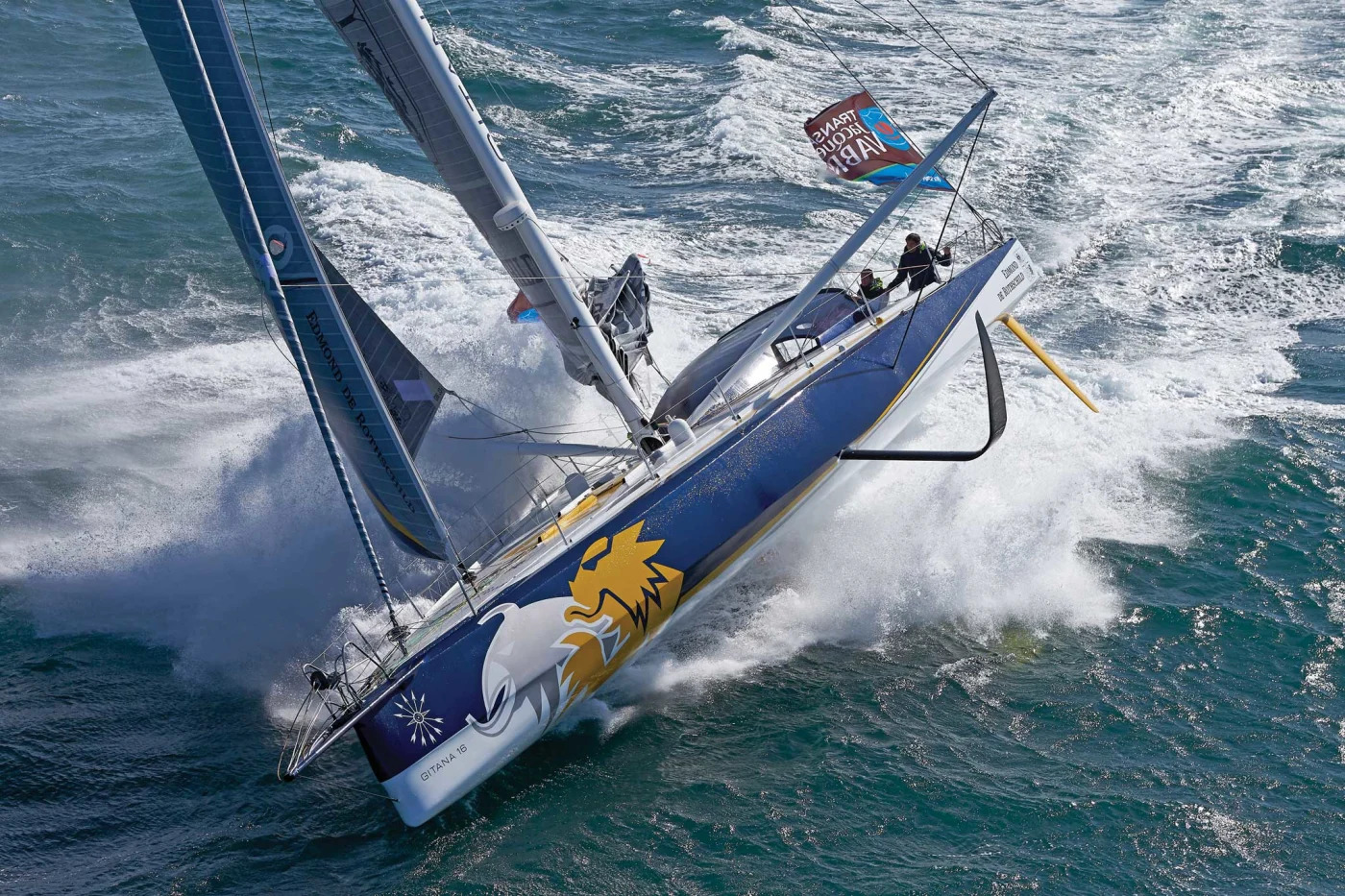
Monohull sailing upwind, image thanks Sail Magazine
6. Monohulls give you more feedback when sailing.
This factor (and lower cost) is why most sail training happens on monohulls. If you have too much sail out for the wind, your overpowered monohull will heel over and become a pain to sail, before anything breaks.
On a catamaran you get less feedback at the wheel, which if you are not being very attentive can get you into trouble in big winds.
Then there is the visceral joy of "feeling sailing". A monohull will heel (meaning it is designed to tip over anywhere from 10º to say 50º) whereas a catamaran won't. While their increased heeling can be a performance disadvantage, it can also be an advantage as it is a lot of fun.
7. Tacking is easier on a monohull.
While they can accelerate faster, catamarans also decelerate much quicker, and as such can have a harder time maintaining momentum through a tack. It depends what sort of sailing you are after. If it is about enjoying being outside, and not so much about the sailing itself, then a catamaran is fine. But if you are out there sailing for sailing's sake, then you will probably find more enjoyment on a monohull.
8. Monohulls tend to swing less at anchor.
While they may rock more in a side to side motion than their equivalent catamaran, monohulls tend to swing less at anchor.
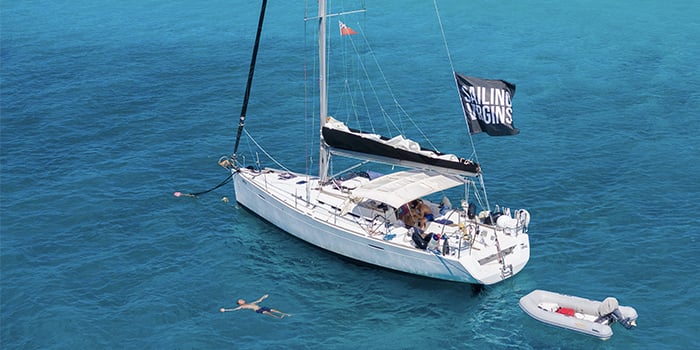
Libertas on a mooring ball. Monohulls exhibit less "sailing on their anchor" when moored.
Conclusions
The above shows that there are no clear winners to the Catamaran vs. Monohull debate. At Sailing Virgins we teach and cruise on both monohulls and catamarans. If you have to make a decision yourself it really comes down to:
- How much hard-core sailing you (and your crew) intend to do;
- What your budget is;
- How much space you need;
- How shallow the bays are that you would like to visit.
We hope that helps your decision making. If you would ever like to know more, if you become a Sailing Virgins Patron, you can take part in any of our once-per-month live Q&A sessions, where absolutely any sailing-related question if yours can be asked and answered. Patron support starts from as little as $3 per episode. Click here for more information.
Related posts
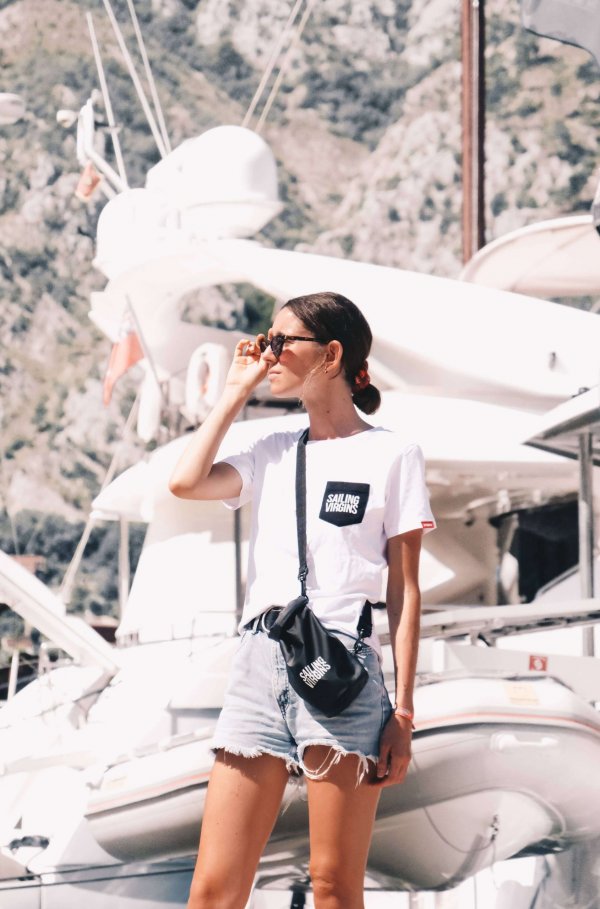
Essential Gear for Your First Sailing Adventure (2023)
Embarking on your first sailing adventure: must-have gear and essential tips.
If the call of the...
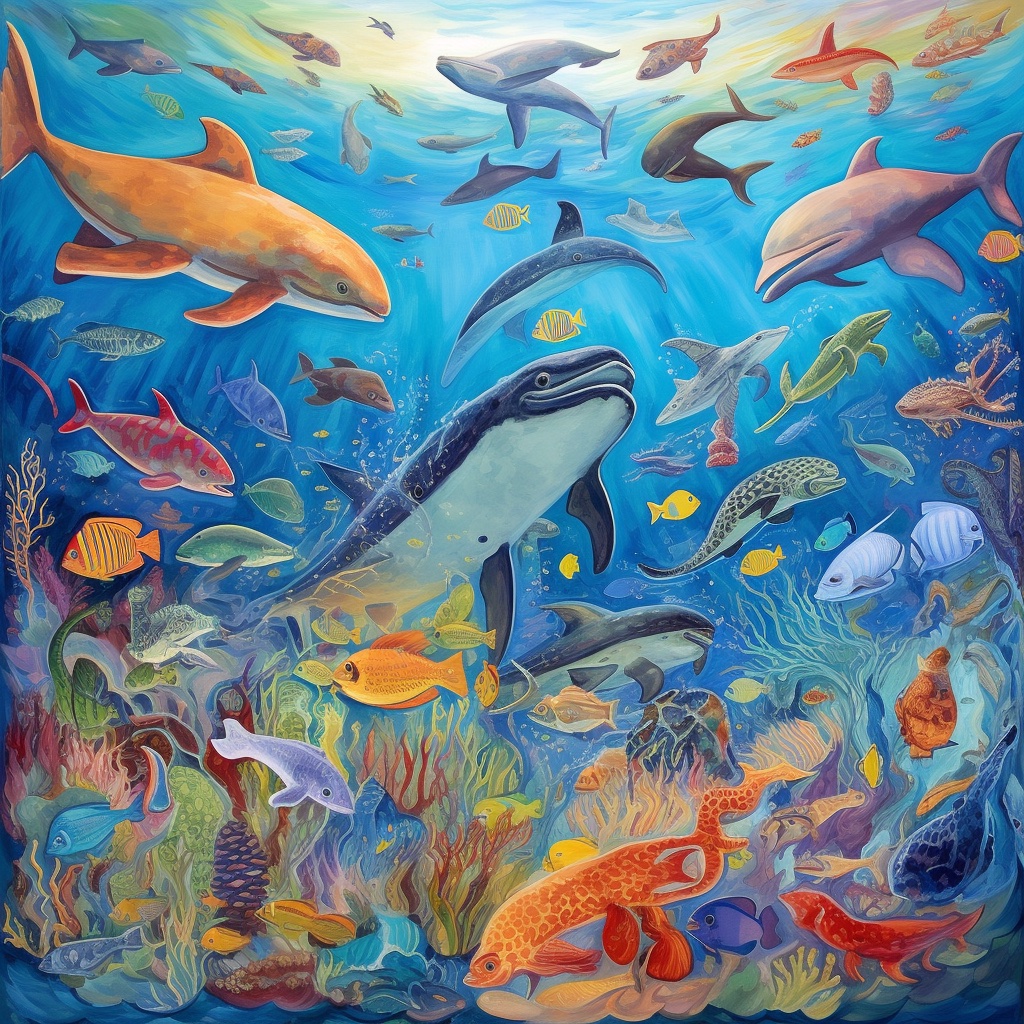
Unveiling La Paz, Mexico: An Unforgettable Sailing Destination
Welcome to la paz, an irresistible paradise for adventurers.
Ahoy, adventure-seekers! If you're...
How To Avoid Seasickness: 10 Tips For A Smooth Ride
Seasickness, or motion sickness, is a common problem that can ruin your sailing adventure. It’s...
Recent Posts
- August 2016 (11)
- May 2023 (11)
- April 2023 (10)
- September 2016 (8)
- November 2016 (5)
- June 2016 (3)
- July 2017 (3)
- March 2018 (3)
- November 2018 (3)
- June 2019 (3)
- June 2023 (3)
- October 2016 (2)
- January 2017 (2)
- February 2017 (2)
- May 2017 (2)
- August 2017 (2)
- October 2017 (2)
- February 2018 (2)
- December 2018 (2)
- June 2022 (2)
- July 2022 (2)
- November 2015 (1)
- April 2016 (1)
- May 2016 (1)
- December 2016 (1)
- April 2017 (1)
- September 2017 (1)
- November 2017 (1)
- December 2017 (1)
- January 2018 (1)
- April 2018 (1)
- July 2018 (1)
- September 2018 (1)
- January 2019 (1)
- July 2019 (1)
- September 2019 (1)
- January 2020 (1)
- March 2020 (1)
- April 2020 (1)
- May 2020 (1)
- June 2020 (1)
- April 2021 (1)
- August 2022 (1)
- October 2022 (1)
- December 2022 (1)
- July 2023 (1)
- August 2023 (1)
- January 2024 (1)
- how to (21)
- sailing (14)
- Sailing Tips (12)
- corporate (9)
- sailing course (7)
- General (6)
- Insider (6)
- professional development (6)
- vacation (6)
- Mindfulness (5)
- leadership (5)
- Performance (4)
- group travel (4)
- opinion (4)
- opinions (4)
- qualifications (4)
- Interview (3)
- Trip Notes (3)
- Uncategorized (3)
- adventure (3)
- sailing virgins (3)
- Instructor Course (2)
- Self-Care (2)
- catamarans vs monohulls (2)
- charter boat (2)
- island adventure (2)
- networking (2)
- preparation (2)
- sailing guide (2)
- youtube (2)
- Athlete (1)
- Beginner (1)
- City Guides (1)
- Failure (1)
- First Time (1)
- Maderia (1)
- check out (1)
- fishing (1)
- french polynesia (1)
- gear tips (1)
- golf vs sailing (1)
- safety brief yacht (1)
- the yacht week (1)
- trip review (1)
The founders of Sailing Virgins started things as a result of having some incredible sailing seasons in the Mediterranean and Caribbean working for sailing company The Yacht Week. James then worked for and for a while managed Tortola Sailing School. In 2016 he branched off and started Sailing Virgins. We LOVE how sailing is changing. Top speeds in the America’s Cup were thirteen knots not so long ago. Now they’re 45 knots. If you’re excited by that, we’re with you. Giddy up!
- Wickhams Cay 2 Road Town, Tortola VG1110, British Virgin Islands
- +1 (272) 999-1920
- [email protected]
© LOVE SAILING VIRGINS 2016-2024
- Terms & Conditions
- Privacy Policy

Catamaran Or Monohull? 27 Important Facts (Explained)
Catamarans and monohull boats are two very different kinds of vessels. Each craft offers distinct advantages and disadvantages that you’ll want to consider before choosing between the two.
In this post, we’ll go over some of the important things to consider when choosing between catamarans and monohull boats:
Table of Contents
Cost & Availability
Both catamarans and monohull boats come in small recreational sailing versions, larger motorboat versions, and larger sailing models. In all cases, the catamarans will cost more and will be harder to find.
The reason catamarans are harder to find because there are not as many of them, and they’re mostly made overseas.
Also, there aren’t as many catamaran manufacturers, so sailors have fewer options when buying them.
On top of this, catamarans have only recently become popular in the United States and other areas of the developed world. This means the used market for boats doesn’t have as many catamarans on it. You might find that you have fewer options when making a used catamaran purchase, which could bring costs up to a premium.
Two Times The Fun with Catamarans

Another reason that catamarans are more expensive than monohulls is the fact that catamaran buyers have to purchase two hulls, two engines, and two of all of the components that help make an engine work.
Traditional sailboats and large powerboats with one engine don’t have this cost issue.
On top of this, a catamaran is much wider than a monohull, and thus you have more space to build and equip.
On the other hand, once you’ve purchased the boat, you do get to enjoy the benefits of having two of everything. We’ll talk about the advantages of this further down in this post.
Maintenance Cost Makes A Difference
The maintenance on a catamaran is also more expensive than the maintenance on a monohull boat. This goes back to the fact that there is twice as much of everything to maintain.
Catamaran owners will need to do preventative maintenance on two different engines, and they’ll have two hulls and a large deck area to clean and maintain as well. If they’re getting the bottom of the boat treated, they’ll have to do this twice (once for each hull).
Even the interior components can usually be found twice.
Each cabin will usually have a head in it, so you’ll have at least two toilets and sinks to maintain, which obviously has its plusses and minuses.
One positive aspect of this is that catamaran owners do have the option of deferring some of their maintenance. For example, if one head is no longer functioning properly, you always have the second one that you can use.
It also adds a bit of safety as well.
This is because while the catamaran does have two engines to maintain, the owner does have power even if one of the engines happens to go down.
Some catamaran owners also like to point out that maintenance may not have to be done as frequently. This is because the engines don’t have to work quite as hard, and other items like additional bathrooms and sinks might only be used half as much.
How Much Space Do You Need?

A catamaran has more space than a monohull. This is because the boat is wider, and it has a much larger deck area. It also has twice as many hulls, so you have more overall space between the two of them.
The additional space is great for people looking to throw parties on their boats.
Most boat owners would agree that the catamaran is usually the party boat of choice at the docks.
Even if you aren’t into throwing parties, the extra space can still be nice for relaxing on the deck or getting a suntan. The wide-open space also makes it easy to use the boat as a fishing platform.
Additionally, you have more space for stuff like surfboards, rafts, and other items that can easily clutter up the deck of a monohull. Even fishing can be easier from a catamaran as the deck provides plenty of space between different anglers.
Catamaran owners also have additional space for carrying fresh water and adding generators and solar panels.
Interior space is generally more plentiful on a catamaran, and luxury catamarans have an easier time fitting large items like washers and dryers inside of them. You can have these on larger monohulls as well, but it will be harder to make them fit than it is in a catamaran.
On the other hand, all of the additional space means the catamaran owner has more space to maintain and clean. Also, all of the additional items that can be brought onto the boat will make it heavier. A heavier boat will use more fuel, and it will travel more slowly.
Living Quarters Vary Between The Two
The living quarters on a catamaran are much different than they are on a monohull. Most people would agree that the berths in a monohull are much more spacious than in a catamaran.
A monohull offers people the opportunity to have a large bed with space on either side to walk around it. This is great for couples who want to get out of bed without waking up their partner.
Catamarans, on the other hand, have the advantage of being able to offer large above-deck salon areas. The galleys, the dining areas, and the living areas can all be above-deck, while the two hulls can provide heads and berths.
Some boat owners say that living in a monohull is akin to living in a basement apartment . Other boat owners prefer the monohull because it brings them closer to the water and gives them the feeling of being at sea.
Privacy Can Be Prioritized On Catamarans
A catamaran offers up many different living areas that people can take advantage of. For example, each hull will typically have its own bathroom and bedroom.
This gives each sleeping area complete privacy from the other.
The living quarters are usually up on the deck, so early risers can wake up and move to these quarters without waking up the others.
The same holds for night owls. A night owl can stay up late without bothering the people who want to retire to their beds earlier.
With two hulls, large catamaran owners can hire a crew and give them their own hull to live in so that there is separation between the cruisers and the crew. This is a wonderful advantage for honeymooners looking to have their own space.
The downside to all of this, of course, is that sometimes a family may not want the additional privacy. For example, a family with small children might not want their children in a different hull than they are.
Additionally, the extra privacy can make it hard for people on the boat to communicate. This could become a big problem in the event of an emergency.
For this reason, it is often recommended that each hull have a radio in it so that the occupants can quickly communicate with each other. Remember, even in inland areas, cell phone reception may not be very good inside the boat hulls.
Recreation In a Monohull vs. a Catamaran
Most sailors agree that sailing a monohull boat is much more exhilarating than sailing a catamaran. Traditional sailboats heel, and sailors get instant feedback while they’re sailing. For the most part, catamarans stay stable, and you don’t get the same feeling with the movement of the wind and the water.
When it comes to monohull powerboats, you have the advantage of being able to pull water skiers, kneeboarders, and tubers with ease, as long as the boat has the power and a planing hull. A power catamaran usually doesn’t have the speed or maneuverability to pull off these recreational opportunities because they are displacement hull designs.
Catamarans excel in more leisurely recreational activities. A catamaran makes a great party deck as well as a great cruising deck. Catamaran owners can comfortably walk around a catamaran without having to worry that the boat might knock them over the next time it decides to heel. This allows boaters to sit and talk with one another comfortably.
A catamaran can also be used as a beaching vessel. This makes it a great platform for people looking to go swimming or fishing around sand bars and other shallow water areas. It also makes it a great boat for sailors looking to sail a larger boat on a river or lake known for having shallow areas.
Swimming and Diving
Swimming and diving off of a catamaran are usually much easier than doing the same from a monohull. The wide stance of the two hulls offers boat designers the option to put in staircases at the back of both hulls.
In between these staircases, some boats will have an additional diving platform and/or a dedicated frame for pieces of equipment and dinghy storage. This makes catamarans great for swimmers, snorkelers, and divers.
On the other hand, modern monohull sailboats can also have good transom stairs for easy access to the dinghy and swimming. Both types of boats can easily travel far out to sea, giving boaters the option of diving in areas that can’t be accessed from beaches and developed areas.
Boat Draft In Shallow Waters
For the uninitiated, the boat’s draft refers to how deep the boat’s hull sits within the water.
A monohull typically sits deep within the water, while a catamaran sits much higher on the water. This is why we stated that a catamaran is good for shallow waters.
The advantage of having a boat that can go into shallow waters isn’t restricted to just recreational activities like swimming and fishing. A boat that can go into shallow water is safer to operate in areas where a boat with a deeper draft might become damaged.
Additionally, a catamaran has more stability on calm waters. This helps make a catamaran more comfortable to relax or sleep on while at anchor or the dock.
The deeper draft of a monohull boat has its advantages as well. A deeper draft provides more stability in rough waters and allows a boat to go further into the sea.
For this reason, many coastal cruisers will prefer catamarans, while many ocean voyagers will prefer monohull boats. In fact, some areas of the Caribbean and the Florida Keys can be off-limits to boats with deep drafts as it simply isn’t safe for the boat to navigate these waters.
This isn’t to say that you can’t navigate these waters in a monohull boat, but you will have to be cautious depending on how deep your monohull’s boat draft is. You wouldn’t have this issue in a catamaran.
Stability On The Sea

A catamaran offers a lot more stability in shallow waters, in calm waters, at the dock, and anchorage. This makes the boat great for cruising and for relaxing in port.
A monohull offers a lot more stability in rough waters.
This makes this boat great for heading out to sea and for navigating vast distances.
Safety Issues To Consider
Both catamarans and monohulls can be built to navigate the waters they were made for safely. This will be determined more by the boat’s category designation rather than the type of boat.
However, each boat deals with unsafe situations in different ways. For instance, a monohull boat is likely to right itself if it is capsized.
This means that even in rough seas, you’re unlikely to find yourself permanently capsized.
The downside to this is that should you become completely swamped from a capsize in a monohull boat, you are much more likely to sink. In fact, if there is a hull breach on a monohull boat, your boat could sink.
Catamarans are said to be unsinkable. This isn’t completely true, but it is very unlikely that a catamaran will sink. Even if a hull is breached, you still have a second hull to keep the catamaran afloat.
However, a catamaran can’t right itself. If you capsize your catamaran, it will stay capsized.
One other safety concern to consider is that a monohull sailboat will heel while a catamaran will not. This increases the chances that someone could fall off the boat or onto the deck in a monohull boat.
Catamarans Are Faster Than Monohull Boats
A catamaran is faster than the average monohull boat.
This is because they face less water resistance, and their narrow hulls don’t have to deal with their own bow waves as a monohull does.
Of course, catamarans aren’t always faster. Old cruising catamarans may not go faster than 8 knots, and modern monohulls can exceed 10 knots.
Monohull boats tend to sail downwind and in choppy seas better than catamarans. This gives them a speed advantage during ocean voyages.
We have a separate post with complete average speeds per type of catemaran . It’s a must read if you are at all concerned about speed!
Fuel Consumption Considerations
Catamarans have two engines to burn fuel, which can drive up fuel costs.
However, a catamaran is lighter on the water, so it usually takes less energy to move a catamaran. This means you’ll end up using less fuel in a catamaran than you would in a monohull.
On top of this, catamarans can decide to use just one engine in low wind areas. This further decreases the amount of fuel that a catamaran consumes.
These rules only apply to calm waters.
A monohull navigates waters with high waves and strong winds much more efficiently than a catamaran. In this case, you’ll use less fuel in a monohull than you would in a catamaran.
Sailing Differences To Notice
Sailing a monohull boat can be exhilarating. These boats can glide through choppy waters, and you get to feel the motion of the boat as the sea rushes by the cockpit and the wind causes you to heel.
This type of sailing also provides instant feedback as you’ll know what you need to do with the sails as you’ll feel what is going on through the boat’s motion.
Sailors all over the world have been using monohull sailboats for years, and you’ll find plenty of outlets for recreational sailing with a monohull sailboat.
Sailing catamarans do not heel like a monohull sailboat.
These boats, therefore, do not provide the sailor with instant feedback. Also, if you incorrectly sail a catamaran, you do risk capsizing the boat more easily.
Training Can Be Quite Hard
Sailing a catamaran and sailing a monohull boat are two different experiences. People looking to sail either should probably get professional training.
Obtaining this training will always be easier with a monohull boat.
This is because monohulls are more popular, so you’ll have more instructors available to you.
Do You (Or Your Friends) Get Seasick?
People who are prone to getting seasick easily might want to consider a catamaran. A catamaran provides much more stability in calm waters, and you get a lot less movement.
On the other hand, people who are not prone to getting seasick might prefer a monohull in choppy waters.
This is because a monohull will deal with deep and choppy waters with high waves much better than a catamaran will.
As a result, a catamarans movement can seem extreme under these types of conditions. People who have never gotten seasick before can end up sick under these conditions.
Here’s a separate article we wrote with everything you should know about seasickness on Catamarans . There are some things you can do and some things you should know!
Docking Is (Usually) Easier With A Monohull Boat
Docking a catamaran can be a difficult endeavor.
This is because catamarans are often too wide to be docked within the slips located in central areas of a marina.
Because of this, they need to be docked at the end of the dock. This leaves them with fewer spots to dock. It also makes docking more expensive.
Catamaran owners traveling through areas that are unlikely to have many catamarans in them may find it difficult to find a dock at all. This is true in areas of the northern Atlantic where monohulls are much more popular than catamarans.
Storage Issues To Consider
Even storing a catamaran can be more difficult. This is because storage facilities often do not have the equipment to get a catamaran out of the water.
The wide width of these boats requires special lifts, and not all boat marinas will have them.
Storage facilities that do get the catamaran out of the water will often charge more money for it. They’ll charge additional fees for taking the catamaran out of the water, and they’ll charge additional fees for the actual storage of the boat as well.
Redundancy And Backup Equipment
We touched upon this earlier, but it is worth repeating that catamarans have many redundancy built into them. This can be a big advantage when it comes to safety.
For example, if one rudder becomes inoperable, the boat can still be steered with the other one. If one engine becomes inoperable, the boat can still be driven with the other one.
In extreme cases, a hull could become damaged, and you could still stay afloat because the other hull will keep the boat safely above water. These safety advantages can save lives and keep people from becoming stranded out at sea.
The primary downside is the maintenance issue that we mentioned earlier. All of these redundant components will need to be maintained. As a result, maintenance costs will be close to twice as expensive in a catamaran.
Cooking Is Easier On Catamarans

Cooking on a catamaran is usually easier than it is on a monohull. The main reason for this is that a catamaran doesn’t heel like a monohull, so you don’t have to worry as much about things falling over.
This not only makes cooking easier, but it makes cooking safer as well.
Additionally, catamaran galleys tend to have more space in them to move around. Also, they are often up on the deck, so you don’t have to climb in and out of the hull with your dinner in hand.
Dinghy Storage
Monohulls and catamarans can both hold dinghies. The larger the boat, the larger the dinghy can be.
However, catamarans have a wide area at the rear of the boat that is perfect for holding dinghies.
This makes getting in and out of the dinghy easier. Also, people can often have larger dinghies on their catamarans because the boat’s stern is so accommodating.
Power Generation Is Easy On A Catamaran
A catamaran has a lot of space for solar panels and wind turbines. Rigid panels can be placed in areas that won’t be walked on, like overtop of the bimini, and flexible panels can be placed in areas where the panels might end up getting stepped on.
The width of a catamaran even gives them more opportunities to put hydro generators into the water.
This means catamarans can generate more power than the average monohull boat can generate.
On the other hand, a monohull usually has less powered items to worry about. Monohulls need less power to operate at full capacity, so you may not need all of the additional space for generating power.
Ventilation Issues To Think About
Some people feel that monohull boats don’t offer enough ventilation. This is especially true in warmer areas of the world.
Catamarans also lack ventilation within their hulls, but fortunately for them, much of the living space is located up on deck. This gives catamarans an edge when it comes to cruising in warm weather.
On the other hand, monohull owners aren’t exposed to the cold winds that you might find up on deck in harsher climates.
This lack of airflow may actually be of benefit in this instance.
Some people find monohulls to be better looking than catamarans and vice versa.
This all comes down to personal preference, so you’ll have to decide for yourself which type of boat has the advantage in this case.
Some people think catamarans are the most elegant thing in the world while others prefer monohull boats as they look more classic.
Resale Value Is An Important Factor
If you read our extensive guide to boat depreciation per boat type , you know that no matter what boat you buy, it will always go down in value. This is just a sad fact of boat ownership that people need to consider before buying a boat.
Many factors go into how much you’ll be able to get for your boat when you resell it. These factors are the condition of the boat, the age of the boat, and the economy in general. For example, people are less likely to want to buy boats during a recession. This is especially true when it comes to smaller boats.
However, one additional factor that catamaran owners need to consider when thinking about resale value is the value of the dollar.
People from the United States don’t have many American catamarans to choose from and will usually need to buy these overseas.
This means that a catamaran will be less expensive to buy when the dollar is strong compared to the Euro and more expensive to buy when the dollar is weaker in comparison. This will affect the used market as well because higher values on new catamarans can help to bring up the value on the used market.
With a monohull boat, you may not have to consider situations like this as there are makers of monohull boats all over the world.
Don’t Let The Length Trick You!
One thought to keep in mind when comparing monohull boats and catamarans is that their different shapes account for different space advantages.
For example, a 40-foot long catamaran will have much more cubic space than a 40-foot long monohull.
Because of this, when comparing boats, you should look at the cubic space rather than the length. In this case, you may be comparing a 48-foot long monohull with a 40-foot long catamaran.
When you compare the two types of boats in this manner, the price differences aren’t quite as large, and the comparison is fairer. It also may make the operating and maintenance costs more similar.
This is an important distinction to make because the length of the boats can trick you!
Consider Trying Both (Before Buying)
Boats can be an expensive purchase, so it makes sense to try them out before you decide to make your purchase.
Rent each type of boat and use it on the types of waters that you intend to cruise on the most.
Try the boat out in different weather conditions as well, and don’t be afraid to do multiple rentals before you make your final choice. The time and money invested into making sure you get the boat you really want will be more than worth it in the end.
Click to share...
- About Sailonline
The One Source For Yacht Charters And Charter Yacht Ownership

- What is boat chartering
- Choose your best charter type
- Choose your charter company
- Choose a cruising area
- Choose the right boat
- Booking your charter
- Your sailing resume
- Yacht Charter Destinations Chart
- Catamarans vs. monohulls
- Bareboat Destination Skills
- Sailing Area Table
- Caribbean weather info
- What to pack for your charter
- Charter boat checklist
- Internet access on charter
- Briefing your charter crew
- Saving money on charter
- All boat charter tips in 1 file
- Budget Charter Fleets
- Provisioning a charter boat
- Booking directly with a boat owner
- The charter days you really get
- Managing your boat on charter
- Boat charter with kids
- Seasickness tips
- Starting a charter from the USVI
- If you damage a charter boat
- Flotilla charters
- Charter with a handicapped child
- Crewed yacht charter myths
- Organize a crewed charter
- Crewed charter tips
- Browse The Database
- Submit your Boat Listing
- Yacht Management Contract
- Buying a boat with a partner
- Bareboat vs. crewed yacht
- Charter Yacht Phase-out
- Phase-out punch list
- Yacht & Marine Surveyors
- Charter Boat Owners forum
- Yacht financial management tools
- 2nd tier fleets financial comparo
- Active ownership FAQ
- Layman guide to charter boat ownership
- Is Buying A Charter Boat For You?
- Buying a used charter boat
- Yacht buyer representation
- Bareboat vs. crewed yacht ownership
- Active Yacht Ownership
- Customers' Testimonials
- Cruising Logs
- Captain licenses
- 'Heaving to' maneuver: A must
- Charter Boat Seamanship Manual
- Yacht Crew Certification: All answers
- Snorkeling & kayaking safely
- Rules of the Road
- MOB Crash-Stop Maneuver
- 5 Knots you must know
- Flag Etiquette
- Emergencies on charter
- Distress calls at sea
- Navigation on a yacht charter
- Navigation aids sheets
- Estimate distances at sea
- Heavy weather basics
- Caribbean weather information
- VHF use: The basics
- Raising Main Sail | UnPC
- Anchoring technique & hand signals
- Catamaran sailing tips
- Docking: Avoid the embarrassment!
- Mooring technique
- Med-mooring technique
- Dinghy handling: make the best of it!
- Reefing a Catamaran
Remember Me
- Forgot your password?
- Forgot your username?
- Create an account
Catamarans - Monohulls: Pros and Cons

With catamarans vastly popular in the charter industry, and showing no sign of abating, let's compare the pros and cons of monohull and catamaran strictly on the charter work point of view . The reason why this distinction is important – and I write this as a monohull fanatic myself - is because for charter companies, catamarans are in huge demand due to the overwhelming number of advantages they offer. Out of charter use, there is no question for me that, when the offshore going gets tough, I would much rather be on a solid monohull than on a catamaran - although the catamaran builders have come a long way to strengthen comstruction. But this is just a matter of opinion!
Catamaran Pros
On deck The cockpit, highlight of catamarans, is usually huge, since it spans over both hulls. The cockpit and the salon are on the same level, which enhances the feeling of light and spaciousness, along with the typical huge panoramic windows. The foredeck area is very large as well and sports a big pair of nets between the hulls, the notorious trampolines, which make a great sun bathing area. In any case, it is a great observation spot and a kids' favorite. As a result of this roominess, a catamaran rarely feels crowded, as it is relatively easy to get some seclusion and quietness from other members of the party. Most cats are equipped with dinghy-davits at the transom, which is absolutely great: no more towing the dinghy, thus no more drag on the boat speed.
Down below The catamaran will provide you with considerably more room than a monohull almost everywhere on the boat: in the cabins and in the salon. Besides, there is ample headroom everywhere. A typical 43/47 ft. cat will have 4 large staterooms, with rectangular queen-size beds – no more of those pointy beds! - each with en-suite bathroom. A 38 to 42ft. will have 3/4 staterooms and 2/3 bathrooms. Most cats have an enormous salon/cockpit combination capable to entertain about 20 people in style! Because of the cats’ layout configuration, there is full privacy in every cabin and one does not hear anything from one cabin to the other.
Stability The key fact is that catamarans have a phenomenal stability: they do not heel under way and do not roll at anchor. This usually makes seasickness a non-event. Incidentally, it makes it somewhat safer for kids running around. Whether at anchor or under way, a catamaran is always much more stable than a monohull. Stability is also a good factor for elderly people and/or first time sailors. As a matter of fact, a catamaran will give the latter an excellent impression for their first cruise, instead of memories of being seasick!
Speed & maneuverability There is no question that catamarans are faster under power or sail. Whatever your cruising goals are, catamarans will usually move you about more quickly than a monohull. Catamarans have shallow drafts. This means catamarans can get into places monohulls yachts often cannot reach, and that they can also anchor closer to shore. However, more and more charter cats now have small "sacrificial" keels to improve close-hauled performance. Lastly, I personally enjoy the phenomenal maneuverability of the cats. With 2 engines spread apart, you can pivot a cat of any size literally around the boat's central axis – and without the help of the rudders. The autopilot works particularly well on cats, on a tracking standpoint.
Catamaran Cons
A hard-core monohull sailor once said: "When I sail a cat, it feels like I am driving my living room!" He meant that a cat does not convey the "real" feeling of sailing, with the "rail in the water" as sailors say. That is precisely because a cat does not heel, whereas a monohull does, and sometimes a lot. So if you are in for hard, pure sailing, you will not get that felling on a cat. Only a monohull will give you the full experience!
A cat does not typically sail well upwind and needs a different technique for tacking and anchoring. ( See tips for cat handling ).
It is often said that anchoring a catamaran can be more difficult. This is due to the fact that catamarans have more “windage” than monohulls, and, without keel and ballast, they have a tendency to “bob” on the water when a gust hits. ( See tips for cat anchoring )
Obviously, catamarans take up twice as much docking space as monohulls. This can be a bit of a problem in chartering areas where spending nights in marinas is a necessity.
If you are bringing with you a party of first-time sailors, or older people, or people who could feel apprehensive at sea, you probably will better off with a cat.
- PREMIUM FILES
- Pre-Owned Yachts
- Charter Boat Owners/Buyers Forum
- Favorite Links
|
|
| Built their boat. |
Copyright ©2000 - 2022 Sailonline.com. Unauthorized reproduction prohibited. Sailonline is not affiliated with any charter company.

Catamarans vs Monohulls: Which Is Better for You?
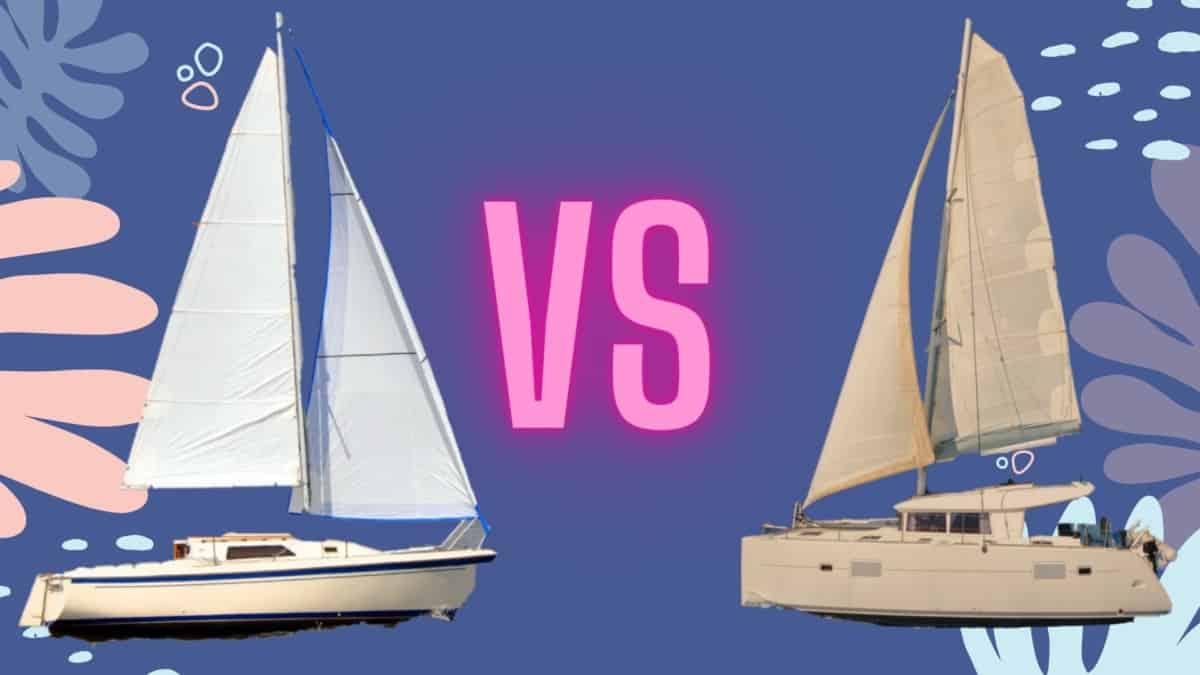
As an Amazon Associate, we earn from qualifying purchases. We may also earn commissions if you purchase products from other retailers after clicking on a link from our site.
In general, boating is an excellent pastime, but there are many things to consider before heading out and getting a boat. It’s important to ensure to get a boat that you are happy with and fits your needs, and one of the biggest debates in the boating community is whether catamarans or monohulls are best. But is there a clear winner, and what are the biggest differences?
Catamarans differ from monohulls in some very significant ways; Cats are more stable, faster, offer more space, and have two hulls. Monohulls offer heeling, faster steering response, less noise from water slapping, are cheaper to buy and maintain and have one hull.
Today we will be getting into the details you want to know regarding the differences and pros & cons between catamarans vs. monohulls. There are key aspects of each to be aware of before making an informed purchasing decision, and so if you would like to learn more, we encourage you to stick around and read further.
Table of Contents
Why Is It Important To Choose a Boat Carefully?
If you’ve ever shopped around for a boat , it’s no secret that they are large investments. And unless you are particularly wealthy, it will be a large expense where you want to get the most for your money. Buyer’s remorse is never a good thing, and avoiding it before you spend your hard-earned money is very important.
Boats come in all sorts of shapes and sizes, and not all will have the features you are looking for. Are you looking for something where you can hang out on the waters with friends and family – possibly with kids involved? Then stability and room are likely going to be your priority. On the other hand, if you prioritize the sailing aspect of boating, then getting something designed to be nimble in the waters is something to consider.
There is more to boating than simply saying “a boat’s a boat,” and the comparison between catamarans and monohulls brings this point home.
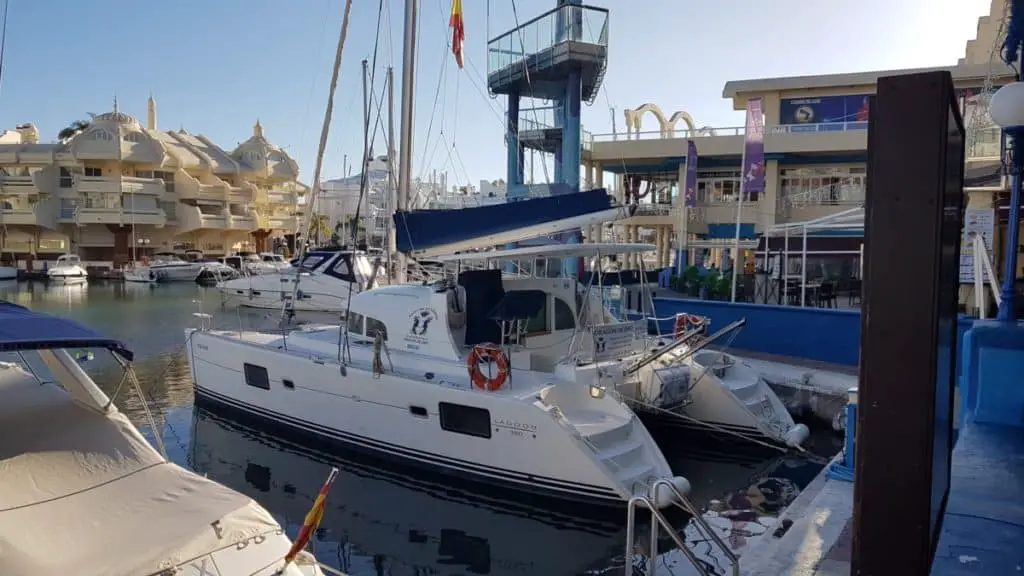
What Are Catamarans?
Catamarans , commonly referred to as “cats” for short, feature two hulls separated by a bridge deck rather than one central hull that most boats have. The hull is the body of a ship and is specifically designed to allow the boat to float rather than sink. Additionally, while some boats are more stable than others, the goal is always to ensure that the hull is as balanced as possible within reason (nimbler boats will generally be easier to rock).
Stability is the number one thing cats are known for; the two hulls ensure that it is nearly impossible to flip them over because they are spaced out over a large distance (aka wide beam). Think of it as standing with your legs far apart vs. tightly together, the physics word similarly with boats.
They also feel the most like standing on land since they are not prone to rocking back and forth, making them ideal for people prone to seasickness or who just want a stable platform for cooking activities.
How to stop sea sickness?
Catamaran Pros
- Unrivaled stability. As we stated above, the biggest thing cats have going for them is that they are almost impossible to flip over, and they don’t rock back and forth as much as monohull boats. If you are on still waters, it can feel as if you are on land which is beneficial for people who aren’t used to walking and standing on a boat that is constantly shifting around.
- More space. Due to how wide catamarans are, they are generally more spacious than the comparable monohull. This means more room for gear and people. If you plan to party on a boat, then a cat is likely going to be your best option.
- More privacy. A cat will have a different layout from a monohull, and these layouts typically feature more separation between the main living space and the cabins. If you plan to spend a lot of time on the boat with others, having the option of privacy may be an important feature. It’s always best to judge each boats’ layout if you value privacy, however.
- They Stay Level. This goes back to the stability of cats. A catamaran will heel only 5 to 10 degrees, which is a lot less than a monohull boat. This makes it easier to do certain activities such as cooking, and it provides a more comfortable experience for all onboard overall. A cat is the perfect type of boat for socializing with others.
- They are fast. While a monohull is elegant, a cat will usually have a higher top speed(want to understand sailboat speed? ). The reason for this is because they don’t have a heavy keel weighing them down. If you are the type you enjoy fast sailing, a catamaran will be right up your alley!
- Safety. Cats are hard to sink and capsize; it would take extreme weather and waves to defeat a catamaran. Because of this, they are regarded as one of the safest boats. In addition, it is rare for someone to be tossed overboard while on a cat due to the stability benefits. If you value the member’s safety onboard your boat, a cat won’t let you down. When do catamarans capsize?
- Shallow water cruising. Catamarans have low draft keels, which allows them to cruise in shallow waters. Additionally, you are less likely to misjudge a body of water being deep enough since chances are you’ll just pass above the reef or rock without ever noticing.
- Bridge deck view. Because cat decks are high up, you can get a better view of your surroundings. A higher deck’s advantage is that it allows for better sightseeing, and it can be viewed as a safety feature.
Catamaran Cons
- Different sailing experience. The stability of a cat is also seen as a downside from some people. Many sailing enthusiasts feel that sailing a cat is like sailing a houseboat, while monohulls offer the “true” sailing experience. If you are after exhilarating (or at least heeling) sailing, then a monohull may be better for you.
- They take up more space. Cats may have a lot of space, but they also take up a lot of space, which leads them to be more difficult to dock in certain areas, and in many instances, you may not be able to dock exactly where you want. Also, they often cost more money to dock simply due to their size.
- Noisy to sail upwind. Due to some cats having a low bridge deck clearance, waves can smack up against its underside and emit a very noticeable water slapping sound. This can get annoying when you are trying to enjoy a quiet sailing session. If you want to learn more, read this!
- Less feedback when turning. Due to their stability and overall wideness, you won’t get as much feedback from the wheel as you would a monohull. This means you will need to be more vigilant if you find yourself in rough waters and high winds. Some people also feel like there is a lag while steering a catamaran.
- More expensive. Besides higher docking fees, cats sometimes cost more upfront, catamaran vs monohull costs is a complex topic. When is a catamaran cheaper than a monohull?
What Are Monohulls?
As the name suggests, monohull boats have one hull. This design is likely what you think of when you think of what a boat is. You might be wondering why most boats aren’t catamarans given their stability advantages, and the answer to that is responsiveness, size, nimbleness, and sailing experience.
One advantage with a monohull boat is that it can slice through water like butter mitigating noise at higher speeds. Additionally, they are cheaper to produce (generally speaking) overall, making them even more attractive for both manufacturers and consumers.
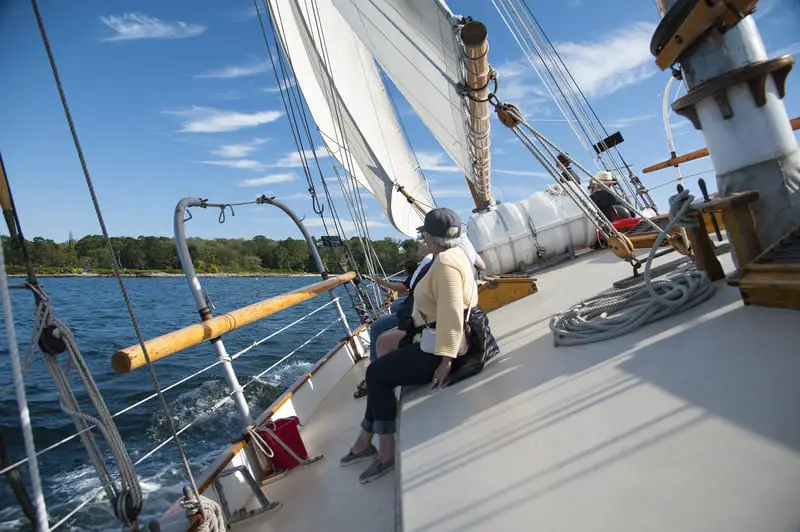
Many would also argue that monohulls are aesthetically pleasing. Think of the best looking Yachts and speedboats you’ve ever seen – they are highly likely to be monohulls.
But let’s not get too far ahead of ourselves; there are plenty of differences and pros & cons between cats and monohulls, and stacking them up together is the easiest way to make an informed decision on which one is best for you.
Monohull Pros
- Quiet sailing. Because of how monohulls are shaped, they don’t suffer from water slapping against a flat hull. They cut through the water, which allows for a quieter sailing experience overall. If you hate repetitive, annoying sounds, you might want to look into a monohull for this reason.
- More exhilarating sailing experience. This is the main argument from people who are fans of monohull boats. You can heel in them, and they are more responsive when steering. You’ll also “feel” the waters more as the boat gets sloshed around. If you are looking for that heeling motion a monohull or a trimaran is probably what you should get. In addition, monohulls are easier to tack .
- Aesthetics. This is subjective, but more people seem to prefer the aesthetics of monohull boats. A good looking monohull is simply gorgeous and sleek looking. I love the look of cats, but I do believe most people fancy the mono!
- Dock in more places. Monohulls are smaller, which means they can dock almost anywhere without special accommodation. Additionally, they can maneuver through tighter spaces. Even though shallow water can sometimes be the enemy of a monohull boat, you’ll likely feel like you aren’t as limited as a catamaran.
- Less expensive. A furnished out monohull boat is usually going to be less expensive than a cat. If you want amenities such as sleeping quarters and cooking tools, you’ll save money using a monohull.
Can catamarans be cheaper than monohulls?
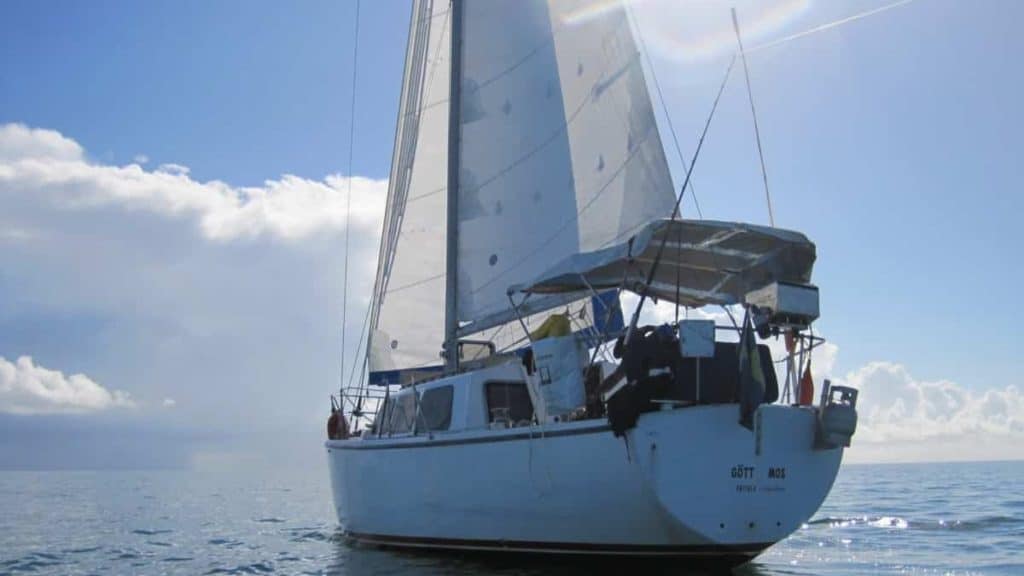
Monohull Cons
- Small quarters. Any area you go to inside of a monohull is going to be smaller than the cat equivalent. So while monohulls are cheaper, you are receiving less space; you will need to look for a bigger monohull if you want living quarters that are closer to a cat.
- Ventilation. Monohulls aren’t as good at ventilating as a cat. Things can get quite toasty on a warm day, which isn’t ideal if you are sleeping in your boat. You can use fans, or AC to help mitigate this issue, however.
- Stability. Monohulls rock a lot more easily than a cat, which can be disorienting to people not used to being on a boat. Additionally, it makes certain activities such as cooking harder than they should be. Not to mention it can be downright uncomfortable for some people. Some monohulls are more stable than others, but their nature generally means they won’t be as stable as a cat. This is one of the main reasons I’m switching to a cat!
- Lower sitting. Because the below deck areas sit below the waterline, it can make some feel like they are living in a hole. If you are claustrophobic, then this may be an issue for you. Some people like this aspect of monohulls since they feel hidden and secure, but it’s not for everybody.
- Safety. This is a big one to keep in mind. The hull on a monohull boat is simply the bottom of the boat. Unlike cats, which have holes on each side with the deck and below deck portions being in the monohulls don’t have protection against sinking due to a puncture. If there is a hole made on the hull, water will come in, and the boat will sink. This, however, is only a tiny fraction of what should be considered when discussing sailboat design safety. Why do catamarans capsize?
Also, it’s more likely to be tossed overboard if you are on particularly wavy waters and fall the wrong way. We’re not saying there is a high chance of this happening, but it is possible. Remember to wear a life jacket when on deck, such as this Self-inflatable I used in the Bahamas.
Who Should Buy a Catamaran?
Consider if you value the thrill of heeling or comfort. Putting together the pros and cons of cats, the conclusion can be made that they are better for people who want more of a “houseboat” experience. They are larger, more stable, and offer a superior deck view since they sit high. This is not true of all catamarans, the more performance-oriented boats are a true adventure to sail!
Additionally, If you enjoy passing other boats or just like to get to your destination quicker, you’ll enjoy the speed advantage of a catboat. You’ll also have more peace of mind that you are much more protected against punctures and sinking than a monohull.
In short, if you value a more “homey” experience and aren’t too fond of your boat rocking when you are trying to walk and cook. Additionally, if you are prone to seasickness, you will have an easier time with a cat.
If you are looking for a more “involved” sailing experience, you might be disappointed with a catamaran since it can feel as though you are gliding along in a boathouse. But if that is your thing, then a catamaran is for you.
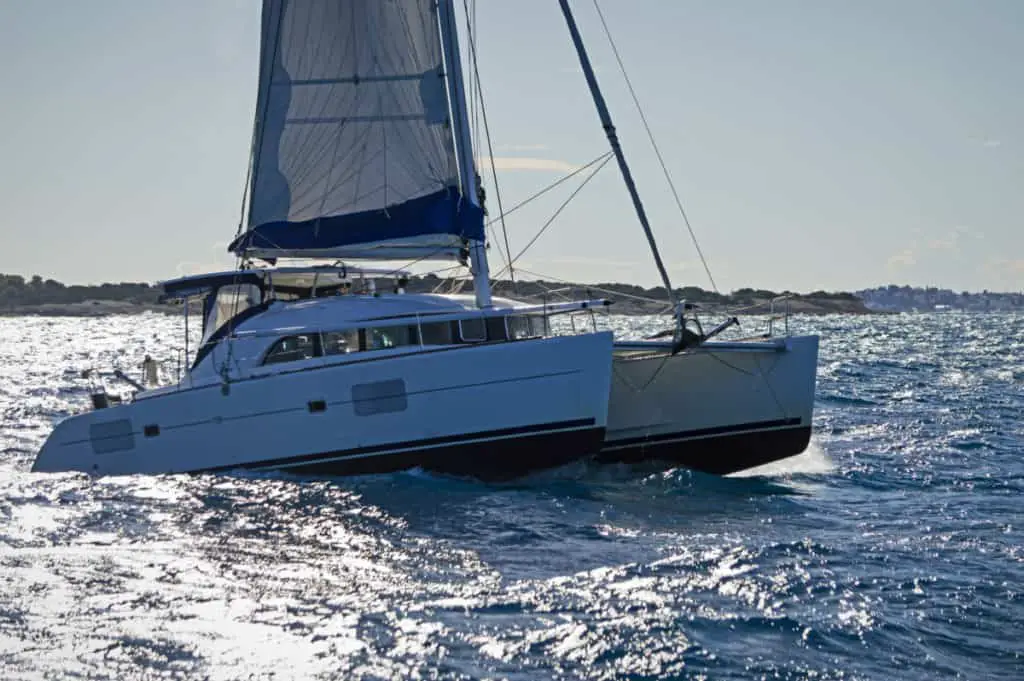
Who Should Buy a Monohull?
Monohulls are the more traditional of the two choices and are still preferred by many boat people— the main reason being that the whole “boating experience” is more pronounced with monohulls. You’ll feel the waters more, and you get to do fun stuff, such as healing. You will also be closer to the water since sections are much lower than they are in a cat.
Furthermore, these boats are usually the less expensive option.
You won’t get any of that annoying water slapping noise prominent with cats when the waters start getting rough.
Last but not least, monohulls (by popular vote) generally look better, and so if you want to stand out in a good way and show off your expensive investment, getting a monohull is going to be your best bet.
Overall, if you love connecting with the waters and want to feel like you are on a boat, a monohull will be more for you. Cats are great, but some traditionalists say “monohulls are the sailor’s boat”.
Want More Insight?
If you would like more insight on this topic, we recommend checking out this debate between two sailors on catamarans vs monohulls. You’ll receive two points of view regarding various factors regarding speed, fuel, etc. There is a reason why there are so many back and forth arguments in the boating community on this topic and exploring both points of view may help you make an informed decision based on what matters to you.
There are compelling reasons to go with one or the other boat styles. Cats will offer a more relaxed experience with their stability, spaciousness, and higher view. They are also extremely hard to sink due to the small draft. If you are prone to seasickness or just simply hate it when a boat rocks, then getting a catamaran is going to be the right call for you.
On the other hand, if you are looking for a more heeling experience, then a monohull is the best choice.
Owner of CatamaranFreedom.com. A minimalist that has lived in a caravan in Sweden, 35ft Monohull in the Bahamas, and right now in his self-built Van. He just started the next adventure, to circumnavigate the world on a Catamaran!
Leave a Reply Cancel reply
Your email address will not be published. Required fields are marked *
Save my name and email in this browser for the next time I comment.
Recent Posts
Must-Have Boat Gear for Catamaran Sailors!
Sailing is probably the most gear-intensive activity I've ever done; there are so many decisions to be made about what gear to buy now, for tomorrow, and what to definitely never buy. The gear on...
6 Best Trailerable Trimarans For Bluewater and Coastal Sailing
Having a boat costs a lot of money, even when you are not using it, marina fees, etc. And once it is in the water most sailors never go very far from their "home marina" and sailing will be somewhat...
Your source for the latest news on yachts, boats and more. Read through our articles to find out how to compare boats and find the right fit for you!
Catamaran vs. Monohull Fishing Boats - Which is Better
Dec 14, 2023
less than a min
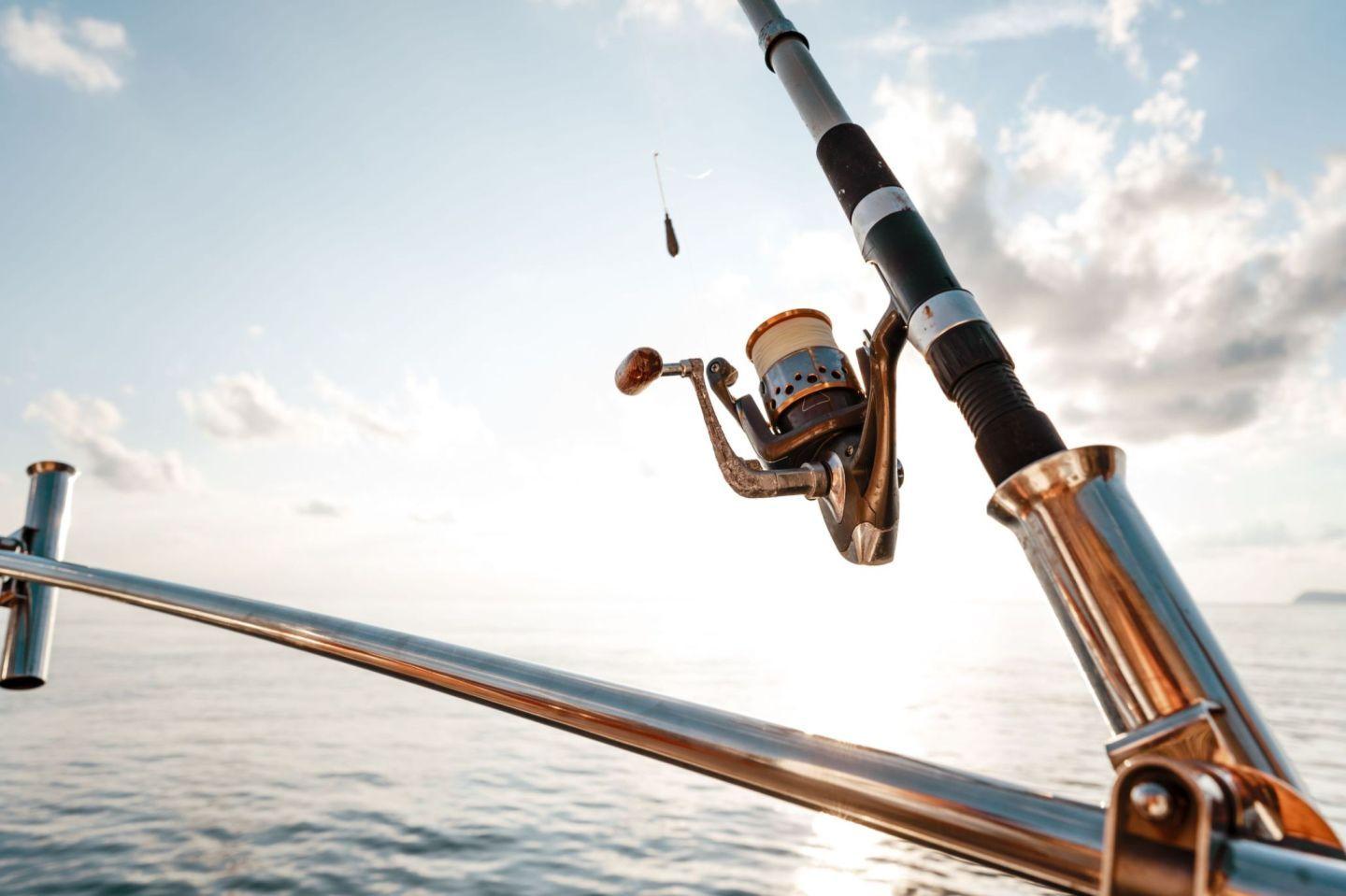
When selecting a fishing boat, anglers face a significant choice that can impact their experience on the water. The type of boat you choose - be it a catamaran or a traditional monohull - plays a pivotal role in defining your fishing adventures. Both catamaran and monohull boats have distinct features and advantages, and understanding these differences is key to finding a vessel that aligns with your fishing style and preferences. Whether you're a seasoned angler or just beginning to navigate the world of fishing, we'll help guide delves into the nuances of catamaran and monohull fishing boats.
Catamaran Fishing Boats: Stability Meets Performance
What are catamaran fishing boats.
Catamaran fishing boats, with their distinctive multihull design, are gaining acclaim among anglers for their exceptional stability and comfort, particularly in challenging sea conditions. The dual-hull structure of these boats not only reduces water resistance, leading to improved fuel efficiency but also ensures a smoother ride. For instance, the "Offshore Fishing Catamarans," which typically range from 20 to 40 feet in length, are equipped with features tailored for serious anglers, including fish boxes, live wells, and rod holders. These boats are adept at handling rough offshore waters, making them ideal for pursuing species like king mackerel or wahoo.
Offshore Fishing Catamarans
Design : Power catamarans , designed for offshore use, are equipped with features like fish boxes, live wells, and rod holders, essential for serious anglers.
Handling Rough Waters : They excel in handling choppy offshore waters, making them suitable for trolling species like king mackerel or wahoo.
Versatility : Not limited to saltwater, they are also effective in large freshwater systems like the Great Lakes.
Comfort for Extended Trips : Many models offer cabins for overnight stays, enhancing their appeal for longer fishing expeditions.
Average Length : 20 to 40 feet
Propulsion : Twin outboard engines
Capacity : 8 to 10 people
Hull Type : Multi-hull
Another notable example is the "Small Fishing Catamaran," averaging between 8 and 14 feet. These smaller variants offer enhanced stability and buoyancy compared to traditional flat-bottom boats and are particularly suitable for shallow water fishing. Their lightweight and easy-to-transport nature, combined with the option for paddle or small outboard motor propulsion, make them a great entry-level choice for new boaters.
Small Fishing Catamaran
Ideal for Beginners : These boats offer an entry-level option with better stability and buoyancy than flat-bottom boats.
Shallow Draft : Their shallow draft allows easy beaching and shore pull-up, ideal for coastal fishing.
Average Length : 8 to 14 feet
Propulsion : Outboard engine or paddle
Capacity : 1 to 3 people
Both types of catamarans exemplify the blend of practical design and angler-centric features, making them a compelling choice for a wide range of fishing activities.
Monohull Fishing Boats: The Traditional Choice
Monohull fishing boats, revered as the traditional choice in the angling world, have long been the backbone of the fishing community. Characterised by their single-hull design, these boats offer a classic approach to fishing, blending time-honoured maritime traditions with modern advancements. Monohulls are known for their straightforward handling and predictable performance, making them a familiar and reliable option for many anglers. Their design allows for deep V-hulls that can cut through waves, offering a smooth ride and a distinct fishing experience.
Advantages of Monohull Fishing Boats
Space Utilisation : Monohulls offer a larger single space below the waterline, allowing for bigger cabins and storage areas.
Roll Period : They have a slower roll period, which means the motion is less abrupt compared to some catamarans.
Predictability : Handling characteristics are more consistent and predictable.
Variety and Resale : There's a broader selection of monohulls available, and they tend to be easier to resell.
Monohull Disadvantages
Stability Issues : They can lean significantly with weight shifts on the deck.
Bowrise and Steering : Monohulls experience noticeable bowrise when coming onto plane and may exhibit bow steering.
Catamaran vs. Monohull: Which is Better for Fishing?
Handling and maneuverability.
Catamarans are highly manoeuvrable due to their dual engines and hulls, offering better control, which is crucial when fishing in tight spots or near structures.
Monohulls have predictable handling, but their performance can vary significantly based on the design and sea conditions.
Space and Amenities
Catamarans provide more living space, making them suitable for extended trips and anglers who prioritise comfort.
Monohulls have more space below the waterline, which can be advantageous for storage and cabin size.
Draft and Accessibility
Catamarans, with their shallow draft, allow access to areas that might be challenging for some monohulls.
Monohulls might have limitations in shallow waters but often perform better in deep sea conditions.
Economy and Maintenance
Catamarans are generally more fuel-efficient, but they may have higher maintenance costs due to their dual systems.
Monohulls are traditionally less expensive to purchase and maintain but might not offer the same fuel efficiency as catamarans.
Tailoring to Your Fishing Style
The decision between a catamaran and a monohull fishing boat should be based on your specific fishing style, preferred locations, and comfort requirements. Catamarans are ideal for anglers seeking stability and comfort in various water conditions, while monohulls are suitable for those who prefer traditional handling and may not require extensive space. Ultimately, the right choice will enhance your fishing experience, ensuring safety, efficiency, and enjoyment on the water. Whether you're drawn to the traditional charm of monohulls or the stability of catamarans, TheBoatDB provides a user-friendly platform to assess each option side-by-side. Visit TheBoatDB to delve deeper into the specifics of each type and discover the boat that perfectly aligns with your fishing style and needs.
You might like these too

Sailboat or Motorboat – Learn the pros and cons
Aug 24, 2022

Which is better a wooden boat or fiberglass boat

Which is the Best Economical Catamaran
Oct 04, 2021

Trimaran Sailboats: Pros and Cons
Sep 22, 2021
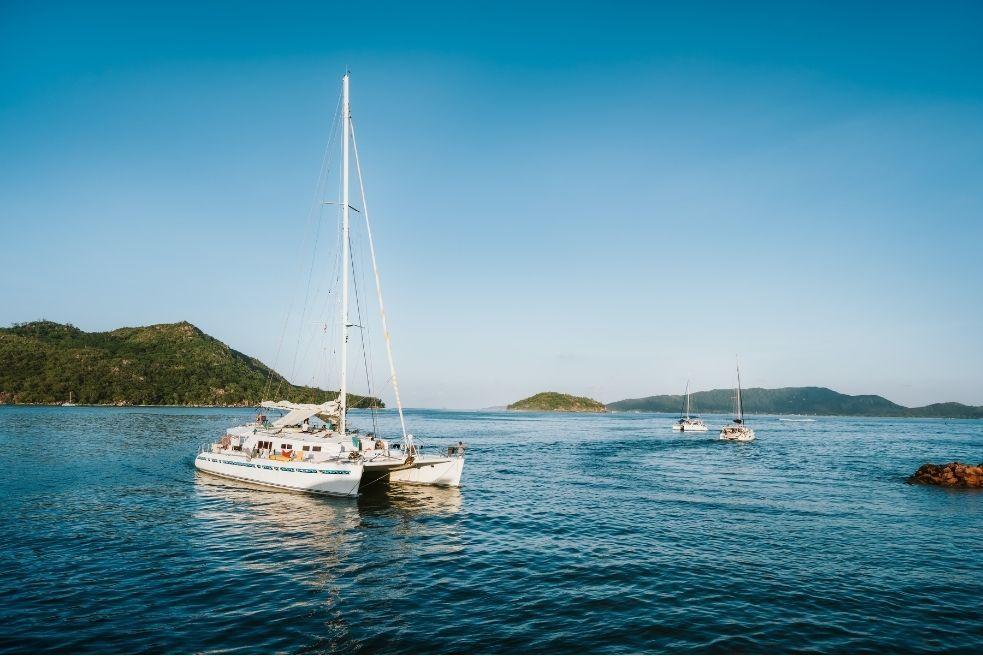
Find Out the Lagoon 42 Catamaran Top Speed
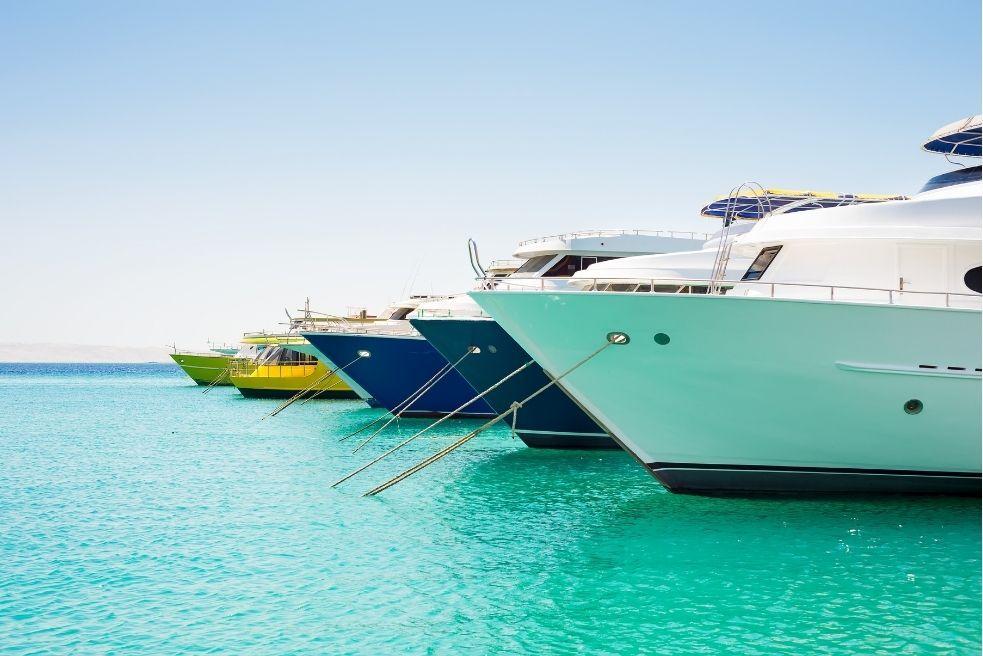
Best Small Boat for Ocean Crossing and Sailing
Sep 16, 2021
Call Us (561) 445-5664
Catamaran vs. Monohulls: Pros and Cons
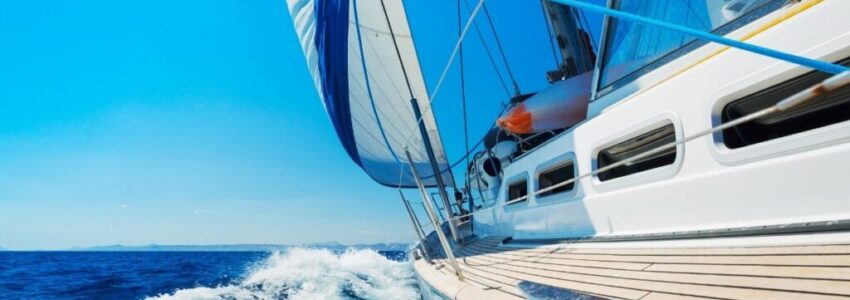
Published Aug 30, 2021
Going on a trip but don’t know what boat to use? If you have been eyeing Catamaran and Monohull boats, you are in the right place. If you can’t choose between the two, knowing their pros and cons should help you decide. In this article, we will be battling catamaran vs. monohulls to determine which one is more suitable for you.
What is Catamaran?
A catamaran is a sailboat with multihulls that features two parallel hulls of equal size. This type of boat has been popular ever since because of its stability and size. In addition, vacationers tend to sail with catamaran boats because of their space above and below.
What are Monohulls?
Unlike catamaran boats, a monohull is a boat that comes with only one hull. Monohull boats are the most widely used form of waterborne vessel. Sailing in a monohull may satisfy a person’s inner sailor self and give them the whole sailing experience. In addition, this type of boat is cheaper than other boats since it only caters to one hull.
Since catamaran and monohulls are completely different boats, we should compare and contrast their characteristics.
Spaciousness
The multihulls of catamarans give the boat additional space for the galley, cockpit, and more rooms when it comes to space. Catamaran boats also feature shallower draft, smaller displacement, and less hull volume than monohull boats. Therefore, this boat is more spacious than a monohull boat. It should be what you’re looking for if you’re sailing with family or friends.
On the other hand, monohull boats provide limited space, and most spaces are below the waterline. This might be concerning, especially for non-sailors, like vacationers. However, long-time sailors are most likely used to this situation. In addition, a monohull is smaller than most catamarans since it only consists of one hull.
Stability and Comfort
Another advantage of having multi-hulls is inheriting more stability than a one-hull boat. Catamarans are less prone to rocking and heeling, which makes them an ideal boat for family vacations. Large families usually include kids or seniors that get out of balance easily. Sailing in a catamaran boat would surely be more comfortable for you. Catamaran also features a separated skipper cabin that separates the crew and boat guests. Some larger skipper cabins provide full equipment like an isolated shower, sink, and toilet. In catamaran boats, you can sunbathe, lounge, or even jump on a trampoline while onboard.
Monohull boats are obviously less stable than multi-hull catamarans. From the word “mono,” monohulls only have one hull, which makes it prone to being rocky than a multihull boat. A rocking boat might not be an ideal vacation boat for families.
Here are the advantages and disadvantages of sailing for both boats:
Catamaran boats are often faster than monohulls when sailing downwind, reaches, and broad. Moreover, they have low bridge decks likely to slap on the undercarriage when the boat is sailing upwind. That is what slows the speed of the catamaran boats.
Monohulls sail through water without any slapping or pounding that may slow down the boat. They tend to be faster than catamaran boats when going upwind since the slapping slows down the multihull.
Pounding and slapping
Multihulls are made so that guests and sailors can get the most out of their vacation. That is why producers of catamarans try their best to add as much platform in the boat as the low bridge deck. Unfortunately, the low bridge deck of a catamaran tends to pound and slap the undercarriage of the boat, especially when sailing upwind. Some people find the pounding and slapping sound annoying.
Monohulls don’t have a low bridge deck, so sailing comes smoothly for monohull boats. Monohull guests wouldn’t have a problem with the noise at all.
Maneuvering and docking
Multihulls are powered by two engines. Having two engines can be extremely helpful when it comes to an emergency. These engines make it possible for the boat to rotate to a full 360 degrees. Catamarans also have two rudders which makes it easier to dock the boat.
Monohulls are easier to maneuver because of their size. However, the monohull only consists of one engine for the whole boat. The engine of the monohull can be combined with a front bow thruster so the yacht/boat can move sideways, which is helpful for tight spaces. This function makes it easier for the sailor to dock the boat.
Catamaran boats are more expensive than most monohulls because of their features. They are known as a high-quality boat that reassures sailor’s guests that it’s safer than most boats and costs a lot of building materials as catamaran boats are more spacious. Catamaran boats may cost more because it’s a high demand boat. The cost for docking for this type of boat also costs double the price of a monohull since it’s bigger.
Monohulls usually cost cheaper than most catamaran boats because of the monohull’s building materials. Multihull boats typically need to double the building materials required for a catamaran. Therefore, monohull boats with the same sleeping capacity and equipment as the catamaran may cost cheaper than buying a catamaran.

Catamaran vs. Monohulls: What to Choose?
Catamarans are more expensive, but it’s a family vacation-friendly boat that offers a lot of advantages. On the other hand, monohull boats are cheaper, simpler, and perfect for aspiring sailors. In the end, it all comes down to the person’s preference, budget, and what suits their needs. So I will ask you, catamaran vs. monohulls? (Related: What to Know Before Renting a Catamaran Charter )
Experience Yacht Charters With Seafari In Boca Raton Florida
Looking for a great time on the water in Boca Raton Florida? Seafari Yacht Charters is number choice for yacht rentals in Boca Raton . Book our yachts for parties , exciting day trips to the Bahamas, romantic yacht dinner cruises , and much more. Come experience all South Florida has to offer with us.
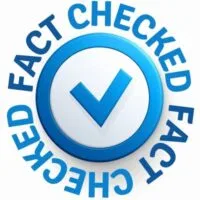
Fact Checked By Experts
Our team of internal experts has conducted rigorous fact-checking on this content. Explore the editorial standard for our website to dive deeper into our commitment to excellence.

About The Author
Krizzia Paolyn has a bachelors degree in Psychology and a passion for yachting in South Florida. She has a desire to be heard and to encourage others to make their voices heard as well.
Related Posts
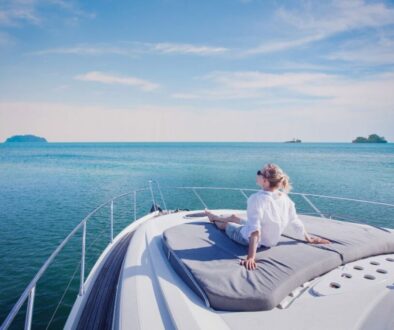
Yachting Benefits You Might Not Know
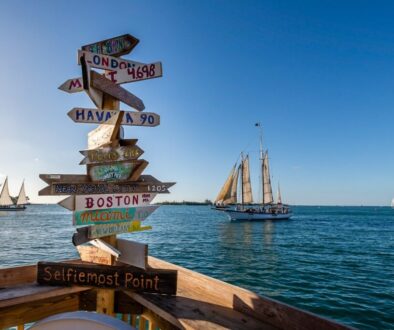
Most Popular , Yachting
How To Charter A Boat From Miami To Key West
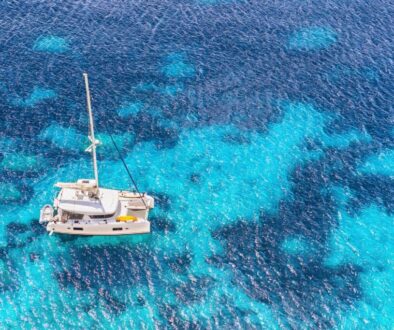
What To Know Before Renting A Catamaran Charter
Find us on social media.

© SeafariYachtCharters.com 2024
View Our Privacy Policy
Website design by Correct Digital
- TripAdvisor
- Testimonials
Join Our Newsletter

- Whitsundays
- How It Works
- International Destinations
- Sabbatical Charter
- Provisioning
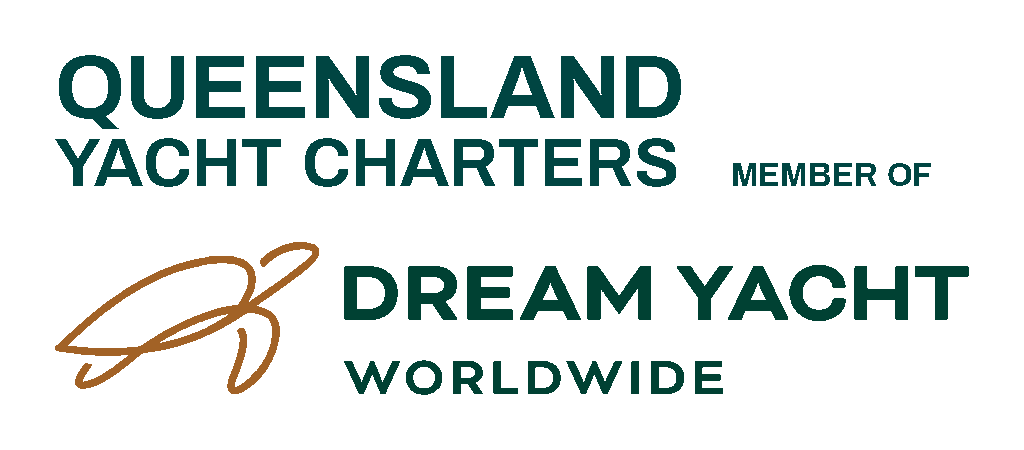
Catamaran Vs. Monohull – How to Choose?
Search blog posts, blog categories, pros & cons of hiring a catamaran or monohull for your whitsunday yacht charter.
Some dyed-in-the-wool purists have been known to demonstrate a little “sailing snobbery” from time to time. Putting sailing snobbery aside … if planning a sailing vacation and you aren’t sure whether you want a catamaran or a monohull , you need to weigh the pros and cons of each to see what makes more sense for your purposes. Personally, I quite like both … for different reasons!
Catamaran Pros
- One of the major advantages of a catamaran versus a monohull is their inherent stability. A monohull simply can’t be compared to a cat in this regard.
- Stability is a big plus for families with young children or seniors who are not particularly steady on their feet. Because the boat is not as susceptible to the effects of wave action and does not heal the way a monohull does, it is much easier to walk around on deck and within the interior of the yacht while underway.
- Anyone who may be prone to seasickness will feel the effects of motion much less aboard a cat than they might on a mono. The added stability on a cat makes the cook’s job a lot less challenging both while underway and at anchor. Catamarans don’t rock and roll the way monohulls do.
More Bonus Points for Cats…
- Catamarans generally provide far more living space in the main salon, galley and cockpit, than the space found aboard similarly priced monohulls. Their cabins are often more spacious too and even the smallest cat in the fleet has stand up headroom in each cabin.
- Because of the layout, there is usually more privacy on a cat than on a mono and if you have children aboard, there is greater separation from the main living space and the cabins, making it easier for the kids to fall asleep at a reasonable hour.
- The shallow draft of a cat allows you to anchor in shallower water which means you can be closer to the beach than almost all monohulls.
- Many of the newer catamarans have raised or flybridge helms. No monohull can beat the visibility from the helm provided on most modern catamarans.
- The galley, main salon and cockpit are all on one level, above the water line … making life aboard as well as your view much more enjoyable.
- Because the majority of living space is above the waterline, you get much better flow through ventilation on a cat making the need for air conditioning somewhat less important during the daylight hours.
- In almost all cases, you do not have to race around stowing things or using bungee cords to keep things in place, the moment you decide to set sail. Most things stay put even in moderately rough seas.
- Because catamarans don’t have a big heavy keel loaded with lead, even if you hole the boat, it will float. Production cats have so much buoyancy built in that they are next to impossible to sink.
- Cats are usually pretty easy to dock because you have two motors and two rudders. No need for a bow thruster.
- Most catamarans can turn 360 degrees within their own length. No monohull I know of can do that.
- Catamarans are usually faster than monohulls, particularly on downwind runs, reaches and broad reaches. It’s less tiring to sail a catamaran than it is to sail a monohull. Sailing flat has definite advantages.
- If you are into SCUBA diving, carrying tanks and all the assorted equipment is much easier on a cat. It’s also a lot easier in many cases to board a cat on the sugar scoops than it is on many monohulls. Although many modern monohulls do have huge swim platforms that raise and lower electronically … so in that case, it’s a wash.
- I have yet to see a monohull with a trampoline for sunbathing or lounging in the moonlight, while stargazing … with your sweetheart by your side! How much more romantic does it get than that? 🙂
Catamaran Cons
- Because a wide bridge deck is strapped between two hulls, there can be slapping or pounding while underway in heavier seas. The slapping can become annoying, but is easily resolved by reducing sail. Unfortunately, that means reducing speed as well.
- You won’t get the same amount of feedback from the wheel of a cat as from a monohull. This means you must be vigilant in rough seas and high winds and know when to reduce sail. The last thing you want to have happen is to find yourself surfing down a wave, burying the bows and pitch polling. Having said that, pitch polling a cruising cat would take some doing … Cruising catamarans don’t really heal, so the feeling of “sailing” is quite different from that aboard a monohull. Note: I’m not convinced this is really a con … but I am trying to dig up as many cons as I possibly can.
- Cats take double the space to dock and often cost double to dock too.
- Cats can’t sail as close to the wind as a monohull … but, most sail faster than a monohull on a reach, so if you fall off a few degrees and sail fast, you can usually get to the same place at the same time and sometimes faster, even though you will have to cover more ground.
- Tacking a catamaran is not the same as tacking a monohull. You have to have sufficient speed to carry you through a tack without losing too much forward momentum. Square foot for square foot, a catamaran is much lighter than a monohull and for that reason, they slow down much more quickly. You basically carve through the tack rather than making a sharp directional turn as you would in a monohull. If concerned about tacking, in light winds or heavily trafficked areas, turn on the motor as an assist to get you through the tack or douse the sails altogether. You’re on vacation! Why sweat it?
- Catamarans with similar sleeping capacity and equipment are usually (but not always) more expensive to charter than monohulls.

Queensland Yacht Charter’s is a member of Dream Yacht Charter the Number One Charter Company Worldwide with a reputation for excellence in providing the best in Yacht Charter’s.
We offer the ultimate in destination sailing with over 1000 yachts in 50 stunning locations from the pink sands of the Caribbean to Europe’s thousands of Islands and including our magnificent 74 Whitsunday Islands here in our own backyard.
Choose from our Whitsunday Fleet for the ultimate Whitsunday Yacht Charter or if you are dreaming of somewhere further afield choose a Bareboat , Skippered or By the Cabin Charter in our International Locations.
Want to go even further for Longer? Enquire about our long term Sabbatical Charter .
07 4946 7400
Unit 9/shingley drive airlie beach qld 4802, reservations, enquire now.
- First Name *
- Last Name *
- Departure Date * DD slash MM slash YYYY
- Hidden Departure Date *
- Hidden Inactive - Return Date
- Nights (min 5) * Nights (min 5) 5 6 7 8 9 10 11 12 13 14 14+
- Where would you like to sail? * Where would you like to sail? The Whitsundays Abaco Annapolis (Chesapeake Bay) Antigua Balearic Islands (Spain) Bali Brazil British Virgin Islands Corsica Cote D'Azur (French Riviera) Croatia Fort Lauderdale French Polynesia Greece Grenada Guadeloupe La Paz (Mexico) Malaysia Maldives Martinique Mauritius New Caledonia Port Hamble Seychelles St. Martin Thailand Turkey
- What type of boat? * Boat Type Monohull Catamaran Power Not Sure
- Number of Guests * Number of Guests 2 3 4 5 6 7 8 9 10 11 12
- Sign up to our newsletter
- Email This field is for validation purposes and should be left unchanged.


IMAGES
VIDEO
COMMENTS
Upwind sailing performance: While catamarans have the edge at straight-line speed, monohulls sail closer to the wind. When you're racing or you have to sail upwind to get to the next island, this can get you there faster. Sailing feel and responsiveness: The "feel" of sailing a monohull is much better.With a single hull, you'll feel wind pressure and trim adjustments immediately for a ...
The final answer will depend on a number of factors, including: experience, crew, budget and the destination. There are pros and cons to both catamarans and monohulls so here's what to consider and how to maneuver them both like a pro. Your Experience And Familiarity. Managing a catamaran is not like driving a monohull in both good and bad ways.
Compared square-foot-for-square-foot, catamarans are much lighter than monohulls, which means they also slow down a lot quicker. For the most part, catamarans are easier to dock than monohulls, as they have two motors and two rudders which simplify things a lot. This also does away with the need for a bow thruster.
ADVANTAGES OF A CATAMARAN. 1. Speed Equals Safety. The speed of a catamaran makes it possible to outrun bad weather. While catamarans do not point as high into the wind as a monohull (or if it does, it makes more leeway or slides sideways), it is about 20% faster than a monohull.
The question of whether to choose a monohull vessel or a catamaran is an eternal dispute between boat lovers. These arguments are usually based on one's preferences and philosophy. In fact, the popularity of catamarans has grown significantly since their design facilitates many aspects of sailing. But, both mono-hulls and multi-hulls have their advantages and disadvantages. So, in this ...
Discover the pros and cons of each sailboat type to find your perfect vessel for cruising, comfort, and performance. In the world of sailing, few debates are as passionate and enduring as the catamaran vs monohull showdown. As we sail into 2024, this discussion continues to evolve, shaped by advancing technology and changing sailor preferences. ...
Catamaran vs. Monohull, Pros and Cons. Depending on a variety of factors, there are plenty of catamaran and monohull pros and cons. These are some to keep in mind when comparing the two boat types. Catamaran pros • Comfort. On a cruising designed catamaran, two hulls with a wide beam create a stable and comfortable living environment with ...
When it comes to catamaran vs. monohull, there are two schools of thought that always prompt impassioned debates as to which one is much better. If you've used both a catamaran (a boat with two hulls) and a monohull (a boat with one hull), you know that they both have pros and cons.
Notice that I don't say "pros" and "cons" when considering the differences between the two vessels. To some, the gentle rocking of the monohull elicits nostalgia for a bygone youth spent sailing dinghies in the bay. To others, it represents sleepless nights, banging kitchenware, and angry spouses. Short Summary - Catamaran vs Monohull
Speed. In the catamaran vs monohull speed debate, it might be more of a draw. Catamarans are typically 25-30% faster than a comparable monohull, but some argue that it comes at a price. When catamarans are sailing full speed you might experience a lot of slapping from the waves. Monohulls are designed to cut through the water.
Monohulls have a single hull, and catamarans have two hulls side-by-side. Catamarans are faster than monohulls of the same length and displacement, but monohulls are stronger and more spacious. Monohulls are also cheaper and easier to build than multi-hulls. In this article, we'll cover the differences between catamarans and monohulls, along ...
Which is better, a catamaran or a monohull? The cat vs monohull debate is as old as boats. Spoiler: there is a given sailing yacht for every need. +1 (415) 619 2704. Home; Destinations. BVI; ... In breaking down the pros and cons of monohulls and catamarans, we found that a pro for one was a con for another. With that in mind, we think it is ...
Part 2 right here: https://youtu.be/05E-Qv6BVfgA debate as old as time itself! Which is better, a catamaran or a monohull? I'll give away the answer here: l...
Recreation In a Monohull vs. a Catamaran. Most sailors agree that sailing a monohull boat is much more exhilarating than sailing a catamaran. Traditional sailboats heel, and sailors get instant feedback while they're sailing. For the most part, catamarans stay stable, and you don't get the same feeling with the movement of the wind and the ...
With catamarans vastly popular in the charter industry, and showing no sign of abating, let's compare the pros and cons of monohull and catamaran strictly on the charter work point of view. The reason why this distinction is important - and I write this as a monohull fanatic myself - is because for charter companies, catamarans are in huge demand due to the overwhelming number of advantages ...
The cost of buying, mooring and maintaining a catamaran is significantly higher than that of a monohull. There isn't enough headroom for people over 6ft tall in most cats under 40ft. If capsized, it won't right itself. Underway, the motion is jerky. Catamarans are more weight sensitive.
A catamaran will heel only 5 to 10 degrees, which is a lot less than a monohull boat. This makes it easier to do certain activities such as cooking, and it provides a more comfortable experience for all onboard overall. A cat is the perfect type of boat for socializing with others. They are fast.
When selecting a fishing boat, anglers face a significant choice that can impact their experience on the water. The type of boat you choose - be it a catamaran or a traditional monohull - plays a pivotal role in defining your fishing adventures. Both catamaran and monohull boats have distinct features and advantages, and understanding these differences is key to finding a vessel that aligns ...
Catamaran boats also feature shallower draft, smaller displacement, and less hull volume than monohull boats. Therefore, this boat is more spacious than a monohull boat. It should be what you're looking for if you're sailing with family or friends. On the other hand, monohull boats provide limited space, and most spaces are below the waterline.
Pros & Cons of hiring a Catamaran or Monohull for your Whitsunday Yacht Charter Some dyed-in-the-wool purists have been known to demonstrate a little "sailing snobbery" from time to time. Putting sailing snobbery aside … if planning a sailing vacation and you aren't sure whether you want a catamaran or a monohull , you need to weigh the ...